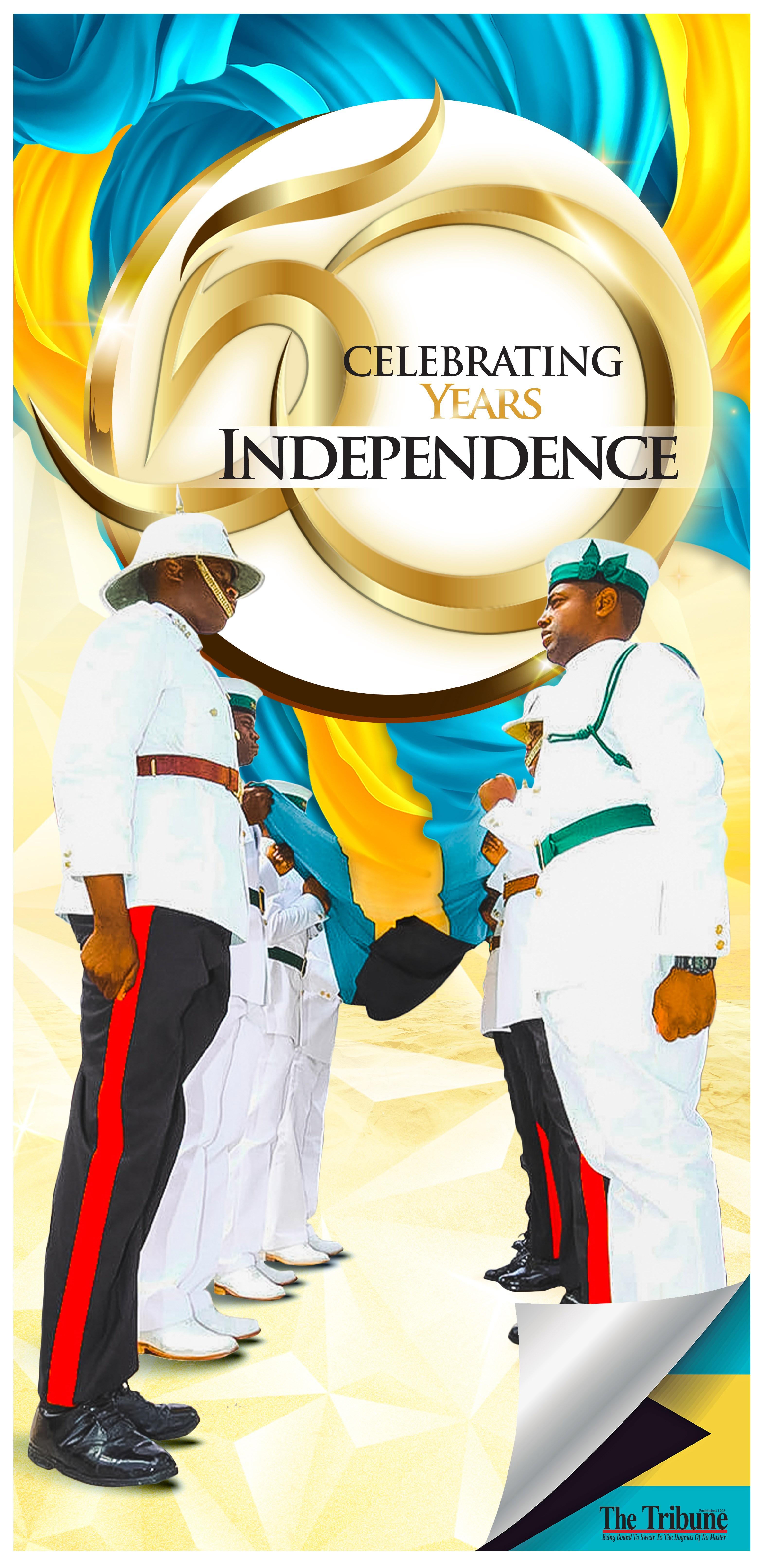
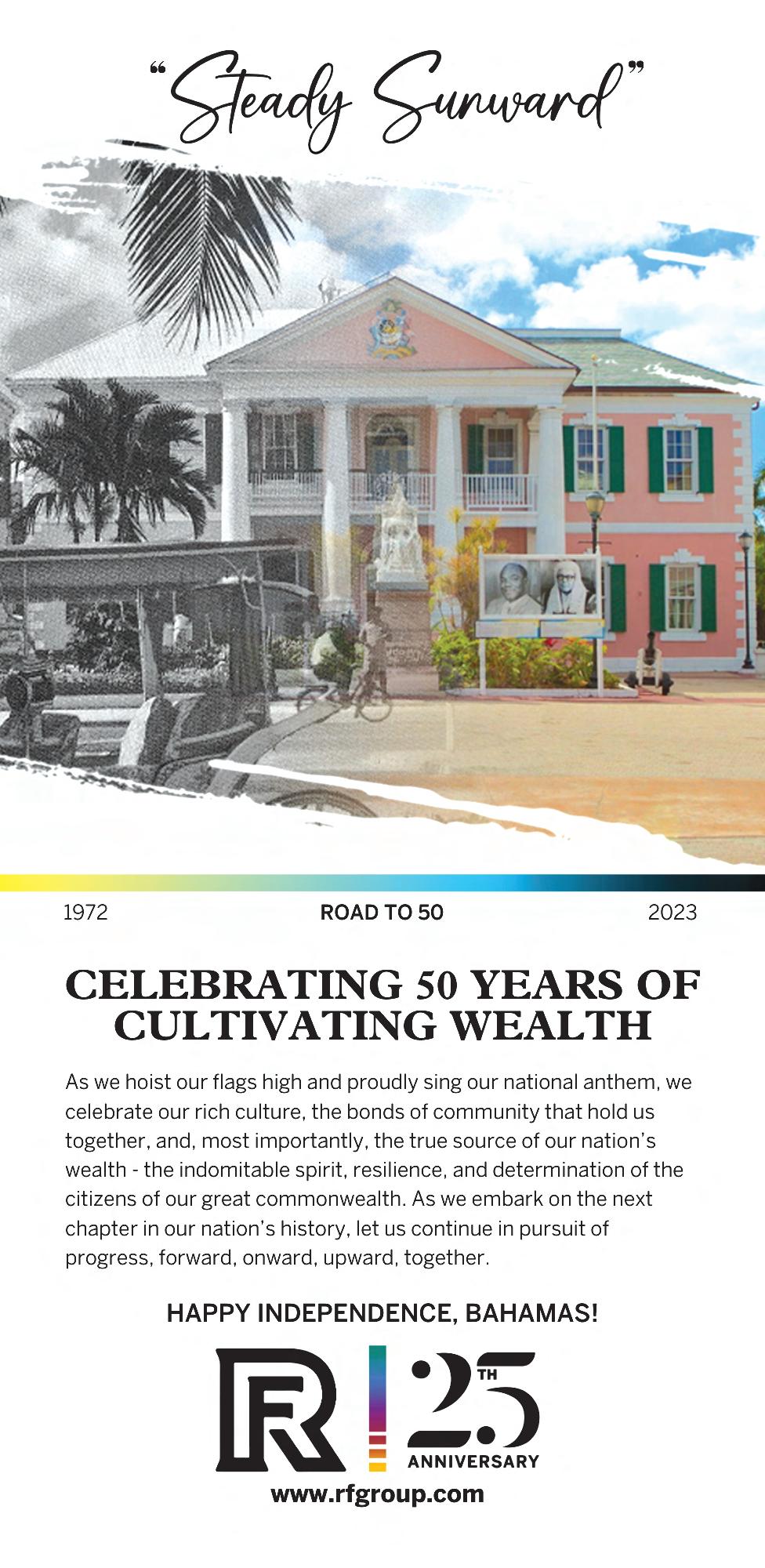









I AM humbled by the privilege of leading this great nation on the momentous occasion of our 50th Independence Day, our Golden Jubilee.
Throughout the year, we are reflecting on the challenges we have overcome since 1973, the challenges that still lie ahead, and the best path forward, so that together we can continue building a country with opportunity and security for all Bahamians.
Throughout the years, Bahamians have transformed obstacles into opportunities. Our journey is a testament to the strength, talent, and determination of our people.
Education remains the cornerstone of our commitment to deliver on the promise of Independence to empower the Bahamian people.
Education has helped thousands of Bahamians rise to their full potential –and is more important than ever to ensure that young Bahamians have the tools
they will need to thrive in a fast-changing world. Lifelong learning must also be a key focus, as we recognise the importance of continuous personal and professional development. Our economy has grown substantially since we became a self-governing nation in 1973, as we have worked to encourage investment and economic growth. Bahamians are now thriving in a wide range of fields, and our entrepreneurial spirit and accomplishments are rightly a source of great pride. An important focus for the current era is to create diverse new ownership opportunities for Bahamians, so that our economy is truly inclusive.
Sports have served as a unifying force, igniting national pride and showcasing the exceptional talent of our athletes on the global stage.
From the achievements of our Olympians to the camaraderie fostered through community sports, we recognise the transformative power of sports in shaping character, instilling
discipline, and fostering national identity.
Sometimes the best way forward requires learning from the past. Recent events, including the pandemic and the global inflation crisis, have underscored the need to prioritise food security, so that we once again grow more of what we eat here at home. Through sustainable practices, we are embracing innovation to maximise the potential of our agricultural sector while preserving the integrity of our environment.
During a time in which many democracies across the world have experienced setbacks or reversals, we continue to be a free country, one in which citizens and a free press debate national issues with great vigor and intensity.
We must never take our rights for granted, and in the coming years, digital literacy must be a new area of focus, so that misinformation and disinformation are not able to obscure the truth.
Our families and our faith are the heartbeat of
our society, central to our values and traditions. We believe in the dignity of every Bahamian child, and recognise that loving family members and spiritual communities can together have a profound influence in promoting character and resilience.
My fellow Bahamians, we are the children and grandchildren of the men and
women who marched and fought for our freedom. We remember their vision and their courage with admiration, and gratitude.
When they marched for independence, they were also marching for opportunity, and justice.
Now it is up to us to continue their fight; we fight on behalf of the same values and people, even as we face
more modern challenges. Together, we shall continue to build a stronger, more vibrant Bahamas, where opportunities abound, and the dreams of every Bahamian can become a reality. Happy Independence Day, and may our nation continue in God’s grace to flourish for generations to come.

ON BEHALF of the Free National Movement,
I extend congratulations to all citizens of The Bahamas on the momentous occasion of our 50th Anniversary of Independence. This milestone is a testament to the strength, resilience, and indomitable spirit of our people.
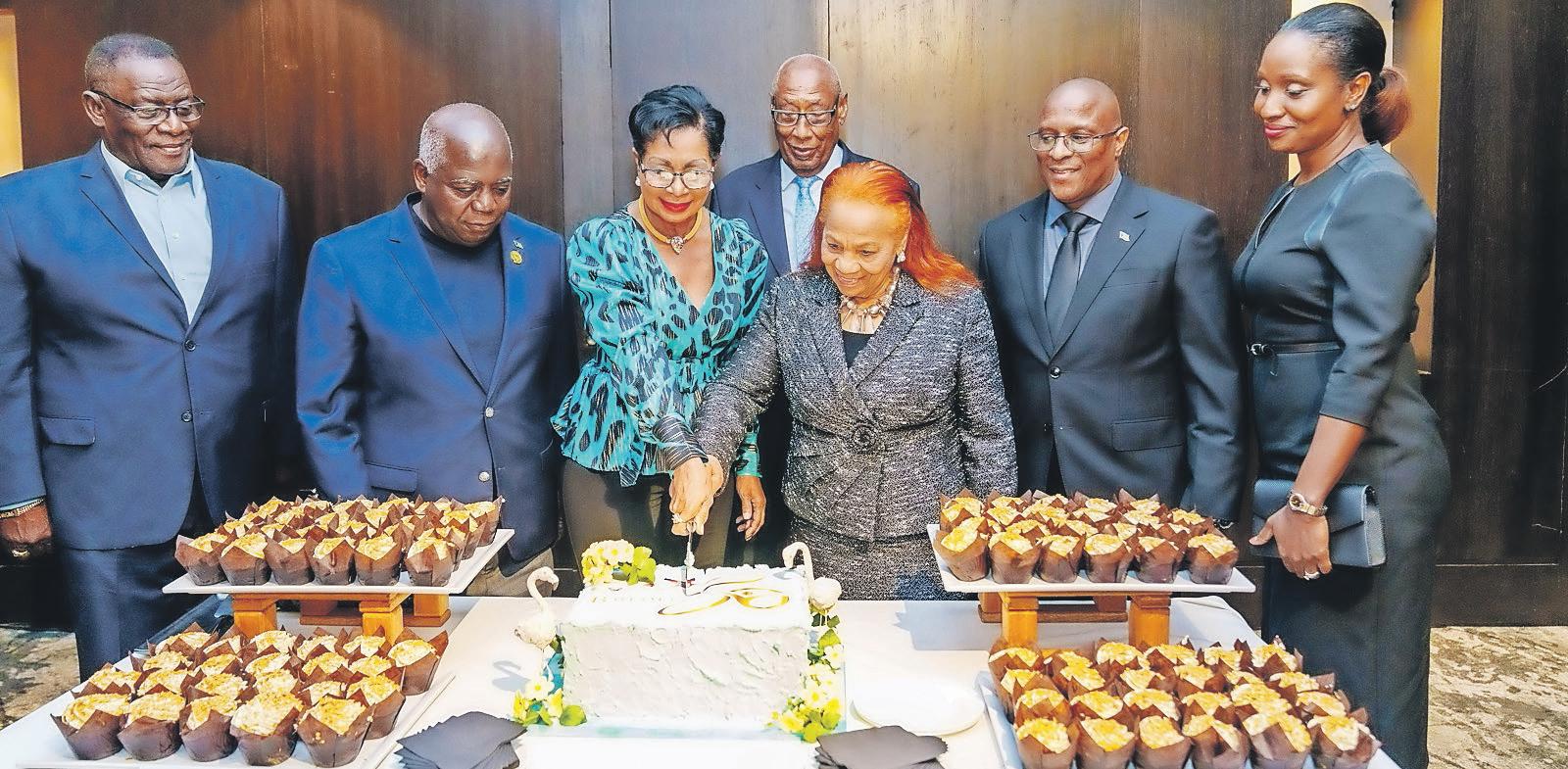
Over the past five decades, The Bahamas has achieved remarkable progress in various fields establishing us as a vibrant and thriving nation. We have shown the world that we are far more than our beautiful water, stunning beaches, and life-giving sunshine. We are a significant voice advocating for smallisland developing states. We have lent our humanity to the fight against racism and gender bias. Our artists and artisans have been the glue that
holds our national identity together. We have created a rich heritage along with a captivating and dynamic culture. Our sounds, rhythms, beautiful creation, and exquisite cuisines have all tantalised the global community making us a must-experience destination.
Despite our small population, we have an admirable reputation and undeniable presence on the global sports circuit in sailing, athletics, basketball, and numerous other sporting disciplines. We punch well above our weight. Our financial services sector has produced world-class entrepreneurs, eminently qualified accountants, economists, and compliance officers.
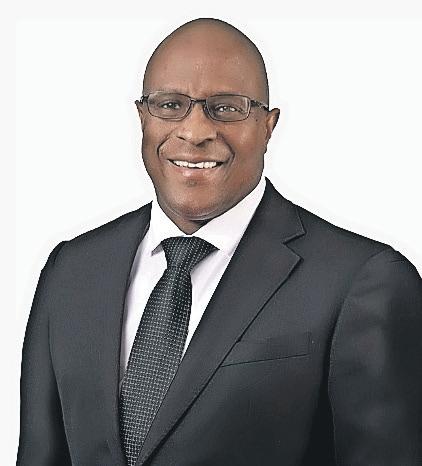
There are few areas of national life where we haven’t demonstrated exceptionalism. So much so, that many countries are in awe of our ocean
of talent. When we were tested by literal and figurative storms, our resolve was unshaken. We have come this far because of our faith in God, the ingenuity of our people, and the adaptability of our sons and daughters at home and abroad.
There are no challenges ahead that our collective efforts and genius cannot help us overcome; there are no opportunities that our perseverance cannot help us to achieve. We are eternally optimistic about the next 50 years God will bless us with, and the successes our industry, national integrity, and hard work will earn.
The Free National Movement remains dedicated to serving the interests of all Bahamians, and together, we will continue to march forward, united in love and service.
Happy 50th Independence Anniversary, Bahamas!

Rule. He died in office on January 22, 1979. A bust of him still stands in Rawson’s Square.
appointed to the Senate, the first to be a
government minister, and the first to be elected president of the Senate. Before that, she was crucial to the women’s suffragist movement in The Bahamas, helping women secure the right to vote. Her tenure as Senate president lasted six years. Her legacy will resonate for ages to come.
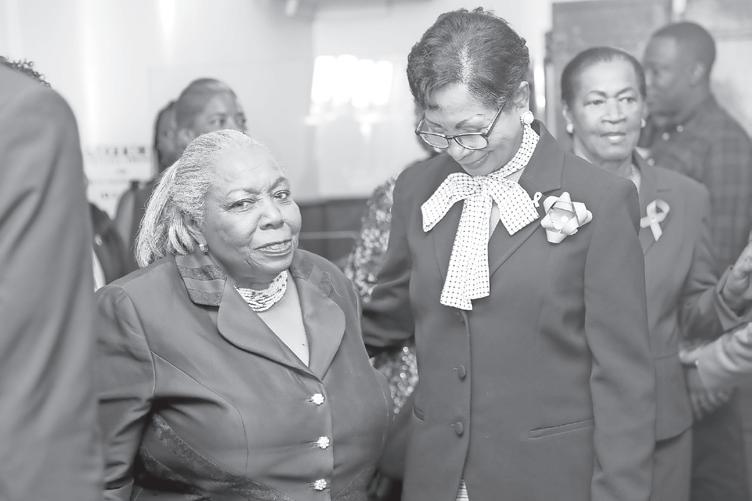
Establishing trusted institutions is critical for newly independent nations. When the Central Bank of The Bahamas Act, 1974, was passed, it gave the bank full scope to administer monetary policy in the country, a function it has done without much controversy since 1974. Many of the preceding Bahamas Monetary Authority functions were incorporated into the Central Bank, along with new powers like credit control. What’s more, the bank has produced bank notes, tangible representations of the country’s history and aspirations.
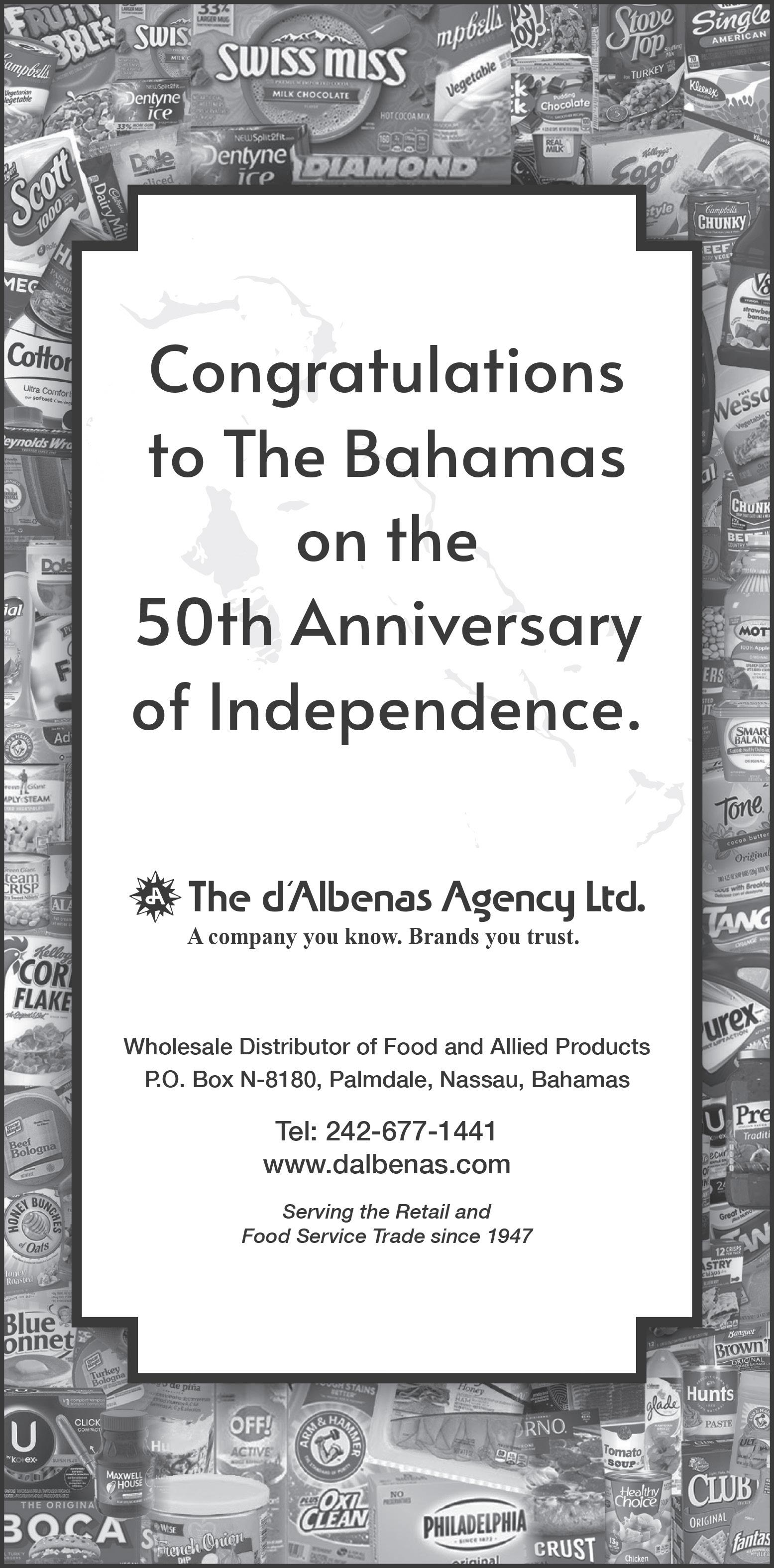
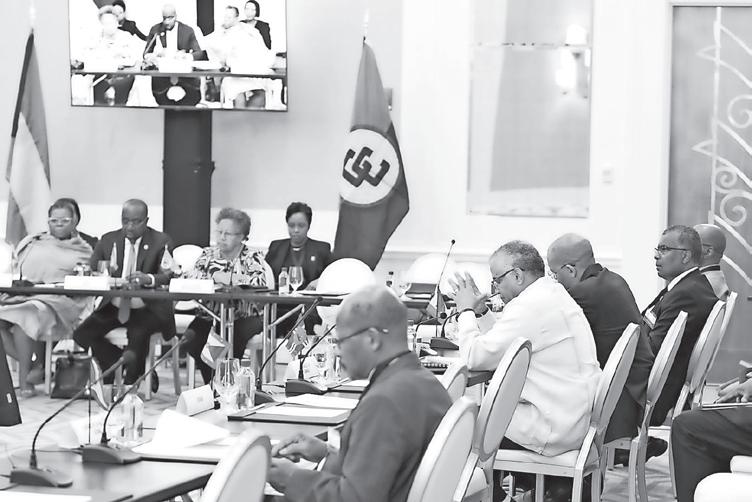
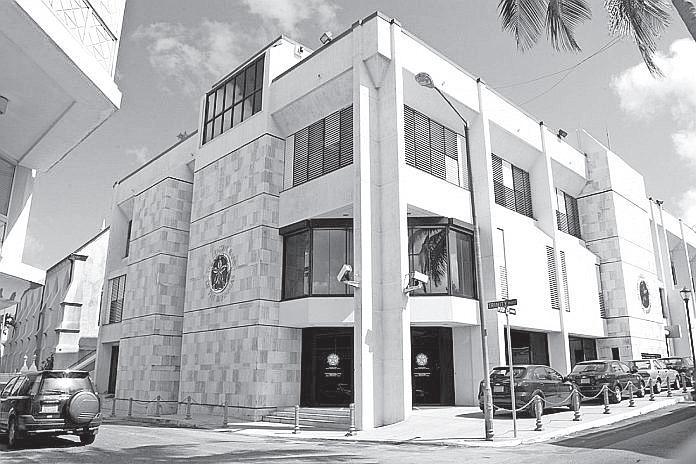
Soon after independence, The Bahamas addressed the need to defend its territorial integrity and sovereignty by forming the defence force, a military organisation mandated to help in times of disaster, assist with search and rescue, and maintain order. In 2023, the force had as many as 1600 marines and officers.
Sir Milo Butler was known for his fiery, uncompromising speeches in the House of Assembly and his gentle giant demeanour. People remember him for his actions on April 27, 1965, Black Tuesday. After Sir Lynden Pindling threw the speaker’s mace out a House of Assembly window, symbolising that power belonged to the people, Sir Milo also threw the speaker’s hourglass. He was appointed the first Bahamian governor general for his nation-building efforts and for helping The Bahamas achieve Majority
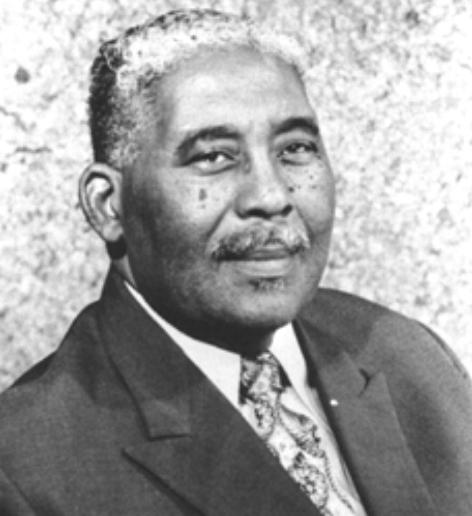
Bahamian women remain underrepresented in Bahamian politics, which makes Doris Johnson’s achievements all the more impressive. She was a woman of firsts: the first to run for elected office, the first
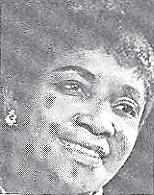
Although legislation establishing NIB was passed in 1972, the organisation officially opened two years later. Since then, it has been the cornerstone of the country’s social safety net, supporting thousands seeking help related to sickness, maternity, funerals, retirement, invalidity, unemployment and death.
The sinking of the HMBS Flamingo was significant, if tragic, to developing the Bahamian national identity. The Royal Bahamas Defence Force was only six weeks old when the 19-member crew of the Flamingo encountered Cuban poachers near the Ragged Island chain. The subsequent attack killed Able Seaman Fenrick Sturrup, 21, Marine Seaman Austin Rudolph Smith, 21, Marine Seaman David Allison Tucker, 21, and Marine Seaman Edward Arnold Williams.

In “Islanders in the Stream: A History of the Bahamian People,” historians Gail Saunders and Michael Craton said the incident was a national rite of passage. “It was a fortunately minor example of the blood baptism said to be necessary to formulate the national consciousness of all emergent nations, for the first time giving the Bahamian people an inkling of their unique police in the world and what was needed to defend it,” they wrote.

The University of The Bahamas Act was passed in 2016, a moment envisioned almost as soon as the college was founded in 1974. That elevation followed incremental improvements to facilities and a gradual increase in faculty with postgraduate qualifications. The institution has bestowed degrees on more than 15,000 people, proving an irreplaceable pipeline for residents seeking success without studying abroad.

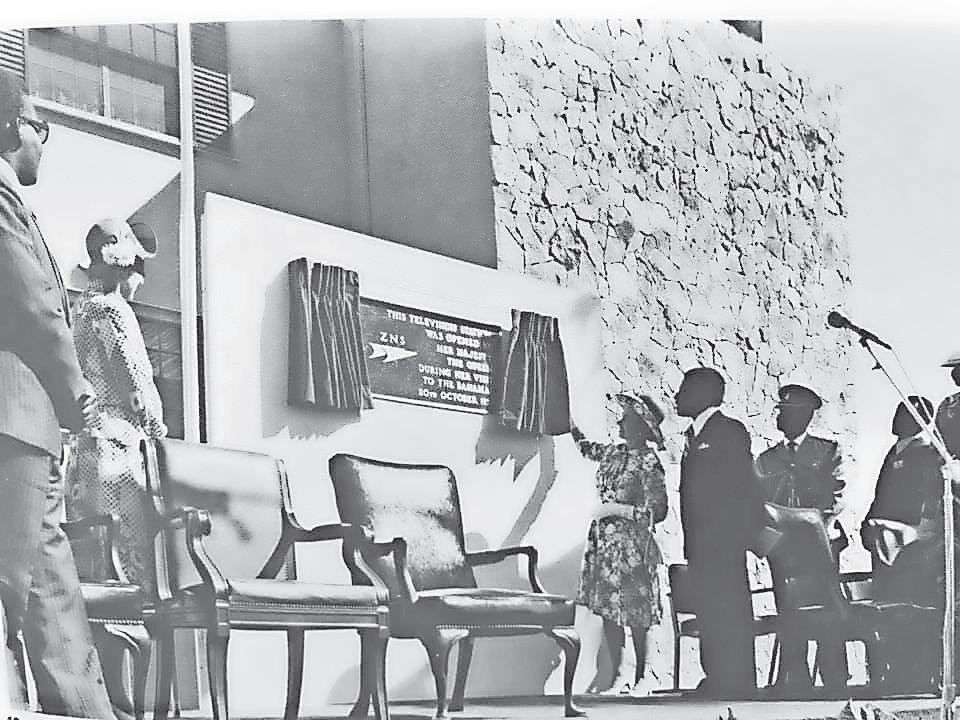
Queen Elizabeth II opened the network in October 1977. Clint Watson, general manager of ZNS in 2023, said the network launch was critical for the young nation.
“For a new country to talk about its affairs and to document its achievements and accomplishments, you needed television to capture the moment, to capture the events so that history could be recorded. A lot of what we are documenting today is because
As a member of the Free National Movement, Janet Bostwick was the first woman elected to the House of Assembly, the first to serve as acting prime minister and the first to be attorney general. Women politicians across political parties have been inspired by her example ever since.
Joining CARICOM helped The Bahamas strengthen its identity as a member of the Caribbean community. The country has since rejected participation in a single market and economy and has not embraced the Caribbean Court of Justice. Still, inclusion in CARICOM led to memorable moments, including visits in 2023 from the prime minister of Canada and the United States vice president.
In December 1984, the Royal Commission of Inquiry released a report on drugs in The Bahamas that linked Prime Minister Sir Lynden Pindling to the drug trade. The report found that the drug trade had impacted “almost all strata of Bahamian society,” contributing to rising crime and social ills. International media called The Bahamas a “nation for sale.” Ed Moxey, a former MP, told The Tribune in 2014 that a floundering economy made the country susceptible to the ambitions of drug lords. “There were drug colonies in Andros, in Exuma, in Guana Cay and Norman’s Cay. Everyone knew what was going on, and it touched everyone. Even Sir Lynden knew, and he turned a blind eye to it,” he said.


After 25 years in office, the Progressive Liberal Party’s grip on power loosened amid high unemployment. The
In 1985, The Bahamas hosted the Commonwealth Heads of Government Meeting (CHOGM). The event cemented The Bahamas’ contribution to ending apartheid in South Africa and the eventual release of anti-apartheid activist Nelson Mandela from prison. As prime minister, Sir Lynden Pindling chaired CHOGM 85, which resulted in the passage of the Nassau Accord. The Accord called for the dismantling of apartheid, the release of Nelson Mandela and other anti-apartheid activists from prison, and a series of economic measures against South Africa. Nelson Mandela was released from prison in 1990, and apartheid formally ended in 1994. A short time after his release from prison, Nelson Mandela came to The Bahamas to thank Sir Lynden Pindling for his efforts as chair of the commonwealth in 1985”. In 2016, former High Commissioner Eldred “Ed” Bethel said: “The Nassau Accord broke the back of the minority government in South Africa.
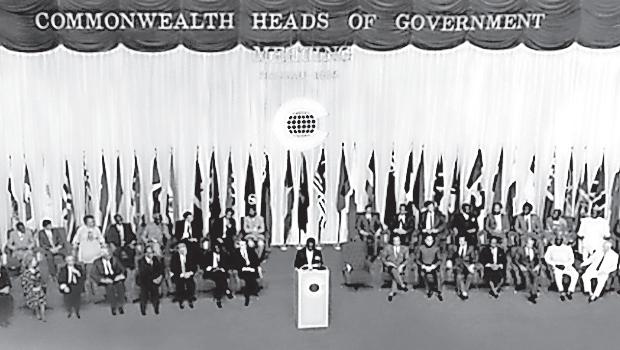
Hurricane Andrew, the first named hurricane of the 1992 hurricane season, made landfall in The Bahamas on August 23 1992, wreaking havoc on several islands. The category five storm killed four people, left 1700 residents homeless and caused $250 million in infrastructural damages. Eleuthera, New Providence, Bimini, Andros and the Berry islands experienced hurricane-force winds. The Berry Islands and North Eleuthera received the brunt of the storm, with reported storm surges of twenty-five feet in the Current and sixteen feet in Lower Bogue. The control tower at the airport in Governor’s Harbour was completely destroyed, along with roads, docks, schools and hotels.
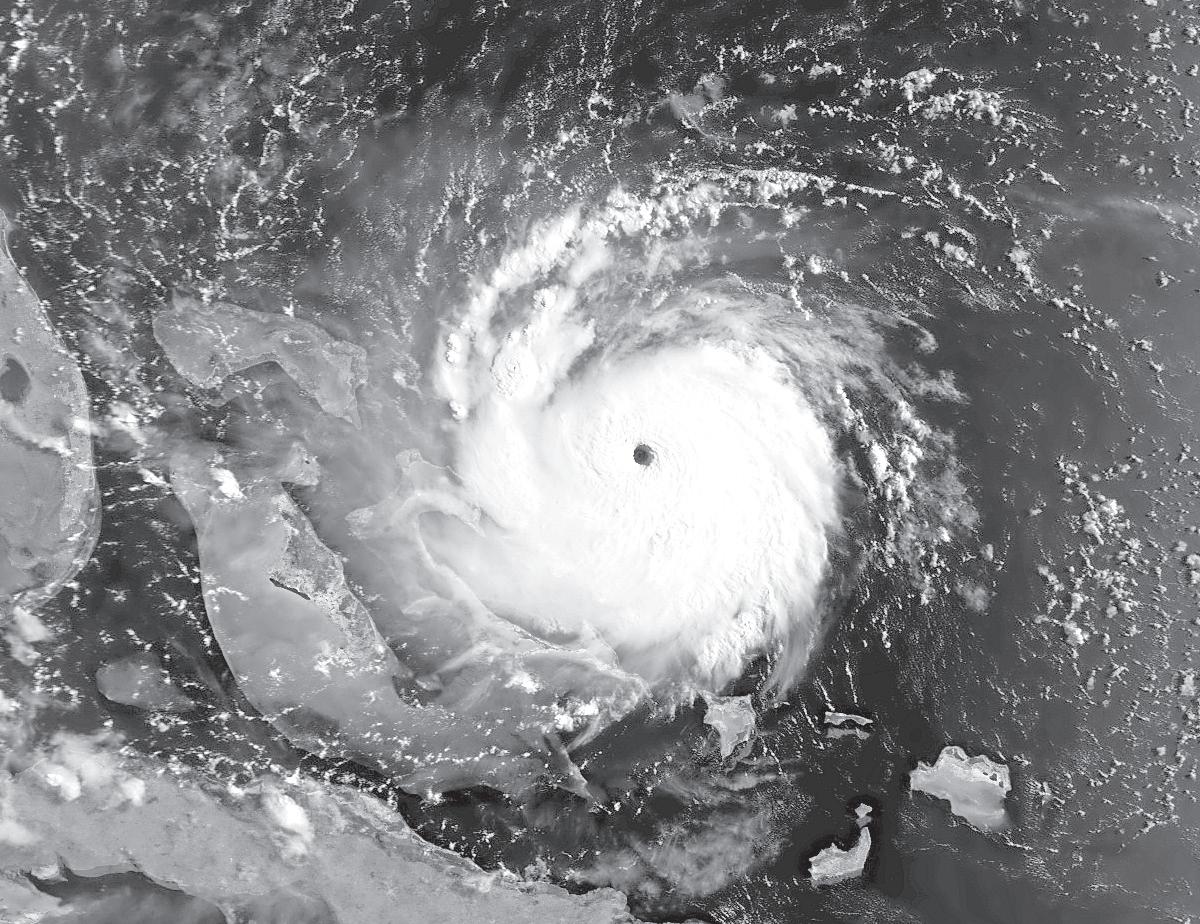
In 1992, the Ingraham administration passed a law opening the airwaves to all who wanted private licenses. The following year, Prime Minister Ingraham provided three radio stations with licenses, ending ZNS’ monopoly. These decisions’ impact on creating new opportunities for expression and entrepreneurship stands among the FNM’s proudest achievements.

The International Persons Landholding (IPL) Act, 1993 came into force on January 1 1994, replacing the Immovable Properties Act. This allowed foreign nationals to acquire land without obtaining approval from the National Economic Council. The IPL Act was designed to increase foreign investment and strengthen the local real estate market, especially the second home and vacation home markets.
The drug era of the 1980s and the scandals surrounding Prime Minister Pindling were the backdrop to the 1987 election. Despite this, the Progressive Liberal Party won 31 of 49 seats.
In a historic first for The Bahamas, Frank Rutherford won an Olympic medal in track and field while competing in the 1992 Olympic Games in Barcelona, Spain. His bronze medal in the Triple Jump made him the first among several talented athletes to make their mark on the world stage in solo competitions, including Pauline Davis-Thompson, Tonique Williams-Darling, Shaunae Miller-Uibo and Steven Gardiner. In the summer of 2022, Mr Rutherford was honoured with a new subdivision named after him. “The world is out there for you to conquer,” he told younger athletes.
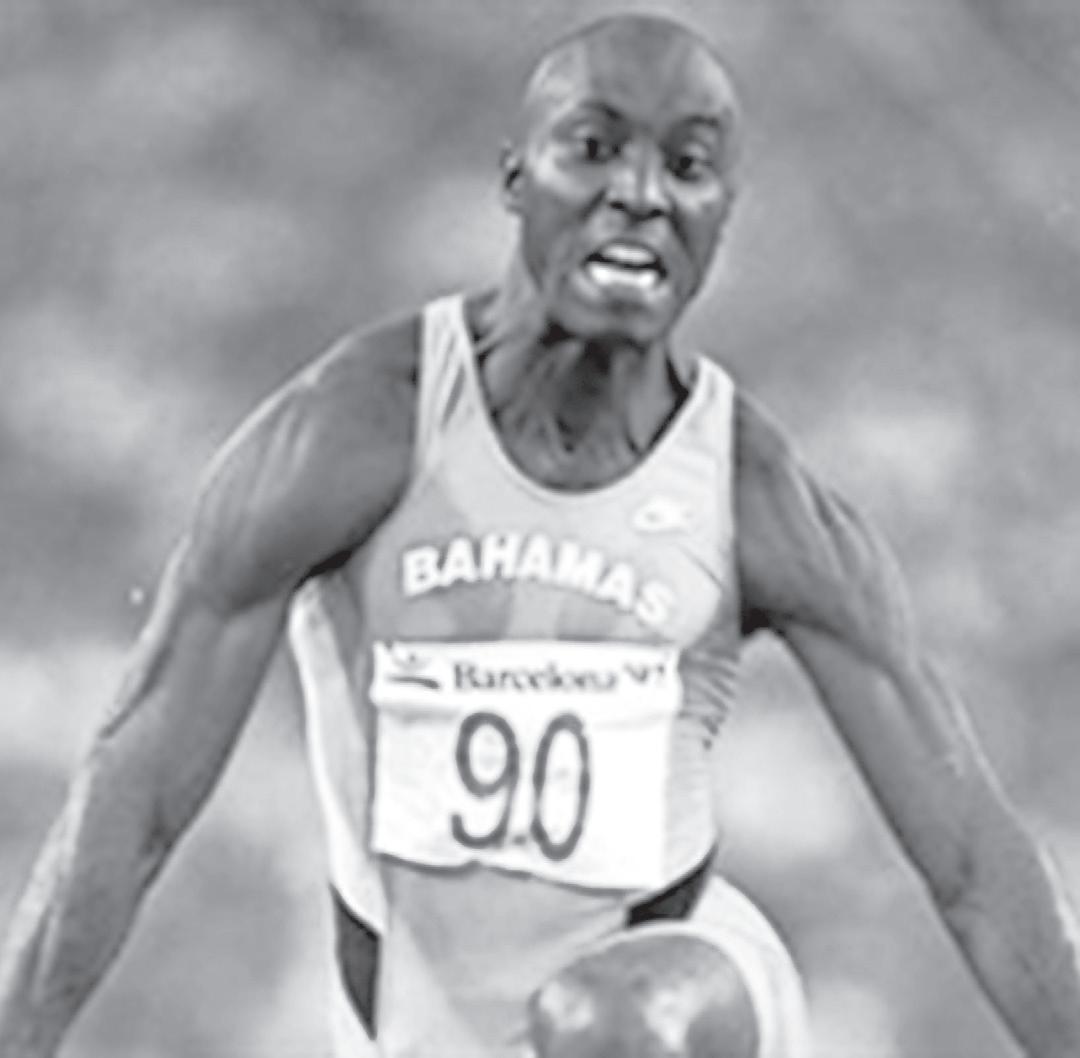
In 1992, Dr Perry Gomez, head of the Infectious Diseases Unit at Princess Margaret Hospital, “warned the new government that the worldwide AIDS epidemic seemed out of control,” according to Gail Saunders and Michael Craton in “Islanders In The Stream: A History of the Bahamian People.” Nearly 5,500 people have died from AIDS in The Bahamas since 1985. The early 90s marked a growing realisation among residents that AIDS was more than a gay disease.

The world-famous Atlantis Resort and Casino on Paradise Island has stood as one of the crown jewels of the Bahamian tourist industry since it first opened its doors. Today, it is the largest private sector employer in The Bahamas and draws thousands of tourists annually. Its history goes back to when it was first opened as the Paradise Island Hotel and Casino in 1968. When Sol Kerzner purchased the property in 1994, he redeveloped it into what it is known today.
The Bahamas Local Government Act was passed in 1996, allowing local government to exist everywhere except New Providence. The legislation empowered district councils to help communities with necessities like the provision of potable water. In the following years, critics complained the system did not devolve power enough, but it remains a key element of Family Island life.

The results of the 1997 election were a remarkable vote of confidence in the Free National Movement and its leader, Hubert Ingraham. It remains one of the most lopsided elections in Bahamian history. The FNM won 34 of 40 seats. The results pushed Sir Lynden into retirement.
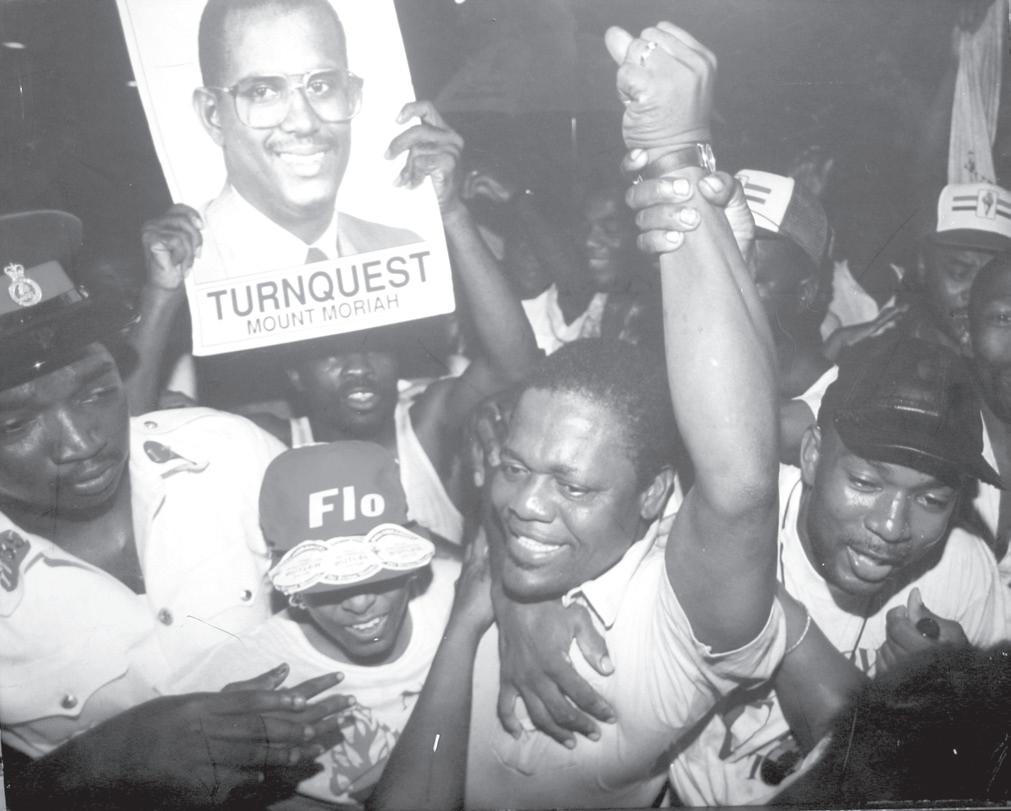
Gulf Union Bank, one of the country’s largest financial institutions at the time, had its license suspended by the Ministry of Finance in October 1997. It was placed into liquidation by the Supreme Court in December of that year because of liquidity problems and the bank’s inability to fulfil its requirements mandated by the Central Bank. The bank was accused of shoddy practices, including granting large loans without following standard lending procedures. Many borrowers were unable or unwilling to repay credit. A policy directive was established in 2000 that required all trust companies and banks operating in The Bahamas to have a physical presence in the country to obtain a Central Bank license.
On January 6, 2000, 27-year-old David Mitchell faced the gallows –– the last time a Bahamian had done so. In 1994, he killed two German nationals sleeping in their Treasure Cay home. After his death, more than 300 people turned out for his burial, some crying, others cheering. The execution drew outrage from Amnesty International. Although the death penalty remained popular among Bahamians, the Privy Council established standards that made it unlikely a court could uphold
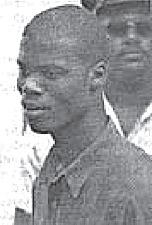
the punishment. A Privy Council ruling declared the mandatory death penalty unconstitutional in 2006.
Many trace the decline in the country’s financial sector to the Financial Action Task Force’s (FATF) blacklisting of the country as a potential haven for money laundering in 2000. The Bahamas was one of the initial countries to receive such a designation. The Ingraham administration passed a suite of legislation to address compliance weaknesses despite criticism from the Progressive Liberal Party.
At the Sydney Games, four Bahamian women set out to prove themselves to non-believers. Pauline Davis-Thompson, Debbie Ferguson-Mckenzie, Chandra Sturrup and Eldece Clark-Lewis had won gold in the 4x100 relay at the IAAF World Championships in 1999, but their opponents still underestimated them. In a moment that aroused intense national pride among Bahamians, the Golden Girls backed up their world championship victory with the first gold The Bahamas ever won in track and field at an Olympics game. More than a decade later, the men would shine too, with a quartet claiming gold in the 4X400m relay.
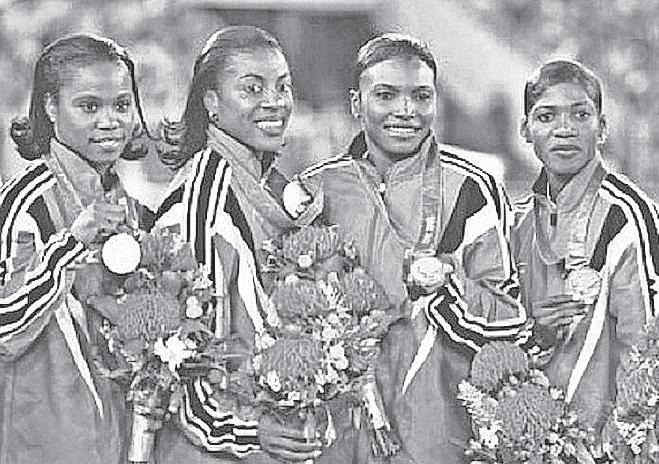
The passing of Sir Lynden Pindling on August 26, 2000, shook the country. Hailed as the “Black Moses” of the Bahamian people, Sir Lynden was renowned for his charisma and common touch. Under
his leadership, the black middle class grew and educational opportunities for Bahamians were greatly expanded.
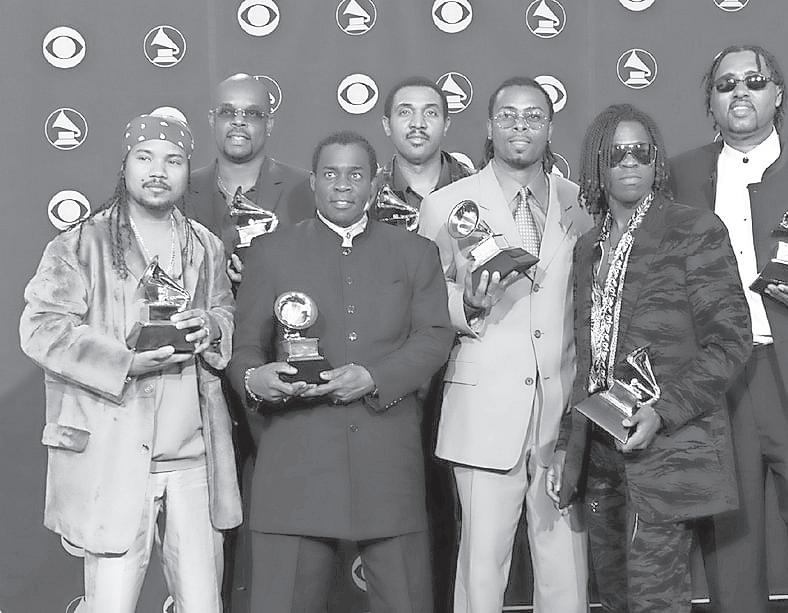
Baha Men’s Grammy award for the inescapable “Who Let the Dogs Out” was the first time a Bahamian won the prestigious award. The group took home the gramophone for Best Dance Recording, beating out superstars like Jennifer Lopez and Enrique Iglesias.
The 2002 Bahamas general election was held on May 2, 2002. The Progressive Liberal Party (PLP) led by Perry Christie won 29 of 40 seats, defeating the governing Free National Movement (FNM), which Orville “Tommy” Turnquest led.

A mainstay of the Bay Street area for decades, the Straw Market burned down in 2001. The market had been home to over 500 straw vendors. In the following years, straw vendors operated under a massive tent structure until a new building was opened in 2010.
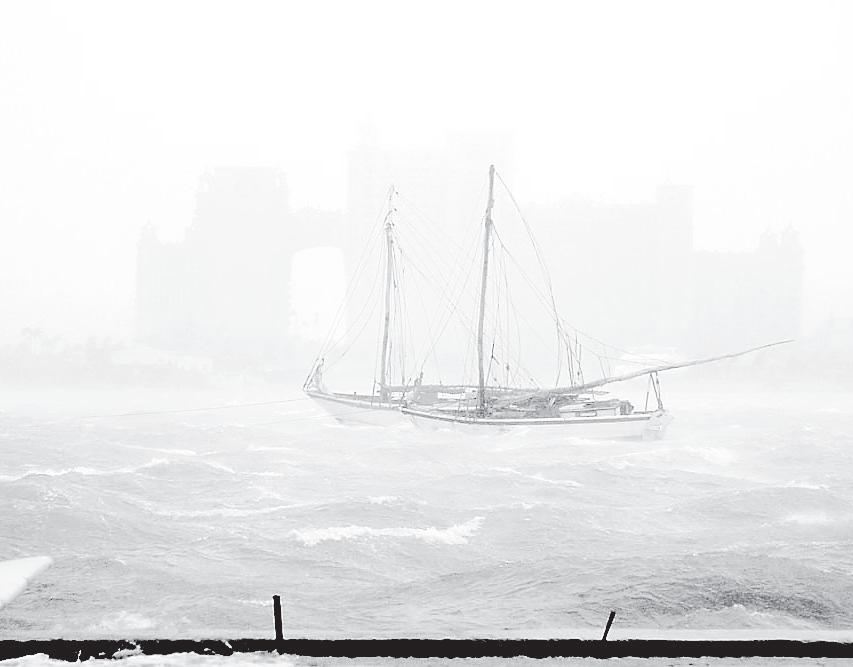

The two category three hurricanes which hit Abaco and Freeport just three weeks apart, produced outcomes that hastened Freeport’s decline. The damage led to the closure of the Royal Oasis, a major lifeline in the city. The island’s economy hasn’t recovered since.
When the 2007 Bahamas general election was held on May 2, 2007, the Free National Movement (FNM), with Hubert Ingraham back at the helm, won 23 of 41 seats, one of the closest elections in the country’s history. Although the economy had been strong and investor confidence was high ahead of the election, the many scandals involving the PLP turned voters off.
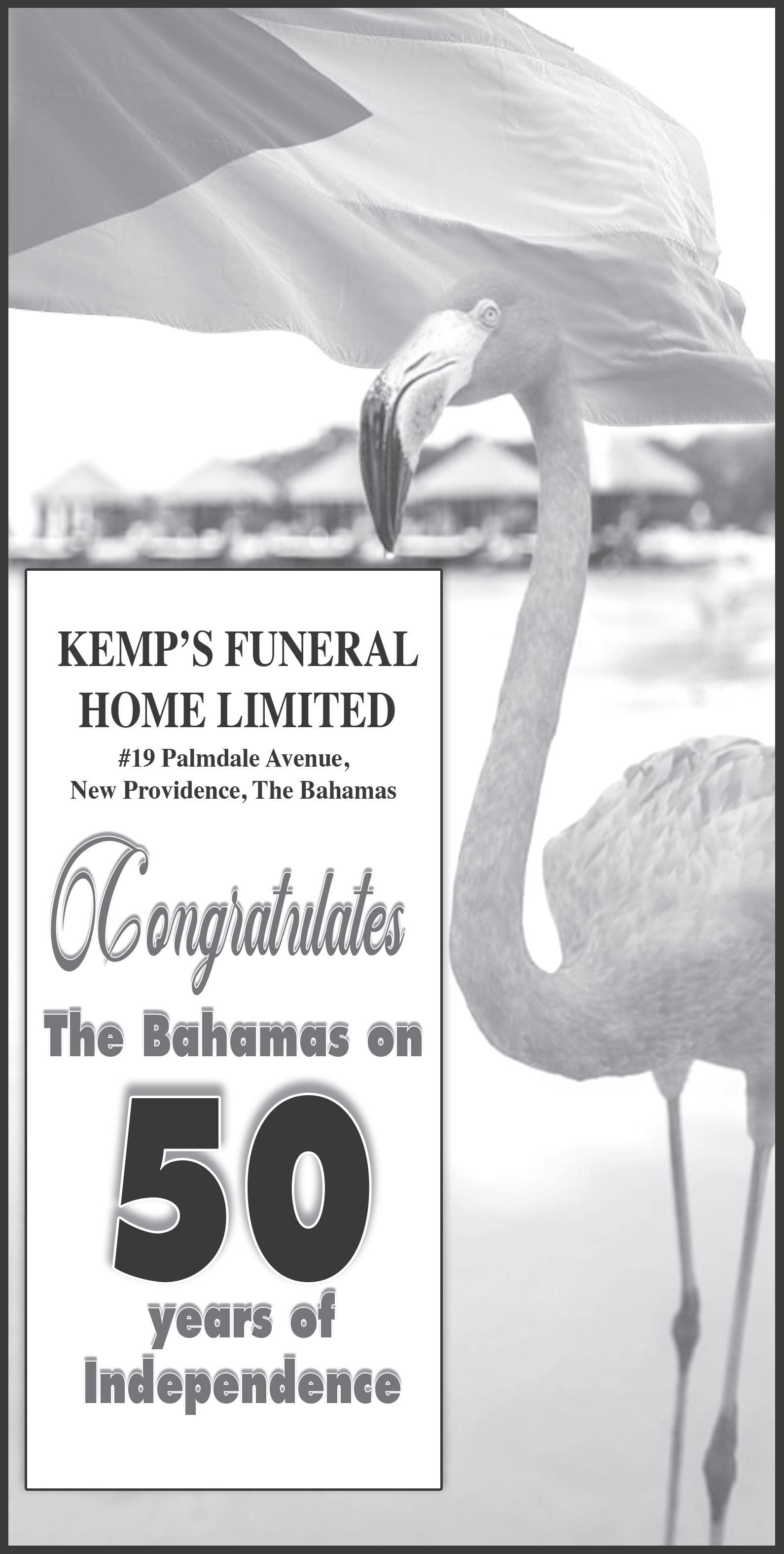
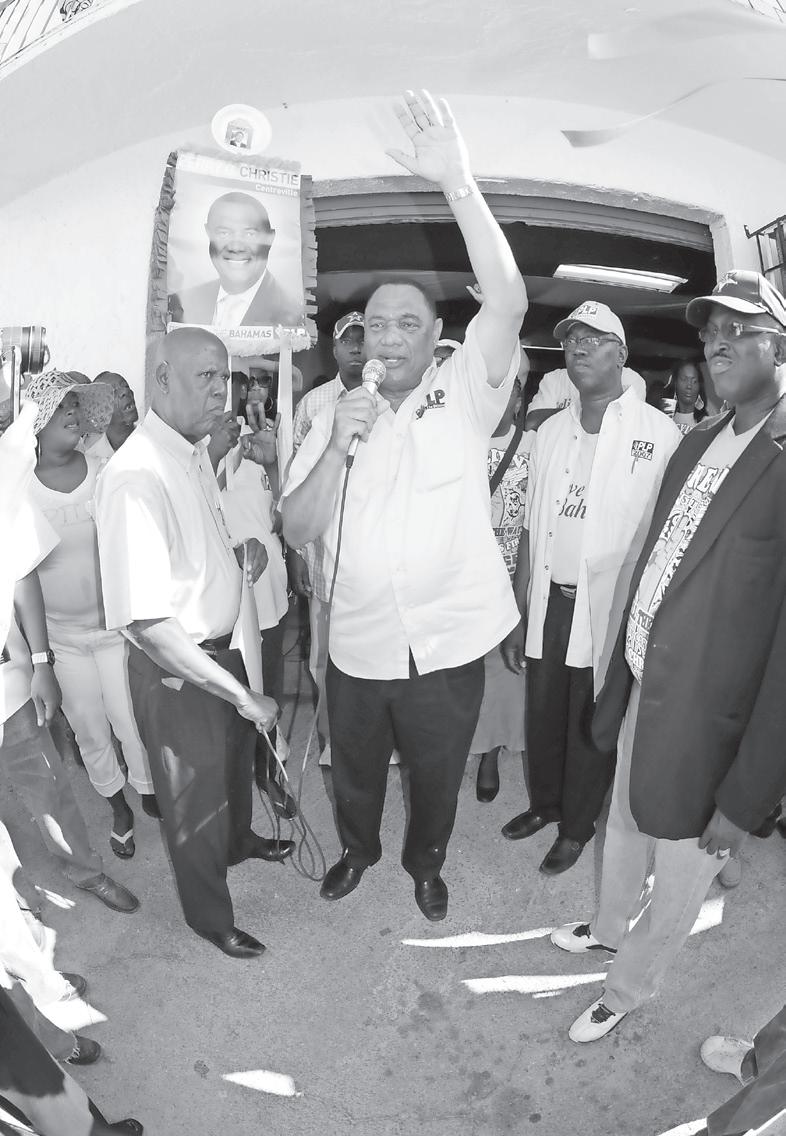
Although the September 11, 2001 attacks on the World Trade Centre and the Pentagon only targeted the United States of America, the consequences were felt by every country in the world. In the attack’s immediate aftermath, travel plunged, hurting the Bahamian economy. In the long term, the attack ended the era of uncomplicated travel. New protocols requiring people to reach airports well before their flights and undergo rigorous security checks became the norm in The Bahamas and everywhere else.

The Ingraham administration sought the public’s approval to amend the constitution to establish an independent electoral boundaries commission and a national commission to monitor the standards of teachers; to increase the retirement age of judges from 60 to 65; to establish an independent parliamentary commissioner and to remove gender discrimination from the constitution. In what was widely interpreted as a rebuke of the Ingraham administration, voters rejected all provisions.
The Great Recession crushed the Bahamian economy and sent unemployment rates soaring into the double digits, where they would remain for over a decade.
After years of wanting to privatise BaTelco, the Free National Movement under the Ingraham administration finally accomplished its goal in 2011 with the sale of 51 per cent of its shares to Cable & Wireless Communications. The deal proved contentious, leading to protests.
By the end of 2011, The Bahamas reached a grim milestone, recording 127 murders, the first time the number of murders was in the triple digits. Although fear of crime had been escalating for years, 2011 signalled the beginning of a new era of high violence.
When the 2012 general election was held on May 7, 2012, the Progressive Liberal Party (PLP) won 29 of 38 seats. The PLP’s victory marked Mr Christie’s second and final term as prime minister. Although Mr Ingraham won the North Abaco seat, he resigned his seat and left frontline politics.
On January 28, 2013, Bahamians rejected proposals to legalise web shops and to establish a national lottery. Religious groups were particularly opposed to the moves, though voter turnout was low. The results marked the second time a governing party failed to get its desired result in a referendum, though then Prime Minister Perry Christie said the poll results would be non-binding.
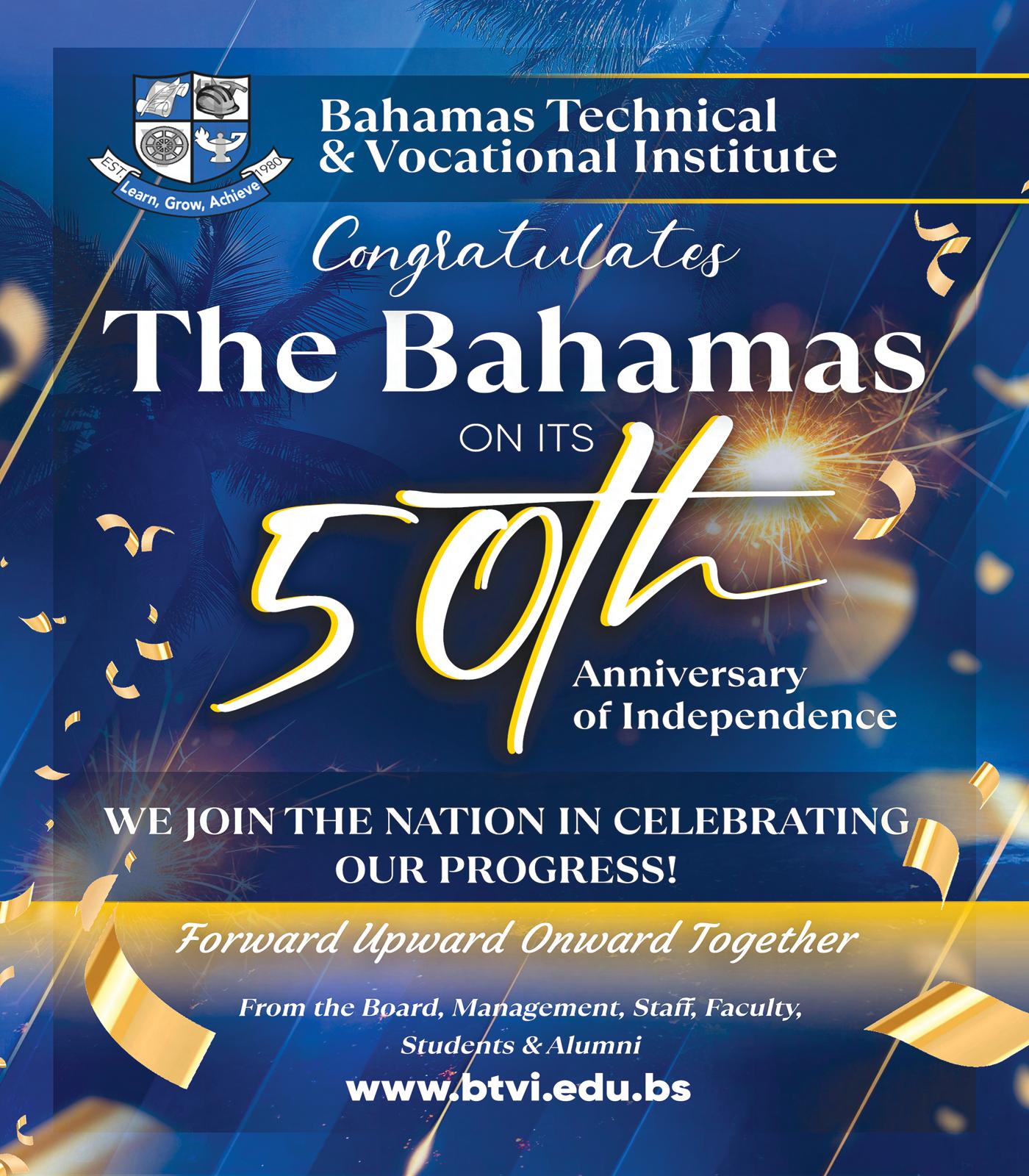
Despite the 2013 gambling referendum results, the Christie administration passed legislation to legalise and regulate web shops. Officials estimated that about $700m of play occurred in the gaming system annually.
For the second time in less than two decades, the governing party sought Bahamians’ approval to amend the constitution to remove discrimination in how citizenship is obtained. For the second time, Bahamians soundly rejected the proposals.

Nine persons onboard an aircraft heading for Grand Bahama died when it crashed shortly before landing on November 9 2014. The victims included the leader of Bahamas Faith Ministries, Dr Myles Munroe, one of the country’s most famous and successful pastors. Mourners flocked to BFM after hearing about the crash. Dr Munroe’s funeral book featured a tribute from then US President Barack Obama, a testament to his impact and far-reaching appeal.
Value Added Tax (VAT) was introduced in The Bahamas in 2015 under the last Davis administration. Its introduction was smooth and free of problems, even though preparations for the tax dominated discourse in 2014. The government argued the new tax was crucial to raise revenue and narrow the national debt.

Baha Mar’s founder and former CEO, Sarkis Izmirlian, filed for Chapter 11 bankruptcy in a Delaware court on June 29 2015, triggering a legal battle that caused tremendous uncertainty about the mega project. Baha Mar initiated the bankruptcy proceedings to protect the firm from its creditors, including EXIM Bank, its financier, and China Construction of America (CCA), the general contractor. The government filed a winding-up action against Baha Mar and its affiliates in July 2015. The Delaware Court ultimately dismissed Baha Mar’s bankruptcy case. Chow Tai Fook purchased Baha Mar from Exim Bank in December 2016. The resort opened the following year to great fanfare. Mr Izmirlian took legal action against China State Construction Engineering Corporation (CSCEC) and CCA.
The Free National Movement returned to power in 2017 with a first-time prime minister: Dr Hubert Minnis. The election, held amid high employment, was among the most lopsided, with the FNM winning 35 of 29 seats. A notable result of the election was the failure of the former prime minister, Perry Christie, to retain his Centerville seat.
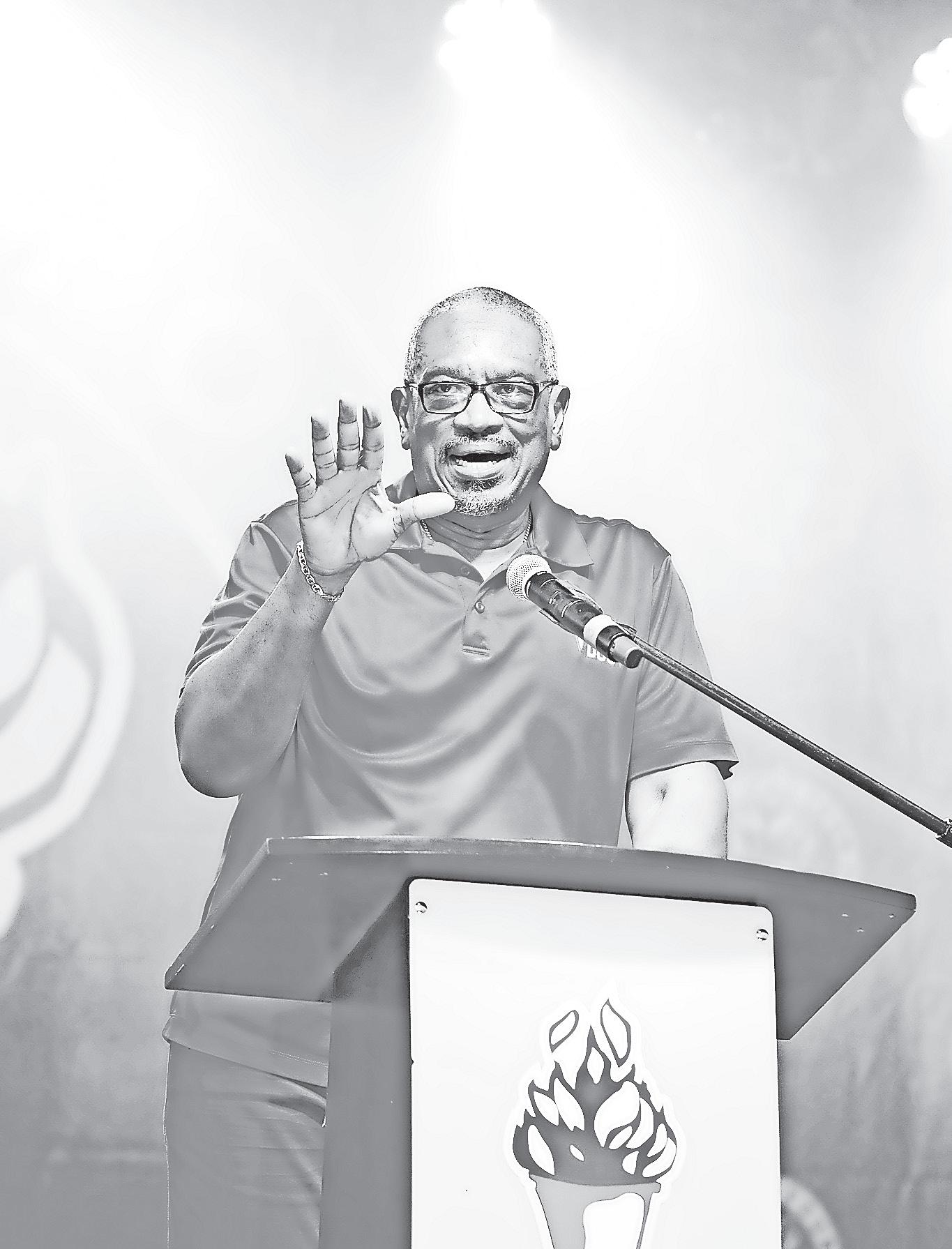
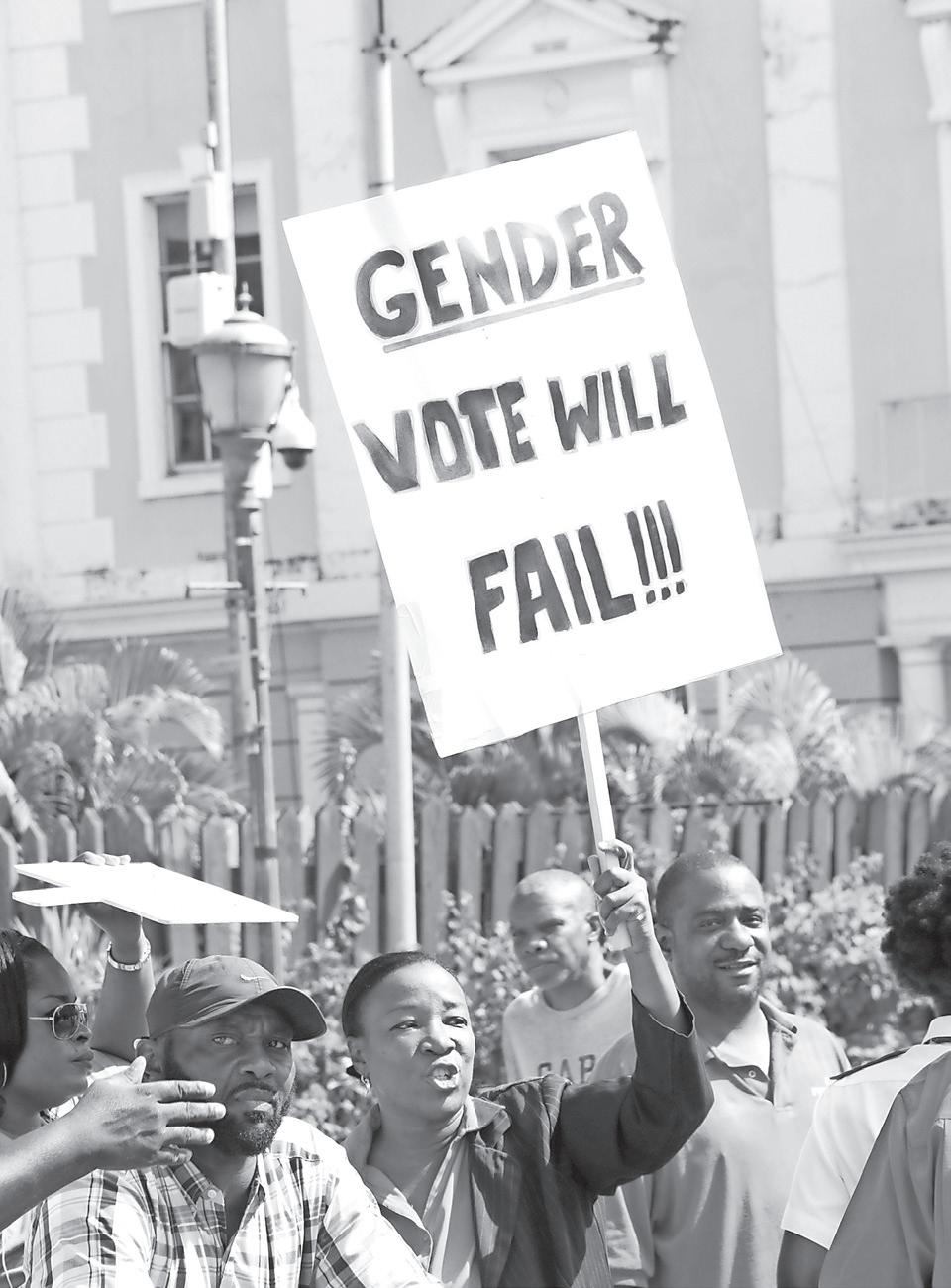
Hurricane Dorian will always be remembered as one of the worst natural disasters in Bahamian history, which pierced Bahamians’ sense of security in the face of hurricanes. Families were torn apart and communities were ruined in Abaco and Grand Bahama. The official death toll from the storm is 74. However, many more people were never accounted for.


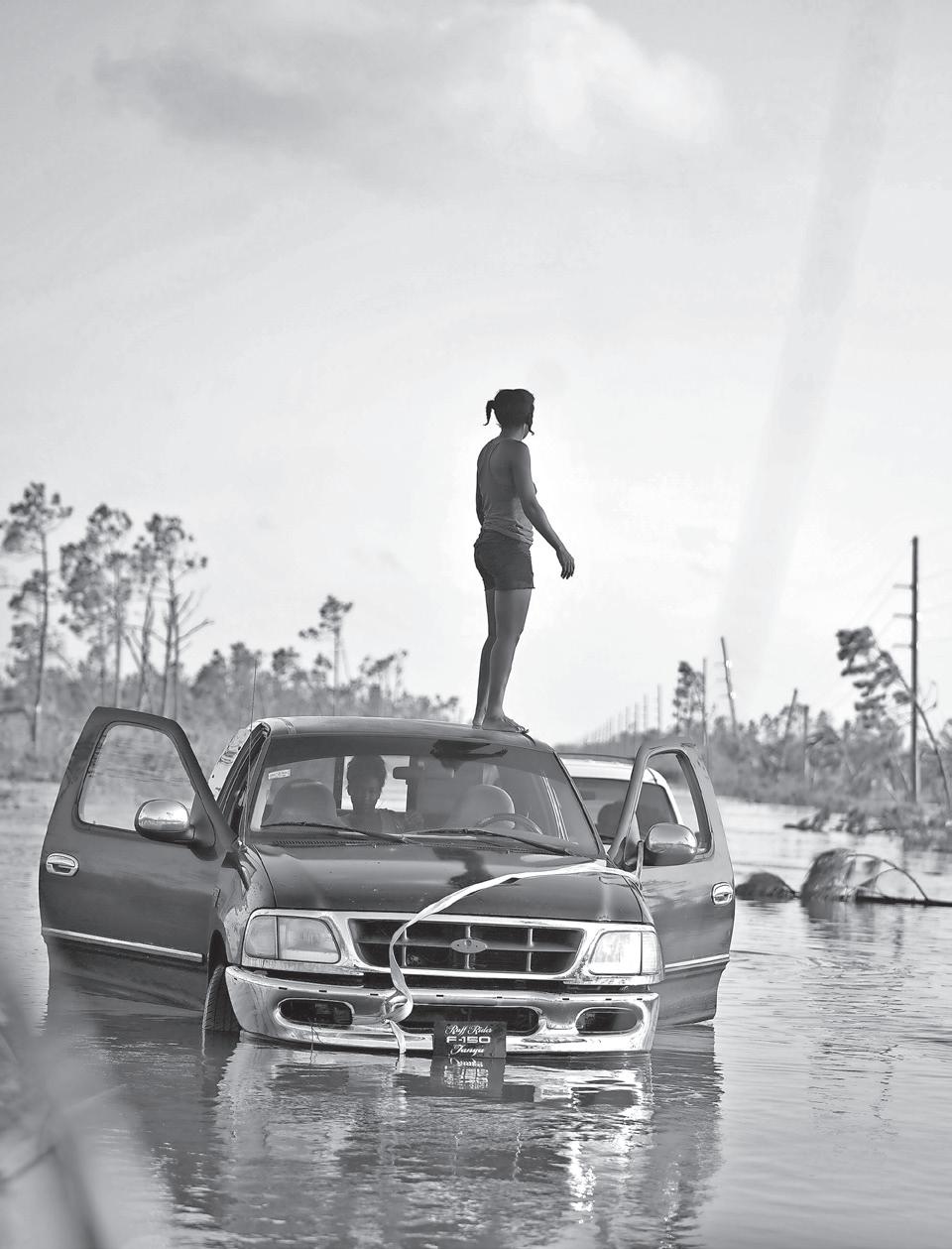
The COVID-19 pandemic plunged The Bahamas into an unprecedented era of uncertainty. More than 800 people died because of the infection. The pandemic will forever be etched in the minds of Bahamians of a particular generation for the lockdowns, the learning loss associated with school closures, the temporary suspension of the freedom to move and the growth in work-from-home initiatives.
On September 16, 2021, general elections were held in the Bahamas. The Progressive Liberal Party (PLP), led by Philip “Brave” Davis, emerged victorious, winning 32 of the 39 seats and sweeping the Minnis-led Free National Movement (FNM) gov ernment out of office. The circumstances surrounding these elections were notable. At the time, the Bahamas was in the midst of the deadly delta wave of the COVID-19 pandemic and under a state of emergency. Following persistent rumors of a snap election, then-Prime Minister Dr Hubert Minnis announced the dates of the Gen eral Elections on August 16, 2021. These elections were notable for their low voter turnout, with only an estimated 65 per cent of registered voters casting ballots ––an unusual phenomenon in the Bahamas, where voter turnout is consistently around 90 per cent. The new Davis Administra tion was noted for its steps toward gender equality, with seven female members of parliament and five women appointed as Cabinet Ministers. Additionally, the appointment of Bamboo Town MP Patri cia Deveaux as Speaker of the House of Assembly and Senator LaShell Adderley as president of the Senate, marked the first time in Bahamian history that women-led both chambers of parliament simultane ously. Thirty-two is the most seats the PLP has won in a general election since 1982. It is also the highest percentage of seats the party has won since that time. Meanwhile, seven seats were the fewest seats the FNM has won since 1977.

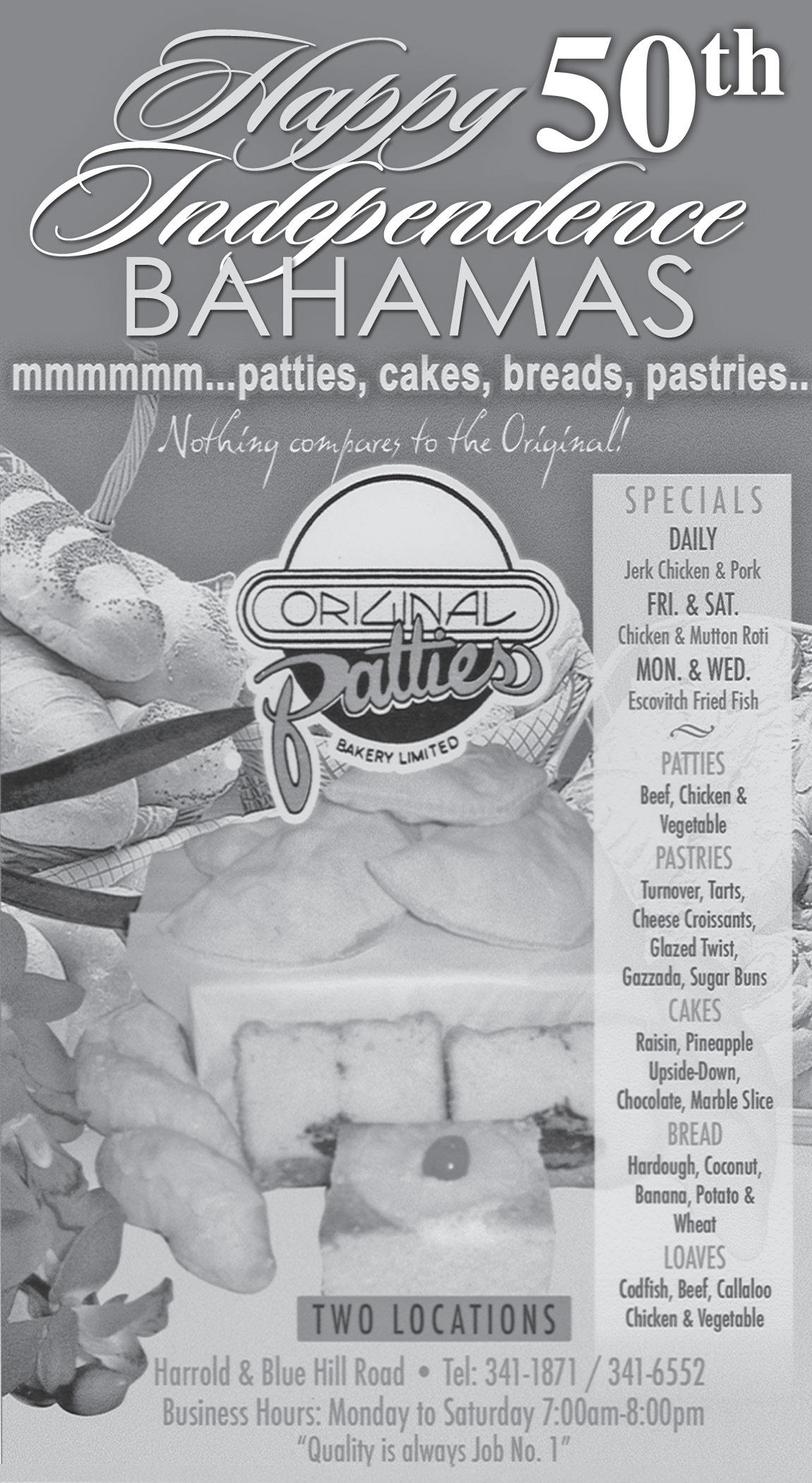

The Bahamas’ greatest cultural expres sion, Junkanoo, was among the casualties of the COVID-19 pandemic. The Boxing Day and New Years Day parades were not held as usual for two years. When the parades returned, the excitement was extra special and the crowds as large as ever.
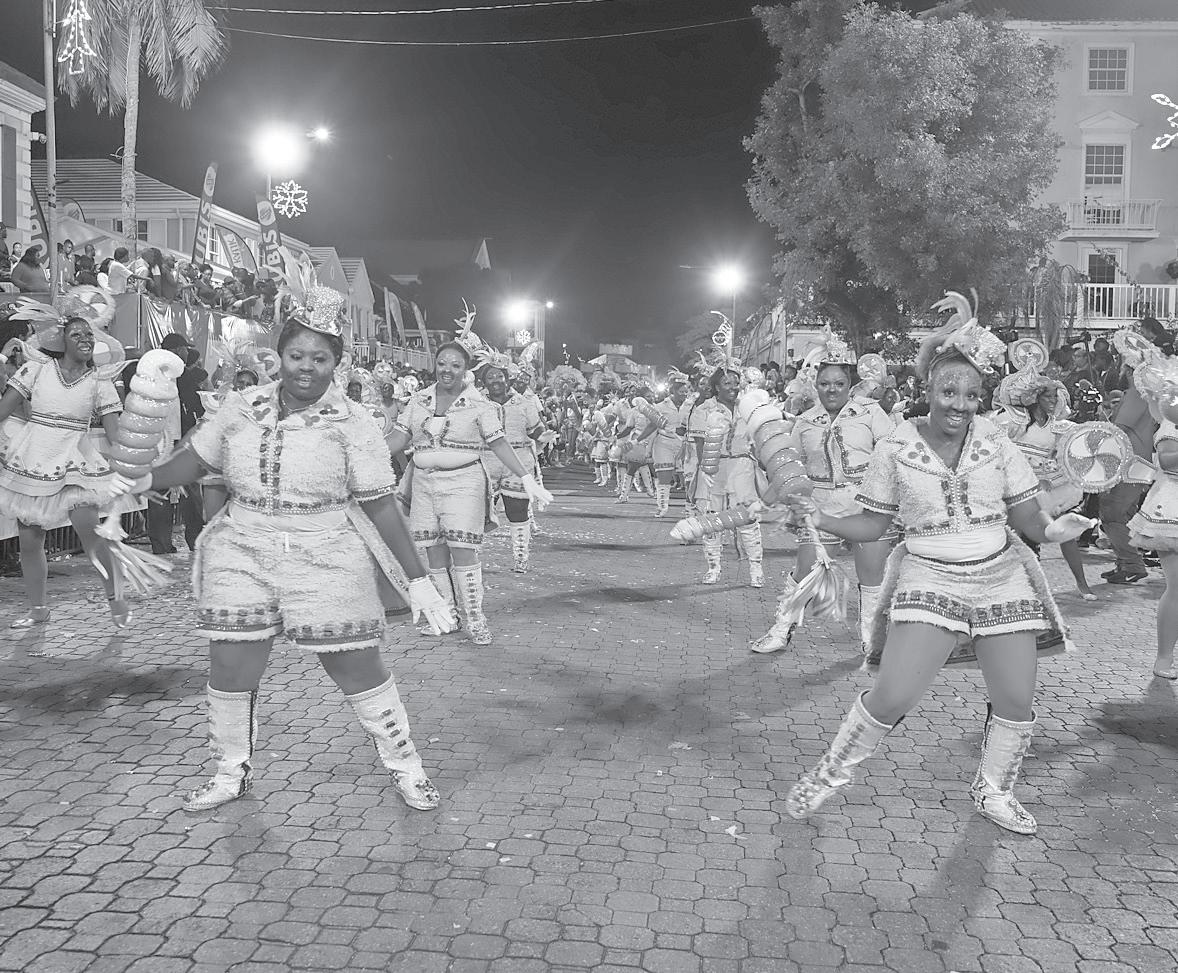

On Thursday, May 4 2023, the Privy Council in the United Kingdom upheld Chief Justice Ian Winder’s ruling in a land mark decision which declared that children born out of wedlock to Bahamian men are citizens at birth regardless of their mother’s nationality. Prior to this decision, children born to unmarried Bahamian men and for eign women were required to wait until the age of 18 to apply for Bahamian citizenship.
FIFTY years in the life of a country is relatively young, but as The Bahamas celebrates its golden jubilee, it can take pride in the development and maturity of its cultural identity.
In celebration of the 50th anniversary of Independence, The Tribune takes a look at the accomplishments of 50 Bahamians who have either showcased the best of Bahamian talent, or have worked to promote, preserve or advance Bahamian culture in the fields of arts and entertainment in the past five decades.

The list is only the tip of the iceberg in identifying the talent in this country and to name every Bahamian who has made a contribution and list all their accomplishments would take another 50 years.

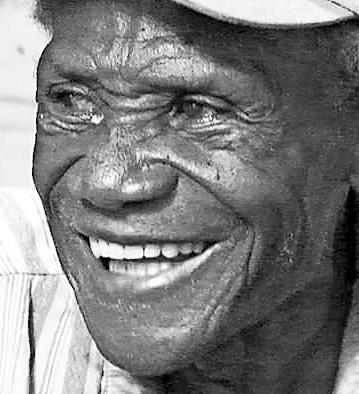
Amos was without question one of the most known and respected Bahamian artists around the world. His unique, colorful folk style of painting depicting classic Bahamian themes captured the attention of art enthusiasts around the world, making his pieces most sought and treasured. He is considered one of the country’s National Treasures.
in his work. As a sculpturist one of his most moving pieces is Sacred Space - a collection of faceless carvings who silently stare across the ocean toward the ocean at the Clifton Heritage Park. He also renovated the space where his Hillside House Art Gallery is creating a tranquil Oasis in the downtown area.
Eddie Minnis has a very distinctive style of art, that makes his work easy to spot. If you have ever looked at a classic painting of a Poinciana tree in full bloom or the quaint architecture of the Bahamas in days gone by and thought how perfectly it captures their beauty it has probably been painted by him or he inspired the artist who did it. Eddie is a selftaught artist influenced by the French Impressionists. When he is not painting, he enjoys singing and has produced ten albums since 1971 including Bahamian classics such as “Naughty Johnny” and “Shot-gun Wedding”. He has also inspired his daughters Nicole and Roshanne to become artists as well.
Known as the Celebrity Artist, Jamaal has captured the faces of celebrities all over the world and Bahamian from all walks of life. He has painted portraits of the Prince Harry, Oprah Winfrey, Sir Sidney Poitier, Former Prime Minister of the Commonwealth of the Bahamas Perry G Christie, Johnny Depp, NBA Legends/Sports Moguls Magic Johnson, Michael Jordan, NBA Champions Lebron James, Dwayne Wade, business mogul Sean P Diddy Combs, Taylor Swift, Grammy Award Winner Carrie Underwood, NFL Champion and TV host Michael Strahan and civil rights activist Rev Al Sharpton just to name a few. During his tenure as Tribune cartoonist, he gave humorous but thoughtprovoking commentary on Bahamian life. Jamaal was recently named Bahamas Ambassador and Permanent Delegate to UNESCO.
Marguerite Pindling. Harl Taylor was awarded the Cacique Award of Art and Design in 2000 by The Ministry of Tourism, for his valuable role in the resurgence of the Straw Craft Industry.
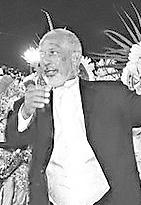
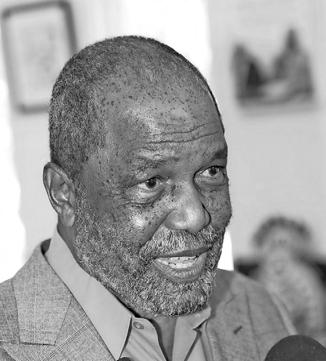
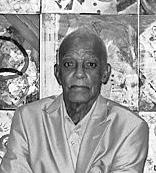
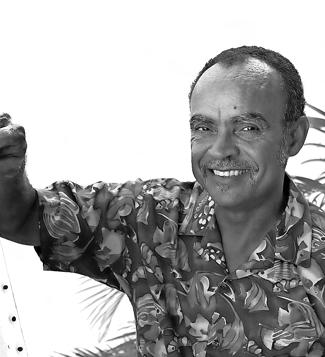
Jackson Burnside was a noted architect, known for designs that emphasised traditional Bahamian architeure as seen in his designs of Marine Village. He and his wife Pam founded the Doongalick stundio and were instrumental spearheading a project to get Nassau recognised as a City of Design as part of UNESCO’s Global Alliance’s Creative Cities Network. Jackson believed that someday “more people would come to The Bahamas for arts and culture than for sun, sand and sea”.
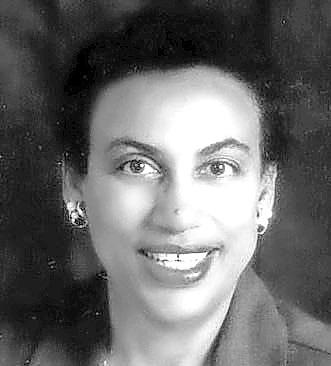
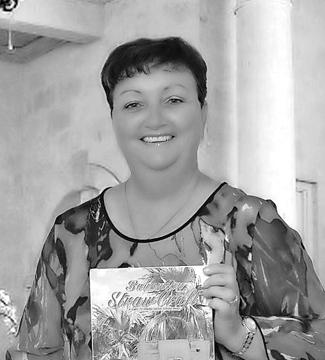
Stan Burnside is also a noted painter and sculptor who uses his art for social commentary. He is the artist behind the editorial cartoon SideBurns and was a principle designer for The Saxon Superstars before helping form the One Family Junkanoo Group.
Few people would dispute that Viola is indeed the “King of Junkanoo”. As the leader of one of the country’s largest and popular group the Saxon Superstars and one of the organisers of the Junior Junkanoo parades, Viola has worked to ensure that a new generation of young people keep the Junkanoo drum beat alive.

As the first Bahamian to obtain an ‘A’ Level in Art and the first to go on to art school (Beckenham School of Art and Ravensbourne College) Brent set a standard for Bahamian artists to receive formal training in the arts. Brent was known for his master artistic technique across multiple disciplines in particular photorealism and surrealism. He has worked with other notable Bahamian artists to promote art throughout his life.
When it comes to abstract Bahamian art, Kendall Hanna is at the top of the list. He is one of the earliest artists to adopt this style of painting. He has described his work as “subconscious mind expressing itself on the canvas.
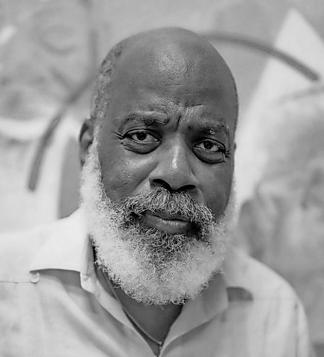
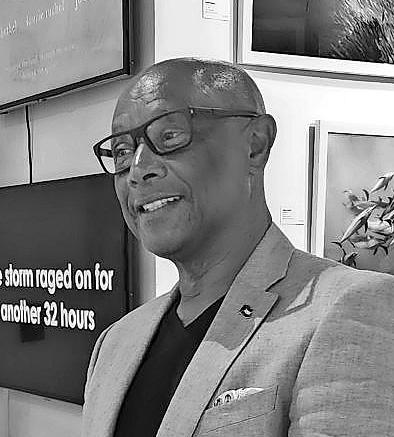
Bahamian art has a place to call home largely in part of the efforts of Erica. She was instrumental in the design and development of the National Art Gallery of the Bahamas serving initially as its founding director and chief curator. She is also an art and history professor, having taught at The University of Miami and Yale University.
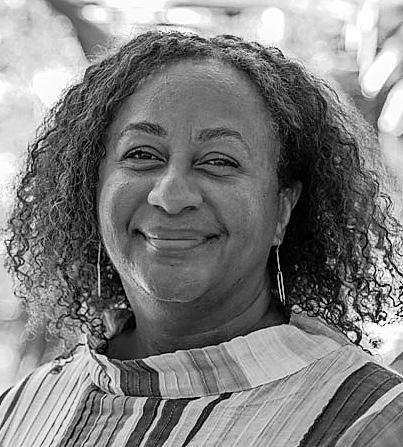
Antonius draws much inspiration from history and the need for conservation
Arlene Nash Ferguson found a way to combine two of her her passions - education and Junkanoo - when she created Educulturean experiential Junkanoo Museum and Resource Center, aiming to explore, discover and celebrate the spirit of Junkanoo. She is also an avid member of the One Family Junkanoo Group. Her first book ‘I Come To Get Me! An inside look at the Junkanoo Festival’ has been highly acclaimed.
A Long Island native, straw work has always been in Barbara’s blood having been taught by both her parents from an early age. She is the creator of exquisite straw work and crafts and has a dedicated and faithful clientele who have supported her for decades. Her annual Christmas show is always highly anticipated event. Barbara’s passion is to ensure that the art of straw making is not lost on future generations. Her book Bahamian Straw Craft - A Guide to Making Native Straw Bags, provides step-by-step instructions for making several different style straw bags, and also provides background on this industry by describing the sources of straw and the methods of cutting and curing the Silver Top Palm leaves.
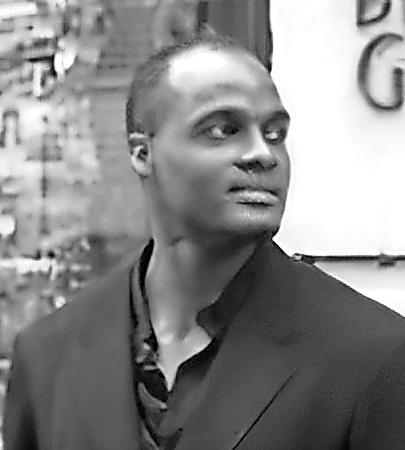
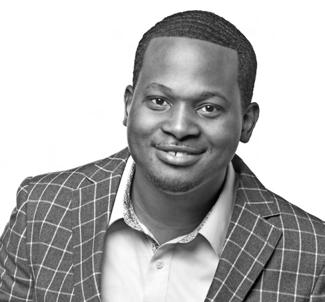
Fashion designer Harl Taylor managed to turn a staple piece of Bahamian culture into an International fashion status symbol. His designer straw bags which all carry the signature label Harl Taylor BAG have turned Bahamian straw work into couture art with the addition of palm fronds, sisal, straw, seashells, wood carvings, bamboo, faux tortoise, and shell handles.
The designer bags have been stocked in such luxury boutiques as Bergdorf Goodman and Neiman Marcus and have been carried by the likes of Naomi Campbell, Oprah Winfrey, Vanessa Williams, Ann Marie Davis and even made their way into Buckingham Palace in the hands of Her Excellency Dame
Gus has been called the Father of Modern Junkanoo. As the leader of the Valley Boys, Gus was renewed for his energetic dancing and the fine attention to detail and accuracy he bought to his costumes. Throughout his life he received many awards recognising his commitment to the advancement of Junkanoo and Bahamian Culture.
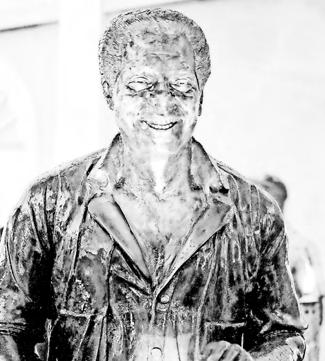
Chippie Chipman learned to play native drums during his first job as a waiter at the legendary Paul Meeres Club in the 1950s. It was a talent that would take him around the world promoting Bahamian culture. Many young boys and girls will remember him for giving them drums or teaching them a beat at various spots around the country. Chippie was always seen with his signature straw hat and cigar. He and his wife Becky (an excellent fire dancer) were instrumental in the promotion of Bahamian culture.
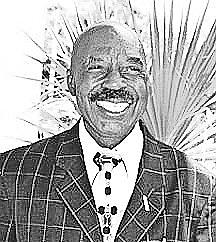
and the name stuck. Peanuts eventually made a name for himself preforming in notable clubs in the Bahamas, Cuba and the United States. Throughout his career he has opened for Nat King Cole and appeared on shows such as The Johnny Carson Show, The Steve Allen Show, The Jack Par and the Ed Sullivan Show. The Drumbeat Club remained open for more than three decades featuring a native review show and giving artists such Eloise Lewis, Ritchie Delamore, Chickie Horne, Veronica Bishop, Jim Duncombe, King Pedro, Wendell Stuart, and countless other Bahamian stars a place to perform.
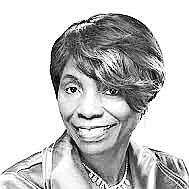
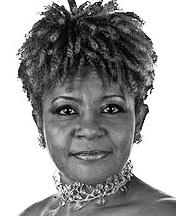
John Berkeley Taylor
aka Peanuts is known for his famous nightclub the Drum Beat and for being a dancer, singer and drummer. He originally got his start at the well-known Paul Meeres Club back in the 50s. It is said that a young John told Paul that he was a better singer than him to which Paul replied, “What a young peanut like you?”
King Eric Gibson and his knights had one of the hottest hot night clubs frequented by locals and tourists alike. Between 1960 and 1978, King Eric led the band to ten albums, including: Calypso Encores (with Ronnie Butler), Paging King Eric & His Knights, Bahama Goombay Summer, and Island Boy. In 1966, he opened a recording studio to support other native Bahamian musicians.
Bahamian female entertainers can thank Maureen Duvalier for blazing a trail for women in the industry at a time when it was considered unseemly for women to perform in clubs. Ms Duvalier was known as “Bahama Mama” and “Calypso Mama”. She made history as the first woman with a Junkanoo group in 1958. In the group were such notables as former Senator Telator Strachan and the late Becky Chipman. Their group went on to win the first-place trophy. She began her work as an entertainer with Freddie Munnings Sr at the Silver Slipper Night Club and other stints followed at the Montagu Hotel, the Ardastra Gardens, the Spider Web Night Club and the British Colonial Hotel Lounge. Her repertoire was native folk and calypso. Her father was the late Eustace Edward Duvalier and she was the niece of the one-time Haitian President Francois “Papa Doc” Duvalier. She was a spiritual person, her motto being “put God first”, and her real joy, she said, came from making others happy.
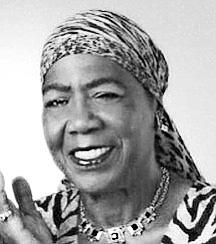
This dynamic husband and wife team are the pastors of Creative Christian Arts Ministries International. They have work have worked tirelessly to improve the lives of inner-city children by creating community centers which help children with homework and reading in the evenings after school. Pastor Henry has studied folk dance since the age of 5 and has been active in dance and drama throughout his life. A huge supporter of culture, he was a choreographer for the Saxons Superstars. His wife Anne is a former cabaret dancer, who left the stage after giving her life to the Lord. She then used her dance talents to expand liturgical dance in the country. She started Exercise by Faith, Fitness and Dance Studio, the first Christian Dance Studio in the Bahamas. She was Co-Ordinator of Christian Dance Fellowship Bahamas (CDFB) and a member of the International Christian Dance Fellowship (ICDF).
Dr Higgins along with her husband Henry, are the coordinators of Caribbean Christian Dance Network (CCDN) a conference that draws dancers from around the world together every year. Dr Higgins has written two books Born to Dance and The Purpose of the Dance. The couple also formed the Conquers for Christ Junkanoo group.
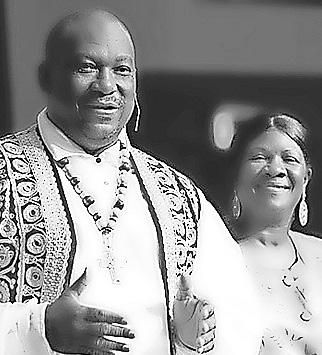
This group of brothers from the beautiful island of Cat Island have drawn inspiration from the deeply religious roots of the country to sing classic hymns in harmonious perfection. They have taken their Bahamian style praise around the world with songs such as Whose Gonna Fill Their Shoes, What will I leave behind, Glory to His Name and Feel like My time ain Long.
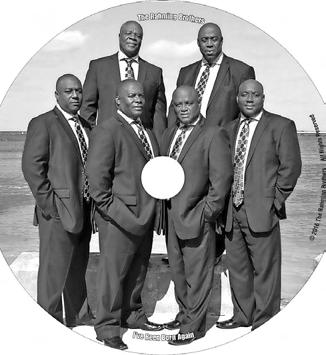
Nicholas Payton, Eddie Henderson, Barry Harris, Jason Moran, Ralph Peterson, Roy Hargrove and much more. Here at home, he has been mentored by Adrian D’Aguilar whom he has said has inspired him to do his part to push jazz to the forefront of the Bahamian music scene.
The Singing Bishop as he is called has entertained thousands of Bahamians with his dynamic and colorful interpretation of well know gospel hymns such as It is Well and his song Too Much Murder. The pastor brings the gospel message in a down home and simple way that has appealed to many of his followers. He is also a pillar in the community and his outreach programs have assisted thousands of disadvantaged Bahamians. Recently he has found another way to serve as he became a police reservist.
Opera singer Joann has been called the Bahamian songbird for her melodic soprano voice. She has performed all over the world with the Florence South Carolina Orchestra, University of Miami Orchestra, Chamber Orchestra of Nazareth College Rochester, New York, and the highlyacclaimed Moscow Soloists Orchestra under the direction of violist/conductor Yuri Bashmet. Additionally, she sang the role of Sister Josetta in the presence of Her Majesty Queen Elizabeth II, in the October, 1985 production of the Bahamian Folk Opera “The Legend of Sammie Swain”, and reprised the role in October 2013. She is also a poet, lyricist, playwright and composer and has published a book Breastless Beauty: A collection of poems and photographs” which highlights her fight with breast cancer.
Joann was married to her equally talented husband Lee Callender who was a celebrated pianist and vocal coach who helped many Bahamian singers discover the full potential of their voices. Lee had another famous Bahamian as a piano teacher when he was a young boy- his grandfather the late Timothy Gibson, composer of the Bahamian National Anthem. Lee passed away last year.
Tony McKay is also known as the Exuma Obeah Man and was a musician who blended folk, carnival, Junkanoo, calypso, reggae, and African music. Tony said his music is meant to depict spiritual and healing practices based in Africa. He originally went to school in New York to study architecture, but started his own band Tony McKay and the Islanders, Tony has had the opportunity to perform with artists such as Nina Simone, Peter, Paul & Mary and Bob Dylan and Patti Labelle and the Neville Brothers. He was also a self-taught painter. His works featured Obeah, self-portraits and religious themes. In 1978, McKay received a British
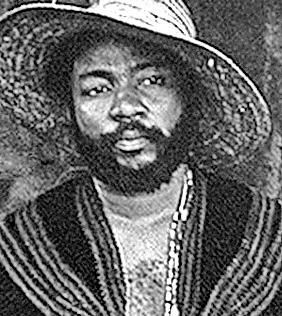
Dion is an extraordinary classic pianist who hopes his success inspire those from non-traditional backgrounds to pursue careers in music. In 2013, Dion graduated from the prestigious Peabody Institute of Johns Hopkins University with a Master of Music in Piano studying with Marian Hahn. For his outstanding musical achievement, he was awarded the Frances W Wentz Turner Memorial Prize. In 2019, Dion graduated from the University of Maryland with a Doctor of Musical Arts studying with Cleveland Page and Rita Sloan. He made his debut in Carnegie’s Weill Recital Hall in November of that year. Dion has maintained an active career as a soloist and collaborator which has taken him to North and South America, the Caribbean and Europe. He believes that music has immense power to bring about the positive change we need in our communities by promoting mutual understanding of the things that connect us as human being.

Cleophas gave a nation’s youth its voice and the platform from which to use it when he founded and became director of the Bahamas National Youth Choir in 1983. The group has become a national institution and a source of pride for Bahamians. Cleophas instilled a legacy of excellence and professionalism that the choir maintains even though he is no longer with us. The BNYC. The choir has sung in 24 languages and travelled to 22 countries. It has performed at The Kennedy Center in Washington DC, The Grand Hall of The Moscow Conservatory, The Poly Theatre in China, Notre Dame Cathedral in Paris, St. Peter’s Basilica in Rome and for Her Majesty Queen Elizabeth II.
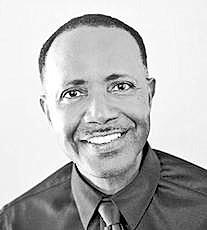
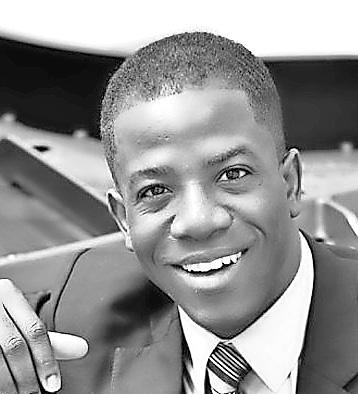
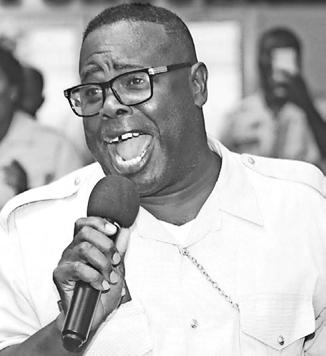

The Bahamas National Youth Choir has received many awards including two gold medals at 2012 World Choir Games.
Giveton Gelin is one of the faces of the next generation of Bahamian musicians who are poised to take the world by storm. A self-taught Jazz musician, Giveton has been playing the trumpet since he was ten. His persistence paid off landing him a full scholarship to the prestigious Juilard School of Music in New York where he has already made quite a name for himself.
He has had the opportunity to work with international jazz legends such as Wynton Marsalis,
An accomplished composer, Cleophas composed the first Bahamian grand opera “Our Boys”, which is also the first opera to have been written and performed in the English-speaking Caribbean.
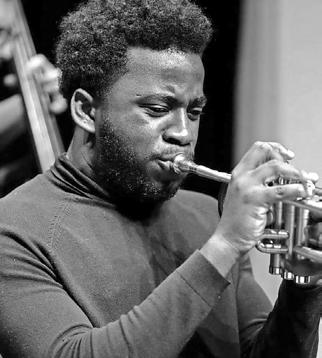
the tribune pays tribune to cultural legends
Maya Angelou once said
“You Can’t Really Know Where You Are Going Until You Know Where You Have Been. Bahamians can certainly credit historian Gail Saunders for their sense of direction. She was a former scholarin-residence at The College of The Bahamas and former director of the National Archives of The Bahamas. She also served as directorgeneral of heritage for the Bahamas Archives. She is the author of several books, including Bahamian Society after Emancipation. Ms Saunders passed away last week. The country owes her a tremendous debt of gratitude and she has left very large shoes to fill.
Patricia Glinton Meicholas is an author, poet, cultural critic, researcher in Bahamian art, culture and history and communication specialist. She has written several poetry volumes and books about the culture of the Bahamas including the humorous Talkin’ Bahamian, More Talkin’ Bahamian and How To Be a True-True Bahamian volumes 1 and 2. Additional works include An Evening in Guanima, collected folktales, Years of Favour, history of the Roman Catholic Archdiocese of The Bahamas and the Sinking of HMBS Flamingo and Its Roots in United States, Cuba and Bahamas Relationships.
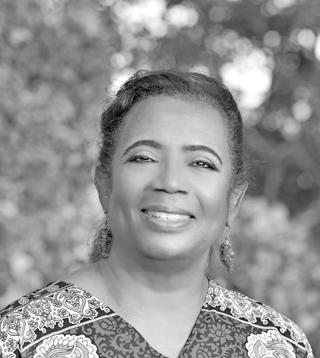
With a keen interest in genealogy and history, Cat Island native Vera Chase spent most of her life telling stories and writing poetry.
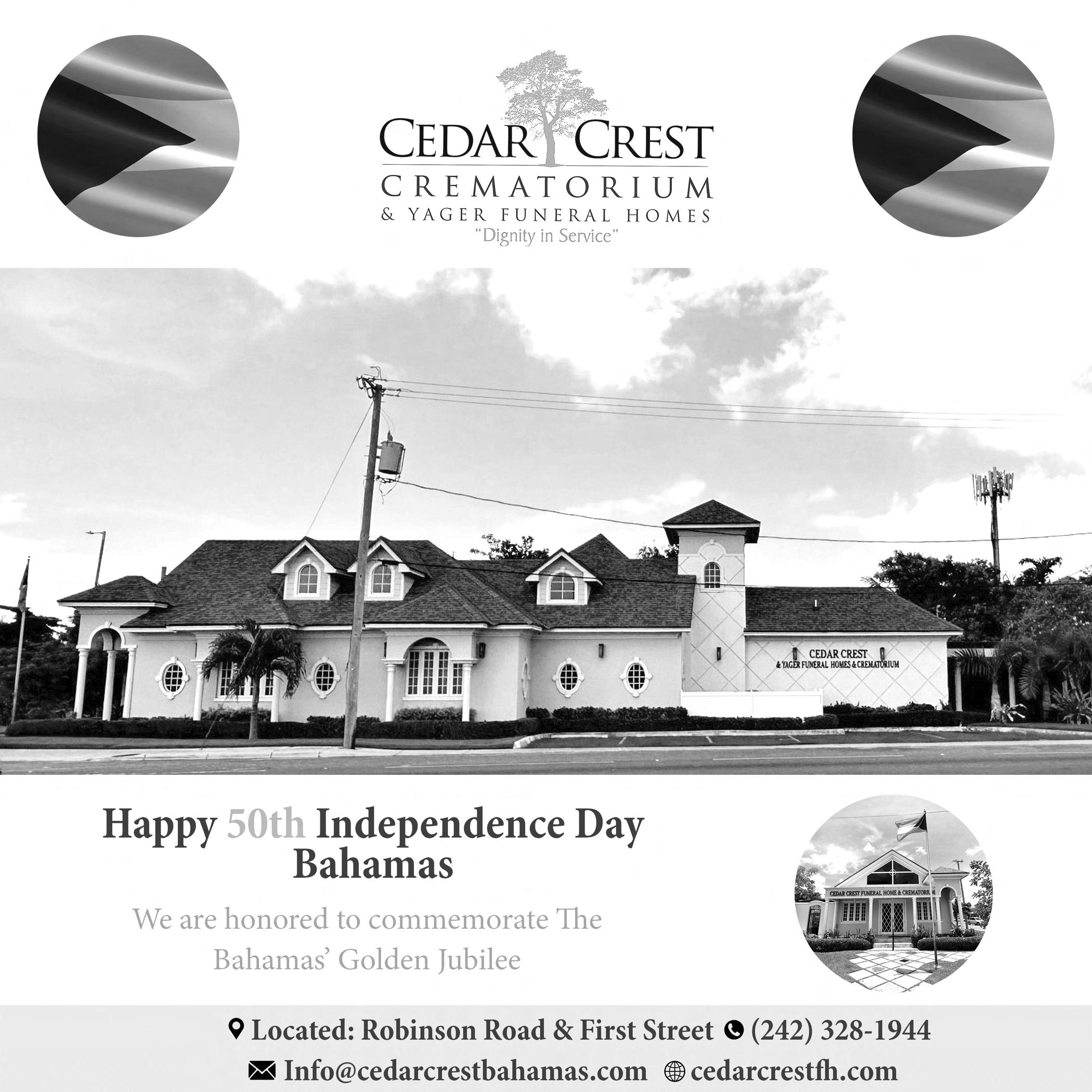
Professionally she was a banker and the first person of colour to be hired by the Royal Bank of Canada. She founded the Commonwealth Writers of Tthe Bahamas, a non-profit Writing organisation designed to foster the talent of young writers. Vera has published several books including: Take Me Back to Guanahani and Pirates Paradise. She has said, “I am in love with Bahamian history. Nobody studies Bahamian history like I do. Other people go out and have fun, but I research history all the time.”
the first black person and Bahamian to win a Best Actor Academy Award for his performance in Lillies of the Field. With stellar performances in Hollywood classics such as Guess Who is Coming to Dinner, To Sir With Love and In the Heat of the Night, Sir Sidney remains the golden standard for Bahamian Actors. Sir Sidney represented The Bahamas on the international stage as the Ambassador of the Commonwealth of The Bahamas to Japan from 1997 to 2007, and then as the Ambassador to UNESCO during the period 2002-2007.
Travolta Cooper is an award-winning film maker who has worked to document the stories of prominent Bahamians. His film The Black Moses follows Sir Lynden Pindling, the“Father of the Nation”, as he sets out on a course to bring about social, political and economic revolution to the British Bahama Islands. Founding Fathers is about Sir Stafford Sands. Travolta just recently completed The King of Junkanoo which celebrates the life of Junkanoo Legend Percy Vola Francis. Additionally, he is passionate about providing opportunities for Bahamians to see themselves on screen such as in his projects Where in the World is Wally and Children of God.
As a documentarist and film maker, Maria has shed light on many social issues affecting the country. Her films include Play the Devil, Rain, and Sisters. Her feature film Rain which depicted the story of a young woman who has to leave her sheltered life on Ragged Island and learn the harsh realities of life has received international acclaim.
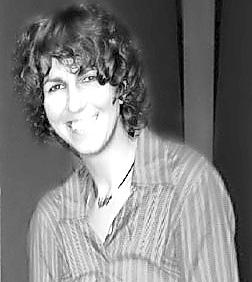

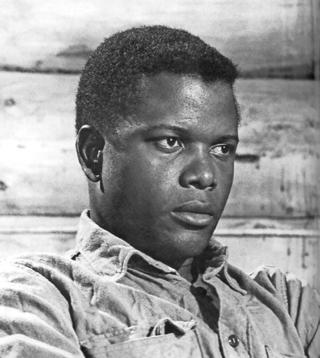
This Cat Island Native showed the entire world just how talented Bahamians are when he became
Kareem has more than three dozen awards for his documentary filmmaking feature films include Cargo, Windjammers, and Children of God; national campaigns include spots for Aliv, Ministry of Environmental Health, Ministry of Tourism, and Scorpios; television shows include: Hip-Hop Nation: Notes from the Underground, The Electronic Lounge, This Is Paradise and Extraordinary Cuisine. His film Children of God was the narrative feature from the Caribbean with LGBT themes.
Cookie Allens has been a staple on the Bahamian stage for more than four decades. She began her career wit the University Players and later joined the James Catalyn and Friends theatre group regular presence at Summer Madness shows. She took major roles in James Baldwin’s “The Amen Corner” and ‘Them” by Winston Saunders. One of her career highlights was representing the Bahamas at the 1991 Edinburgh Fringe Festival in Scotland she performed in “You can lead a Horse to Water” by Winston Saunders and “Music of The Bahamas” an adaptation from the late E Clement Bethel’s thesis done by Nicolette Bethel and Philip Burrows. Cookie is also well known for voicing radio ads and appearing in tv ads. Cookie is passionate about the preservation of the oral traditon of Bahamian storytelling.

Philip A Burrows is a director, teacher and actor who has shared his talents with the world since the age of five.
Philip was the artistic and resident director of the Dundas Repertory Season from its beginning in 1981 straight through to 1997. In August 1991, he headed a contingent of some 30 performers who took part in the Edinburgh Festival Fringe. Under his direction, the first production of “Music of The Bahamas” was staged, which was cowritten for the stage by Philip and his equally talent wife Nicolette. Together they make a power couple in the arts community in the Bahamas.
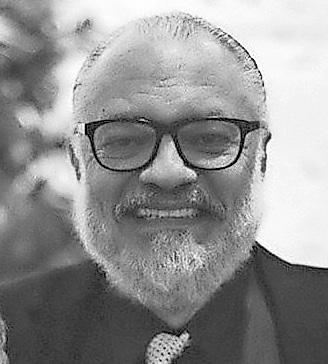
Philip had a three-year stint teaching a theatre arts programme at Lester B Pearson College in Victoria, British Columbia, Canada. He later put his musical ability to work as co-director of E Clement Bethel’s “Sammie Swain” and of the first Bahamian opera, “Our Boys”; of the latter he was also responsible, with Winston Saunders, for the libretto. He wrote the book and co-wrote the script for the original Bahamian Musical “Der Real Ting”. For the Ministry of Tourism, he has directed five Cacique Award Ceremonies and has written and directed “Bahamian Rhapsody” which was performed at The Apollo Theatre in New York. He was responsible for the co-direction of the 20th and 25th “Anniversary of Bahamian Independence” productions staged on Clifford Park and he directed the 30th, 32nd and 34th anniversary productions. He will serve as the director of the 50th Independence celebrations on July 9-10, 2023.
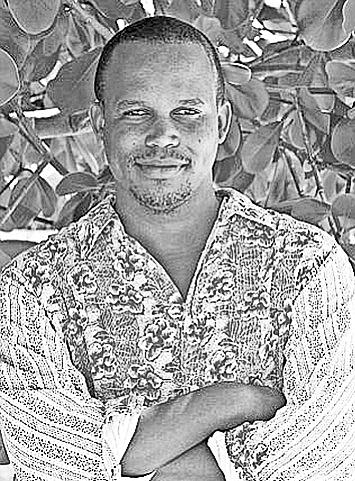
the tribune pays tribune to cultural legends
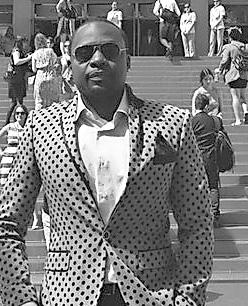
IN AN exclusive interview with the People’s Paper, Dame Marguerite Pindling reflected on the 50th anniversary of her late husband, Sir Lynden Pindling, and his steering the Bahamas into independent nationhood as well as her fears of what the future might hold.
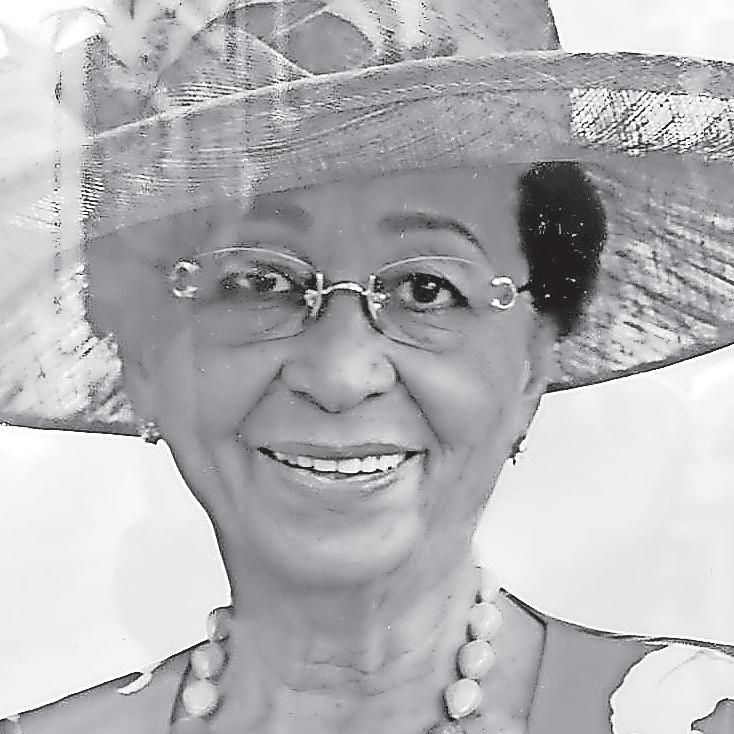
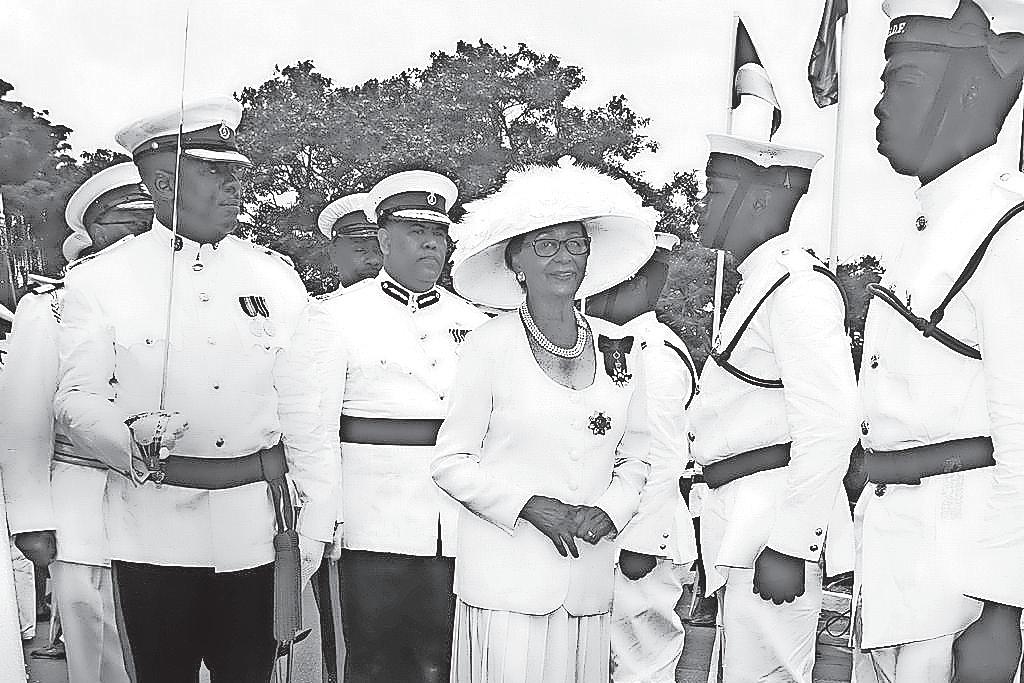

“We’ve come a long way,” Dame Marguerite reflected. “While we’ve taken great strides, we are not where we want to be” — noting particularly education, the breakdown of the family and the further empowerment of Bahamians.

“But, at least we have a lot more now than we did back then,” she added, although complaining about the lack of “broughtupsy” in our nation’s youth.
“Growing up in southern Andros, I never had thoughts about becoming an independent nation or things that like,” said Dame Marguerite. “I was focused on teaching our children manners and respect. Too many young people don’t take off their hat, open doors for ladies, let alone chew gum in church.
“My husband talked and dreamed about a better life. The thought of any independent nation brought a sense of excitement and hope. But, at the same time fear that you needed to stand on your own feet,” she explained. “What he saw, we saw, so did others like Arthur Hanna and Milo Butler”.
“I think it’s hard for this generation to understand the pride we felt when the flag was raised at Clifford Park. It was an indescribable sense of joy and love to be an independent nation. People were hugging and kissing all. Why? because they have all the things that their parents or grandparents never had,” she added.
A land where all would be free, stand tall and proud.
Referring to Sir Etienne Dupuch’s anti-discrimination resolution tabled in Parliament on January 23, 1956 “outlawing hotels, theatres and other public places in the colony to refuse to accommodate persons of colour” by what his brother, the Hon Eugene Dupuch, QC, MP termed “the evil use of immutable characteristics,” Dame Marguerite reflected on the fact that before that night she “grew up in a Bahamas where coloured persons could not go into hotels, restaurants, theatres, bathrooms or own land in certain areas”.
“Fear! If my husband had any, I can’t recall him sharing them. He fully understood the enormous task of what he, and his colleagues were attempting to do.
“While it was a different time and place, your grandfather, uncle and mother certainly kept my husband
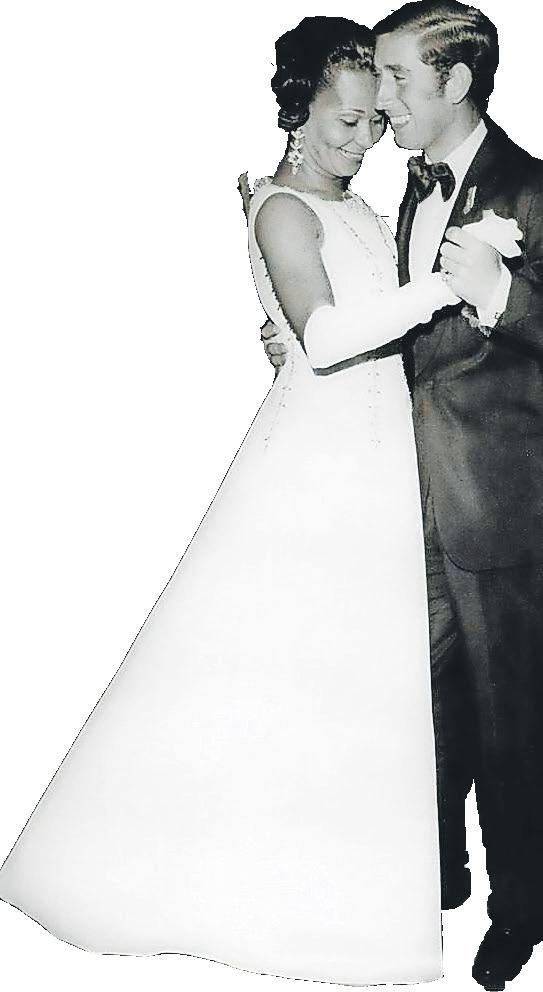 By ROBERT D CARRON and ADAM D DARVILLE
By ROBERT D CARRON and ADAM D DARVILLE
and the PLP on their toes,” she added.
“I often wonder about the world my grandchildren will live in,” said Dame Marguerite. “There seems to be a breakdown of the family unit. Our children seem hopeless and unloved. Men are absent from the lives of their children. Agreeing that we seem to have forgotten about God,” she added: “Like I’ve said before, if we return to the things that are important, family, education, love and mutual respect, I’m convinced that things can improve.”
“As for a Republic? My husband would not be in support of becoming a Republic, nor am I. We have the best of both worlds now.”
Momentarily setting aside any fears for the future, her granddaughter suddenly arrived carrying the gown she intends to wear to this evening’s State Gala. Asked if she were going, Dame Marguerite looked puzzled. “What you mean?”she asked, asking how The Tribune managed to get photos of her being escorted to the King’s coronation by Bahamian High Commissioner to the UK, Andy Gomez, Lady Pindling and her grand-daughter served notice they’ll be “dressed to impress”.
REFLECTING on the sunny day Prince Charles stepped off HMS Minerva at the Prince George Wharf, Dame Marguerite said: “He was the most handsome prince one could imagine.
At one of the Independence Balls, the late Charles Carter was the MC. He announced the Prince wanted to dance after which he came over and asked if I would give him the honour of a dance.
“I asked Prince Charles what music he would like? He replied, ‘calypso’. I said ‘you sure?’. He said, ‘Yes.’ He tried, she said, pointing to the photo with a wink and a grin.
“Can you believe, some 50 years later he remembered. In fact, he mentioned it to the Prime Minister. It’s been a long time!”
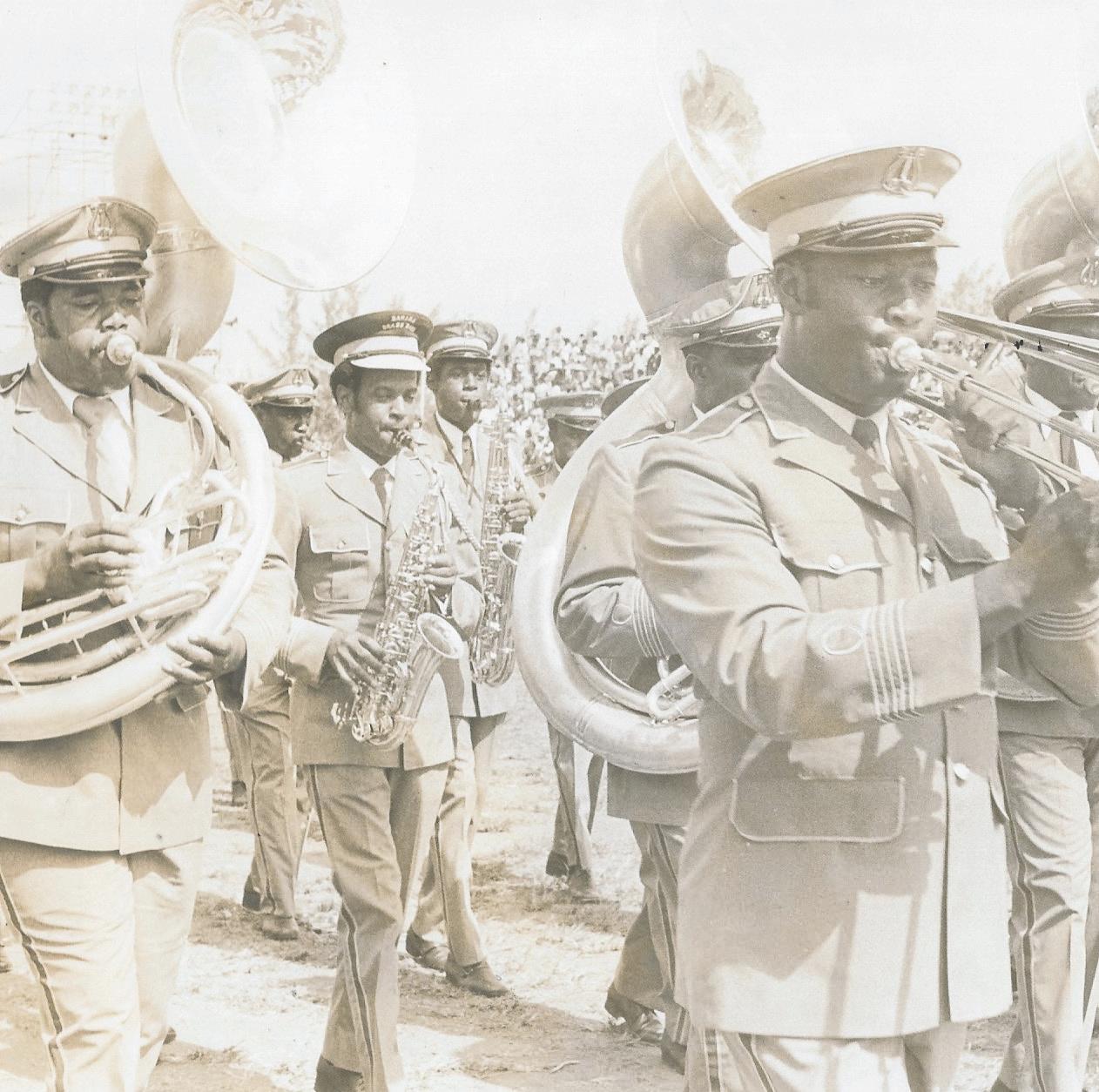

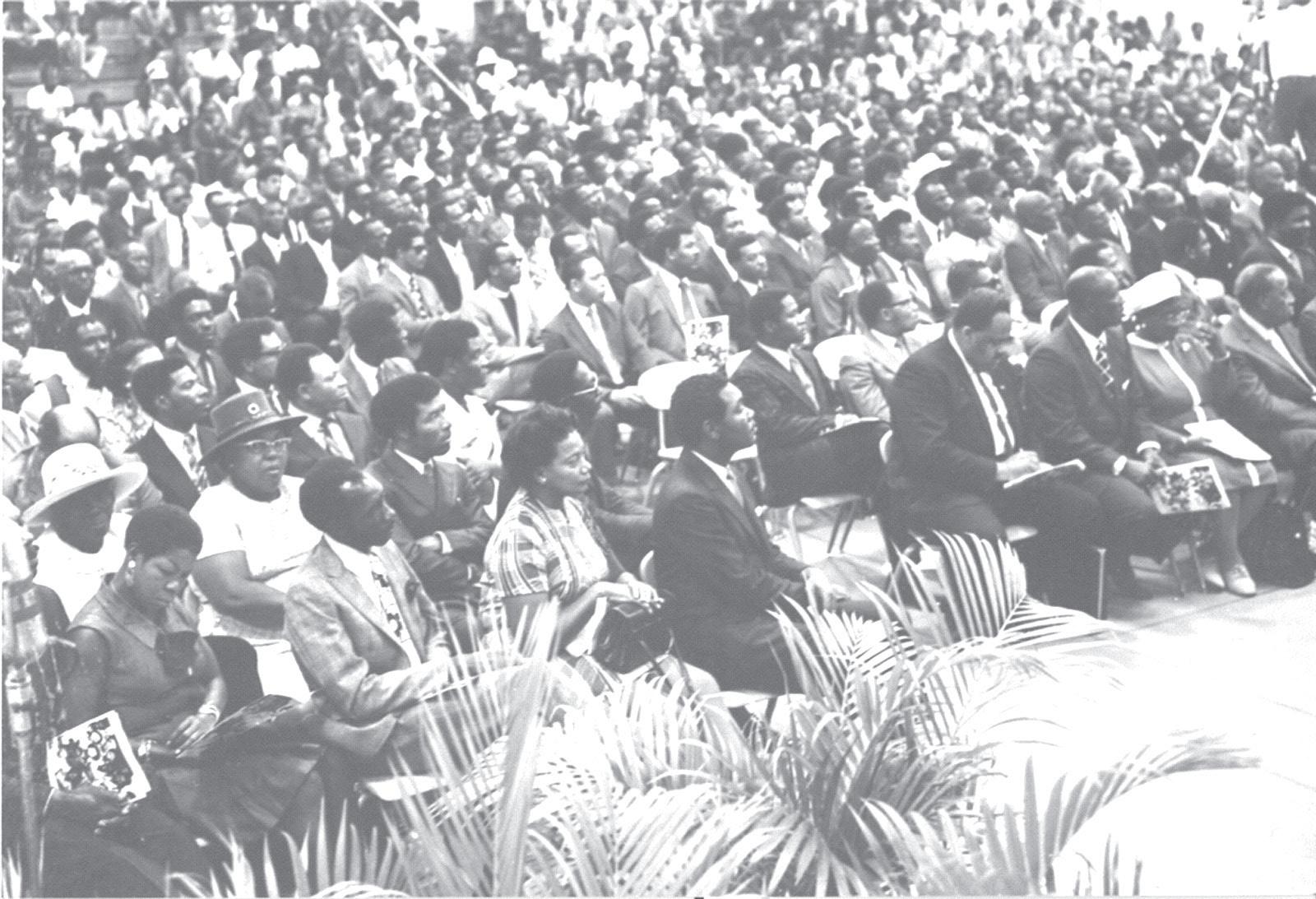

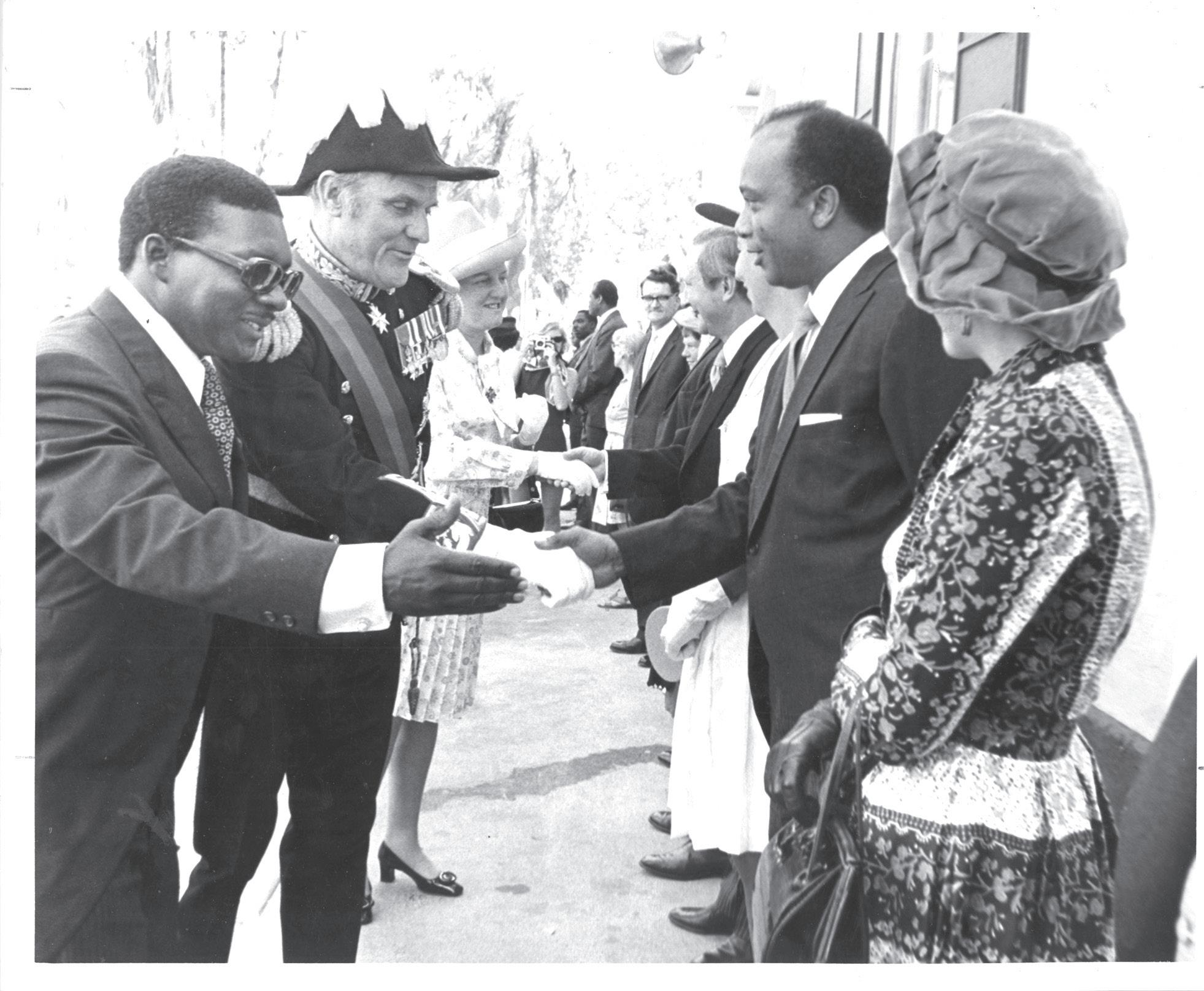

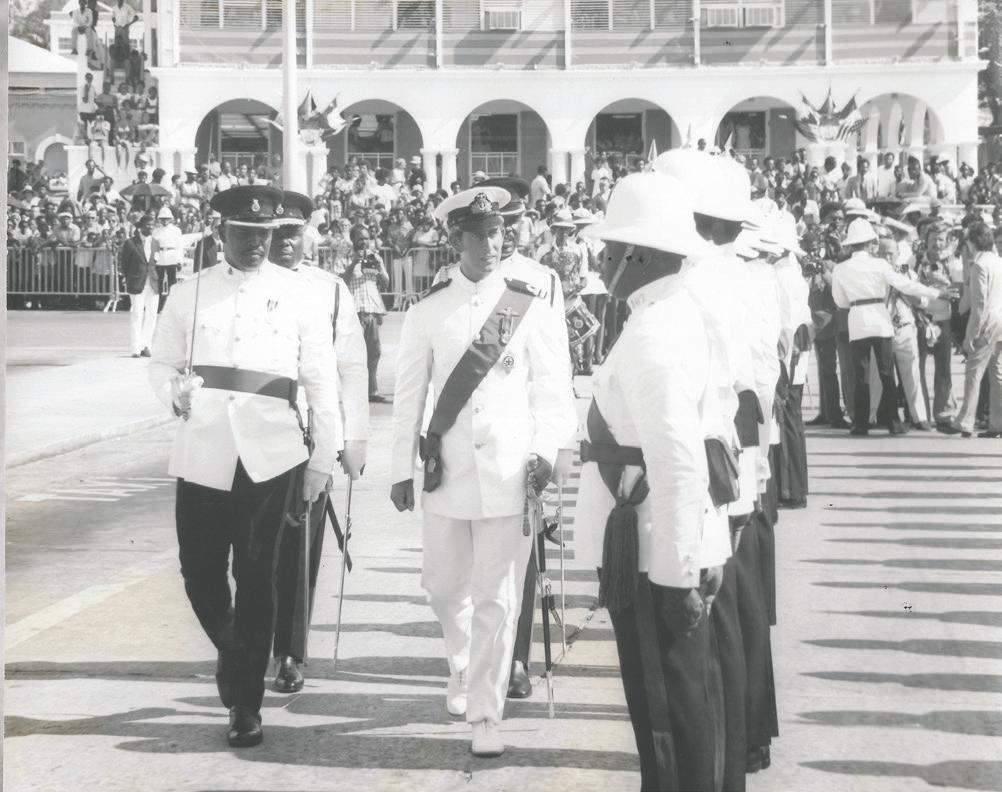
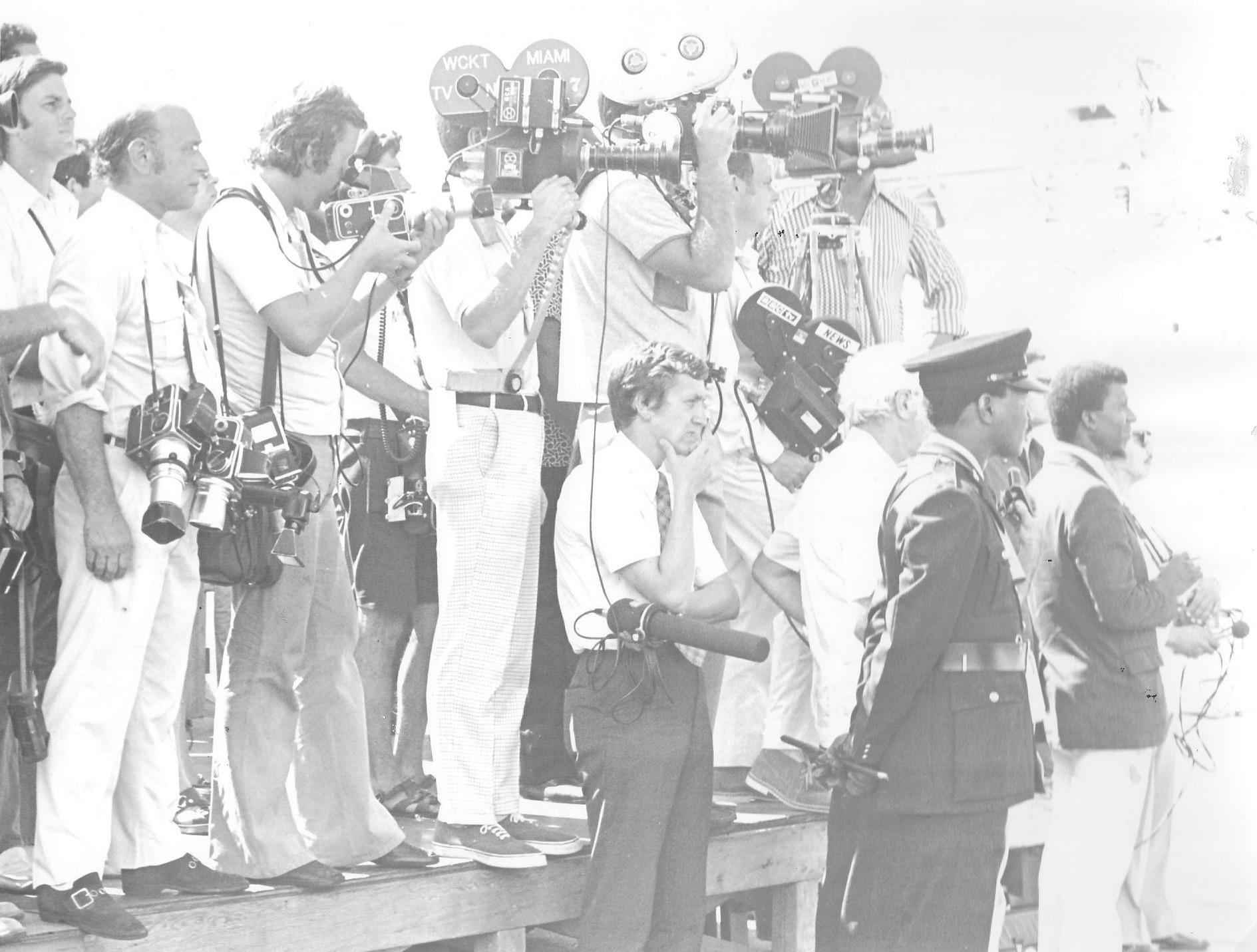
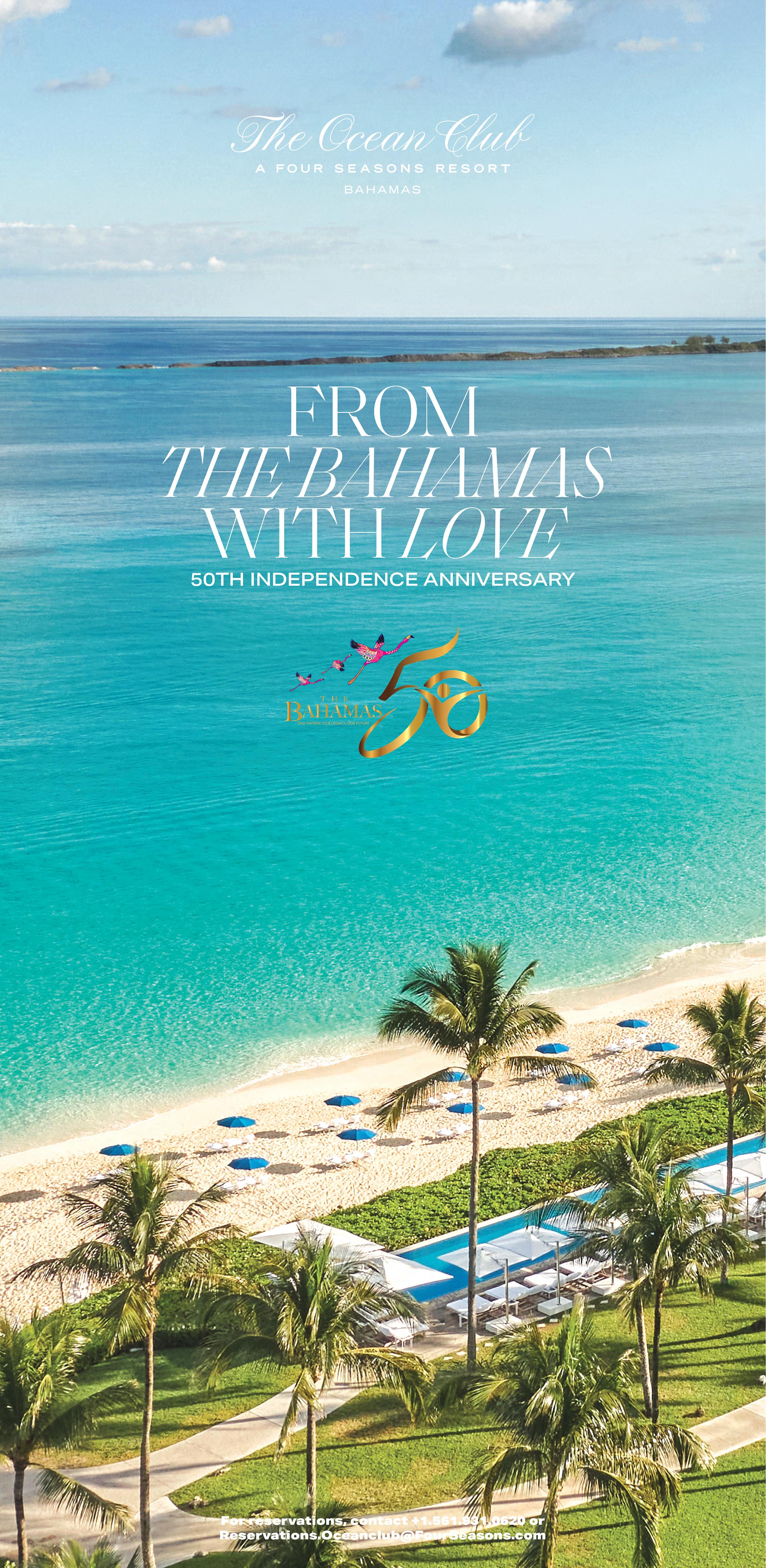
Warmest congratulations to The Bahamas on the 50th anniversary of Independence from all of us at Baha Mar.
We are proud to be a part of the incredible social, economic, and cultural growth of The Bahamas, and remain committed to her success for generations to come.
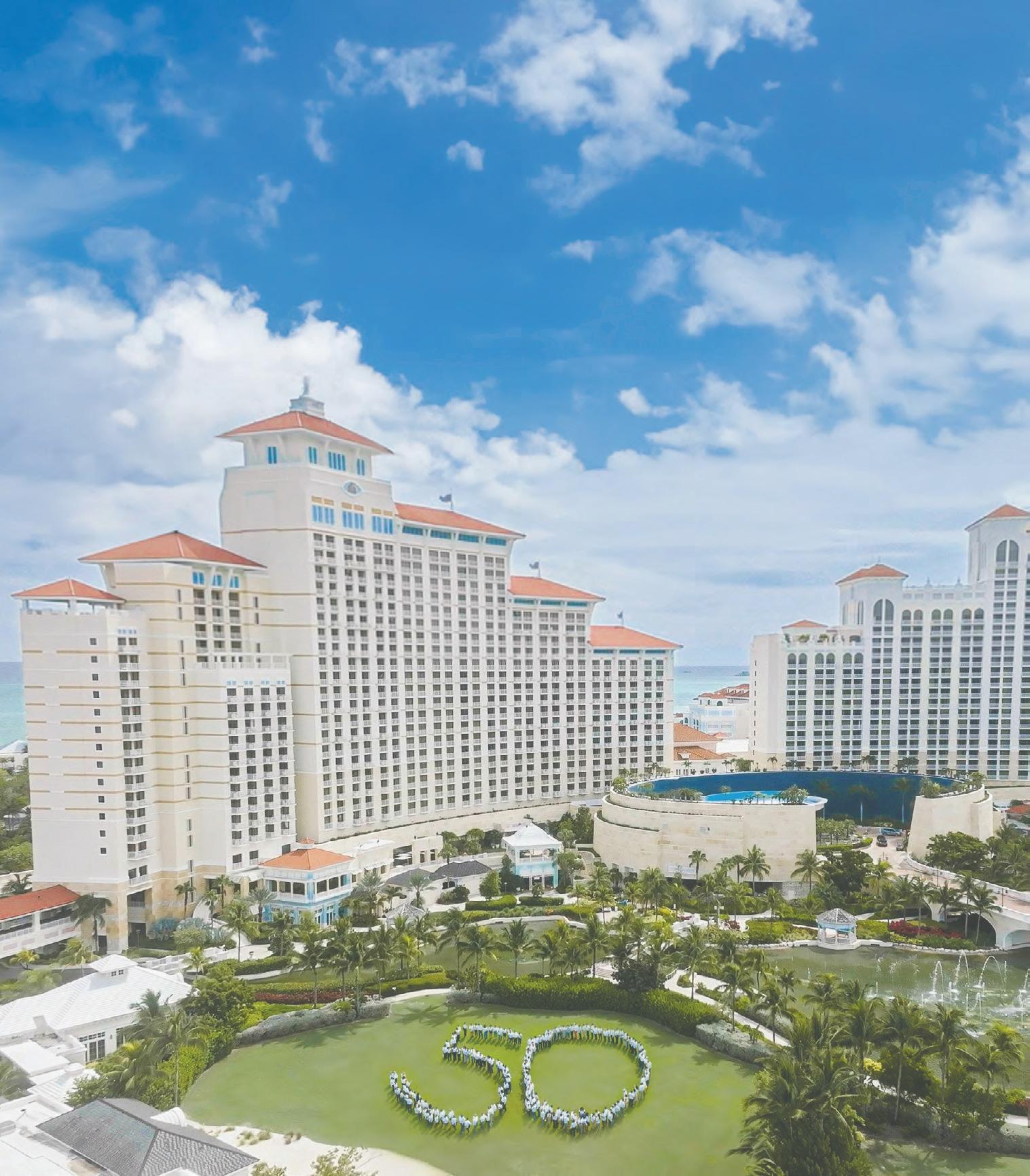

THE OH-SWEET melody of goatskin drums, cowbells, and whistles is synonymous with the cultural phenomenon called Junkanoo.
Thousands of Bahamians have religiously attended Junkanoo’s Boxing Day and New Year’s Parade. The music of the parades is so compelling that it leaves crowds rocking to their feet.
Although Junkanoo is held throughout the Family Islands it is most notable for its dazzling parades in New Providence. Particularly Bay Street has become the stomping ground for the parades.
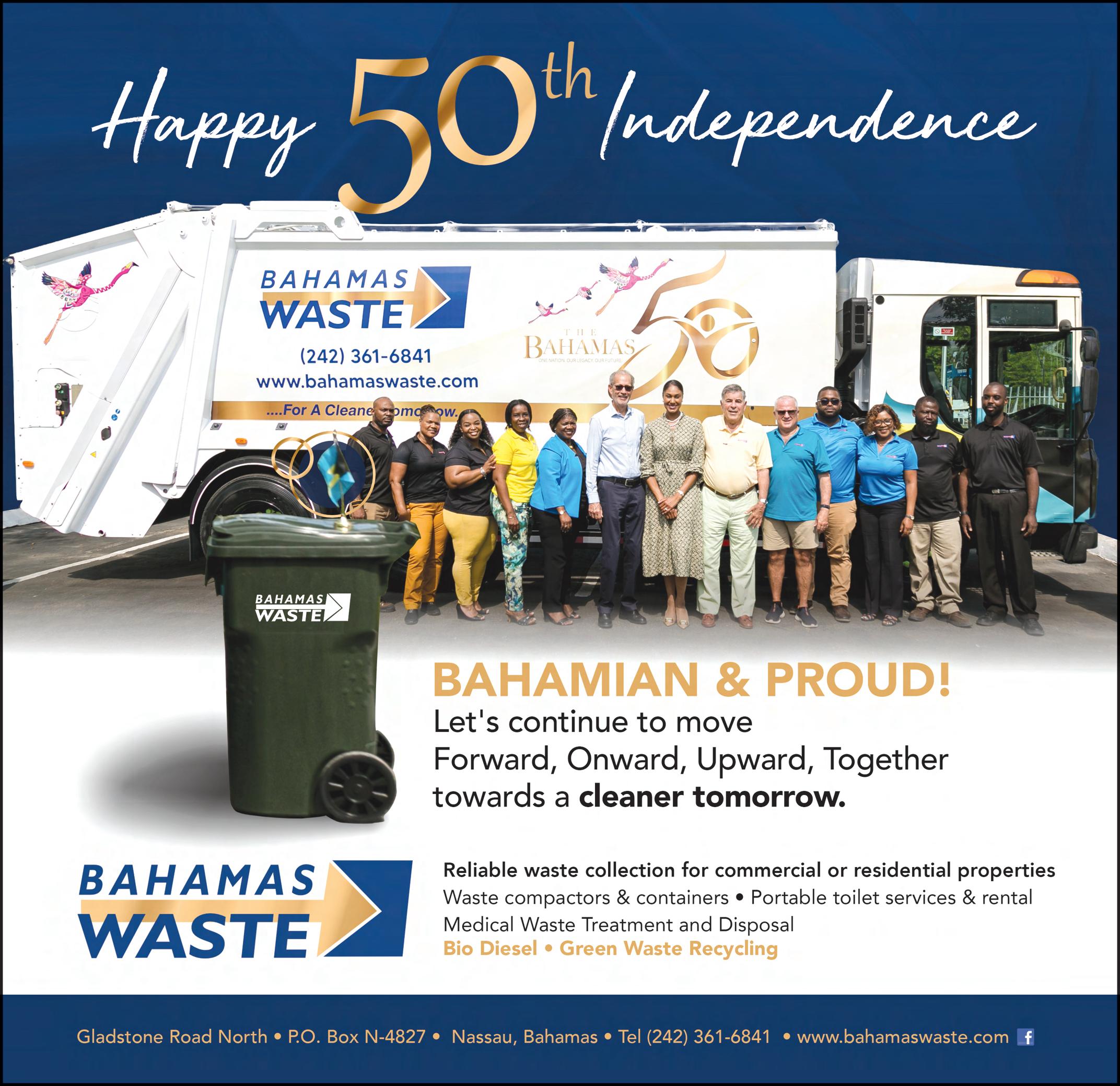
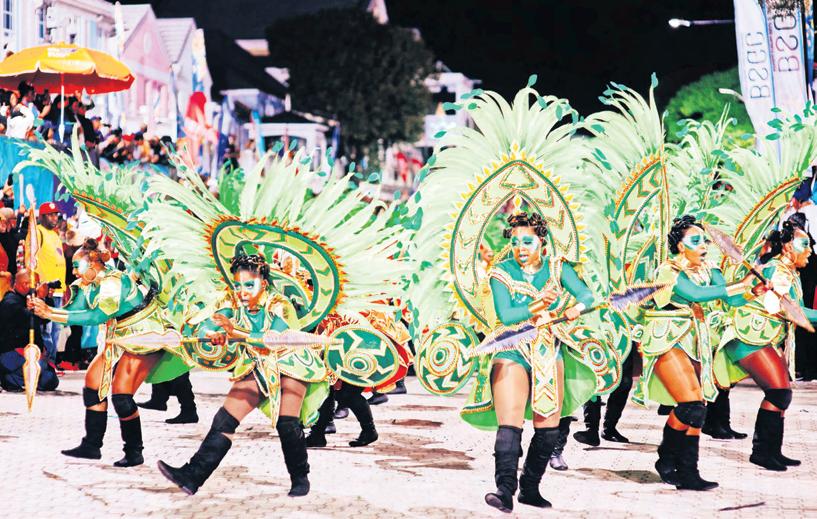
In light of the country’s 50th Independence, The Tribune spoke to several Junkanoo groups including the Roots, One Family, Valley Boys, Prodigal Sons, Saxons Superstars, Music Makers, and Genesis about the evolution of Junkanoo over the years. Representatives of the groups celebrated how far the musical parade has come and how to elevate it for the future.
The celebration of Junkanoo is linked to a great warrior king called “John Canoe” from Ghana.
Christopher Davis, a researcher at the Antiquities, Monuments and Museum Corporation, told The Tribune the parade is a
commemoration of the warrior because he courageously fought against the transatlantic slave trade.
Alexander
Doyle Burrows, one of the founding fathers of the Valley Boys, has been in Junkanoo for over 60 years. He said in the 1940s–1960s Junkanoo was frowned upon.
He explained the parade was seen for “second-class people” in The Bahamas.
Mr Burrows said up until 1965 participants of Junkanoo would hide their faces with masks made up of screen wire. Although many people loved the festival, it was still heavily discriminated against.
“They had this fear that Junkanoo was for ruffians and rogues,”
Mr Burrows said. “In essence, respectable people as far as they were concerned in those days weren’t inwardly involved with participating in Junkanoo.”
Mr Burrows noted Junkanoo was quite simpler back then in fashion. There were no large groups, fancy costumes, or range of instruments.
“The music has changed tremendously, Mr Burrows exclaimed. “In the 50s Junkanoo didn’t have very many instruments you might have had a cow horn or a bugle, some cowbells, and whistles. That was the raw Junkanoo music at the time. You didn’t have like today Junkanoo which is the clarinet, saxophone, and trumpet.”
Many fear the true essence of the “old school Junkanoo music” is slowly fading away. When The Tribune contacted several of the Junkanoo groups, all of them supported the growth of the cultural parade.


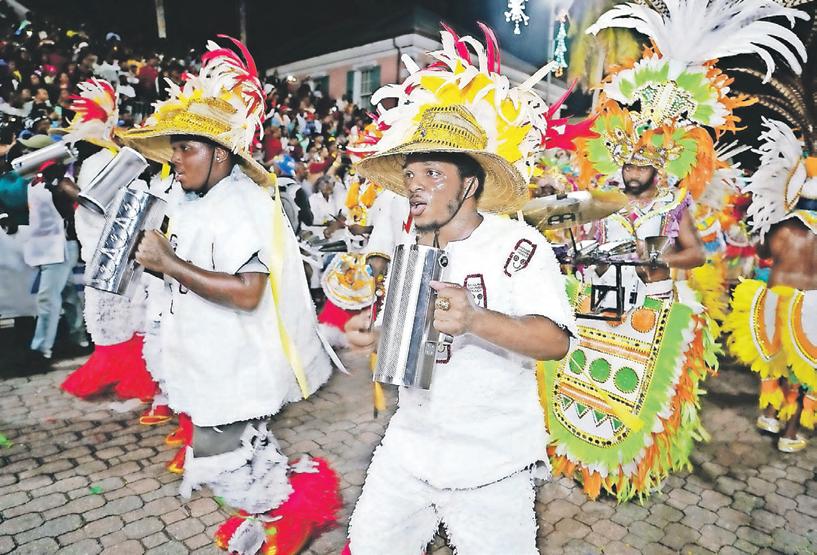
However, some groups encouraged certain traditions of Junkanoo to be practiced. Gary Russell, Music Makers’ long-term chairman, mentioned the traditional way of pasting, fringing, and decorating parade displays.
Mr Russell also said the brass sections in the parades have become overwhelming, adding some groups are beginning to sound more like marching bands.
“The brass is out of hand,” Mr Russell said. “Sometimes you got groups with 200 people in the brass. Junkanoo is becoming like a marching band whereas you cannot hear the backline.”
Mr Russell continued: “You’re supposed to be able to hear a clear distinction between the horns, the bass drums, the rhythm drums, and the cowbells.”
For his part, Owen “Big O” Stubbs, co-founder of Genesis, said they have experienced a change in their costume preparations over the years through the use of a myriad of new materials outside of the traditional crepe paper and fringing.
“As far as the music is concerned, we have been successful in preserving most of the essence of the original Junkanoo sound by widely maintaining the use of instruments such as the goat skin drum, cowbells and fog horn,” Mr Stubbs said.
“However, the heavy infusion of brass instruments in today’s parade has given the music quite a different feel from that of the early years of Junkanoo. I am of the opinion that a balance must be maintained between our original instrumentation and brass in order to maintain our uniqueness,” Mr Stubbs added.

Meanwhile, Duane Ellis, chairman of Roots, said he believes Junkanoo has lost some of its core values, however he still praised how far it has come.
“It’s so commercialised, everything is now with the glamour, glitter, decoration, the feathers, and the brass. Also, Junkanoo was strictly cardboard and crepe paper and it kept everything in perspective. Then we commercialised it and kind of merged it with carnival,” Mr Ellis said.
Despite concerns of the representatives in Music Makers, the Roots, and Genesis, they all celebrated how far Junkanoo has come positively as well. The groups highlighted how Junkanoo had progressed in its community impact, creativity, talent, and much more.
Kendenique Campbell-Moss, Saxons’ public relations director, expressed confidence in the evolution of Junkanoo.
“Junkanoo must evolve if we want longevity, we must recreate what we see - look at it in terms of the Super Bowl,” Ms CampbellMoss said.”If we want to be global and if we want to take Junkanoo beyond Bay we must evolve as a people, as a community. The talent is there, it just has to be tapped into.”
Ms Campbell-Moss noted many people who speak on the cultural phenomenon have never even been inside a Junkanoo shack before.
“We cannot say out of one mouth we want a larger playing field if we remain stagnant. Evolution is paramount, it’s as simple as that,” she said.
For his part, Anthony Coakley, One Family’s public relations coordinator, said each generation has contributed to the growth of Junkanoo.
“If we did Junkanoo the way it always was or originally, we would still be in sponge and old newspaper; we would still be in old cloth or anything you could find to jump up in the streets,” Mr Coakley said.
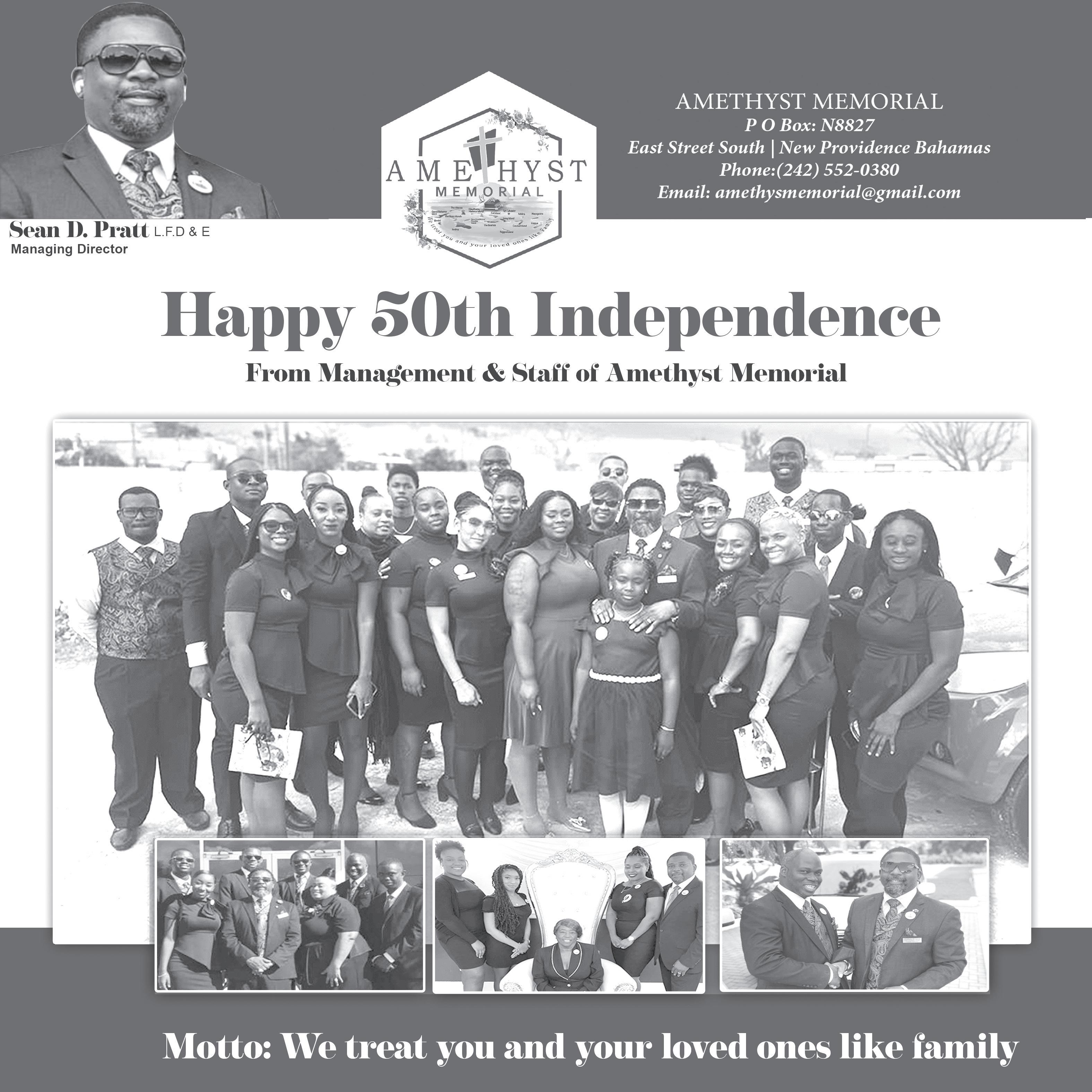
“But it has evolved, it has constantly been evolving. And that’s
because every generation puts their own signature or fingerprint on the Junkanoo presentation,” Mr Coakley added.
After more than a two-year hiatus due to the COVID-19 pandemic, the parade drew thousands of people who came to witness the 2022 Junkanoo Boxing Day Parade. Some people in the crowd that night screamed “We back on Bay, baby” and others danced on their feet to the pounding drums and cowbells.
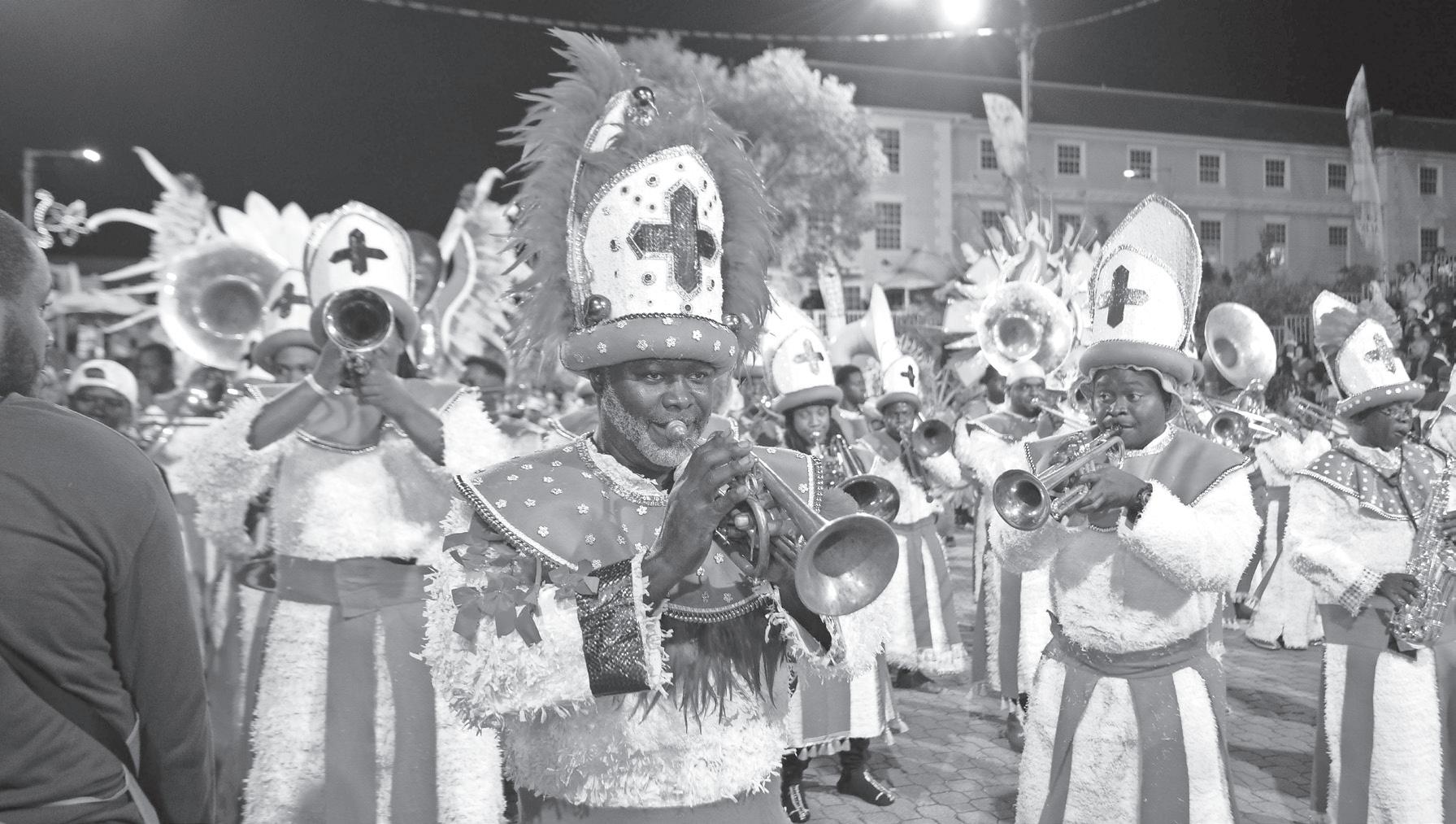
One Family was the winner of the 2022 Junkanoo Boxing Day Parade and the New Year’s Parade.
Despite the pandemic being a challenging time, representatives of the Junkanoo groups said the return to Bay Street was overwhelming with excitement, joy, and gratitude.
Eric Knowles, leader of the Prodigal Sons, experienced his own tragedy when the group’s Junkanoo shack went into flames weeks before the parade. He described the shack as a “home” for the members where they could create freely.
“It was very disappointing,” Mr Knowles said. “A lot of people were disappointed but at the end of the day you have hard times, that’s how life is. You have your highs and lows; you only can thank God every day. And hope that He would continue to guide and protect you.”
Mr Knowles said his group is back and better, noting he’s confident they will compete this year.
For his part, Youth Sports and Culture Minister Mario Bowleg said he was excited about Junkanoo’s return. He described it as the “greatest expression” of our culture.
Although there has been some criticism about the government’s funding of the Junkanoo parades. Mr Bowleg said the government is giving its best efforts to support it.
“Even though Junkanoo at this present time takes the largest portion of the budget for culture within the culture department,” Mr Bowleg said. We must not forget the entertainers, the performing artists, we must not forget the literary writers and all of those other people who make up culture,” Mr Bowleg said.
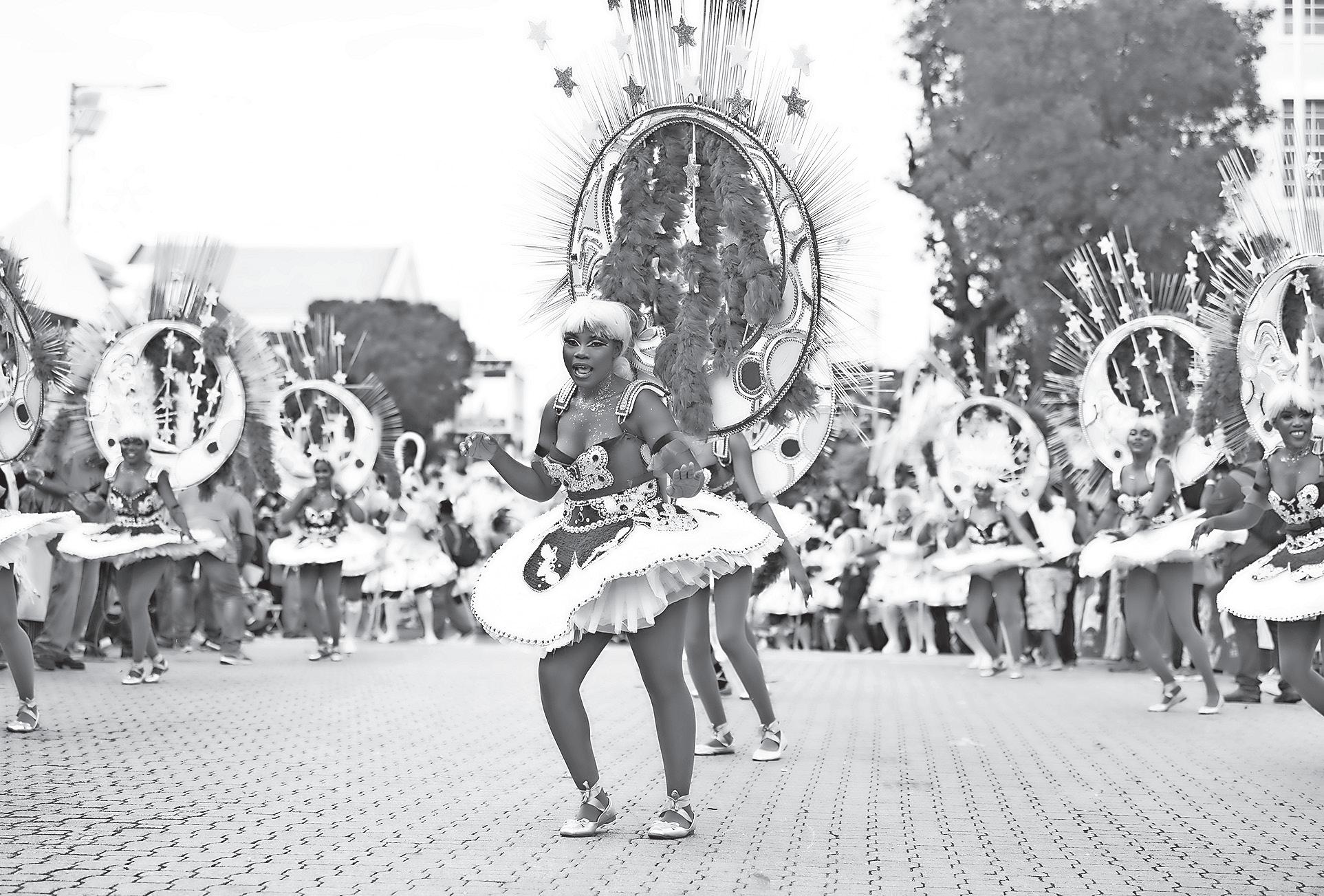
“But I can assure you I’m looking for some great things for Junkanoo moving forward. I have some things in the pipeline that I would not say as yet,” Mr bowleg exclaimed.
Meanwhile, former Prime Minister Dr Hubert Minnis also shared excitement about the return of Junkanoo. He said he’s been rushing in the Saxons for over 30 years.
“I’d like to see even more done for Junkanoo just like how reggae is synonymous with Jamaica. We could reach a point where anytime Junkanoo is heard anywhere around the world and you want other artists to incorporate Junkanoo in their songs,” Dr Minnis said.
Dr Minnis described Junkanoo as one of the leading cultural extravaganzas in The Bahamas. “But it’s a feeling we had missed that feeling of freedom and once Junkanoo started again that feeling returned,” Dr Minnis said.

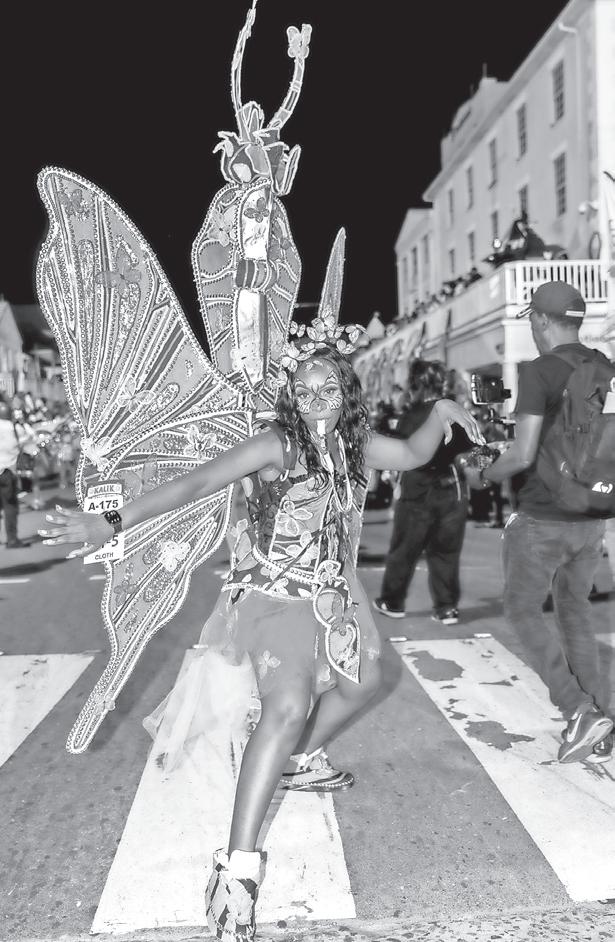
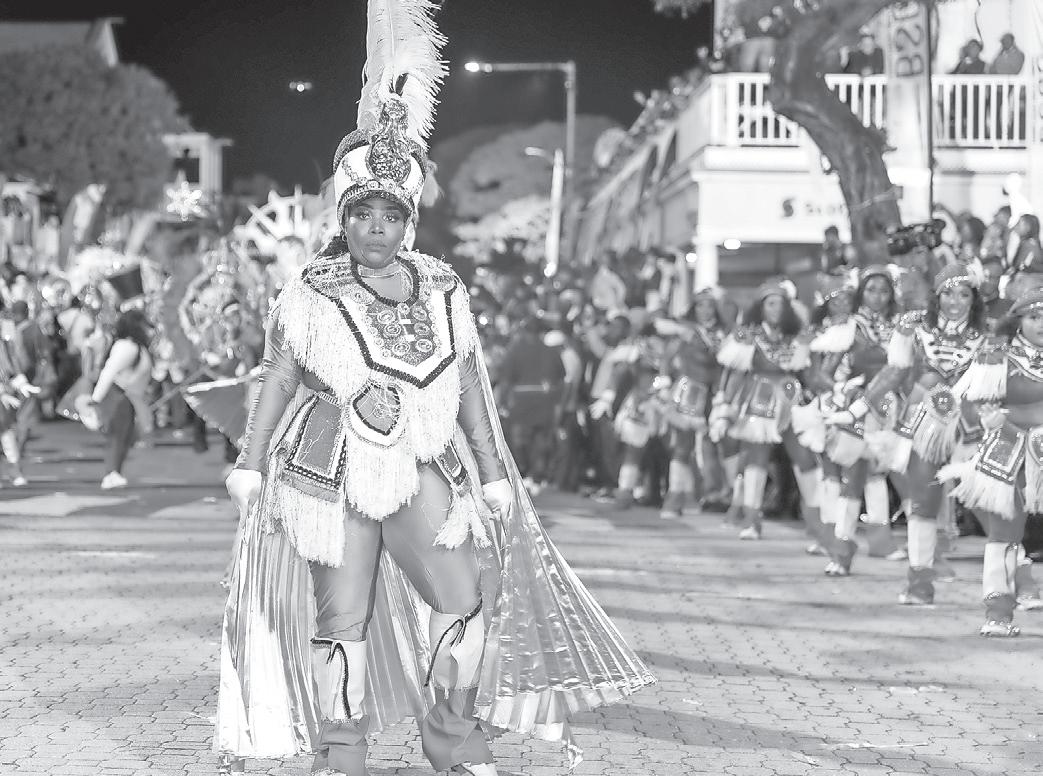
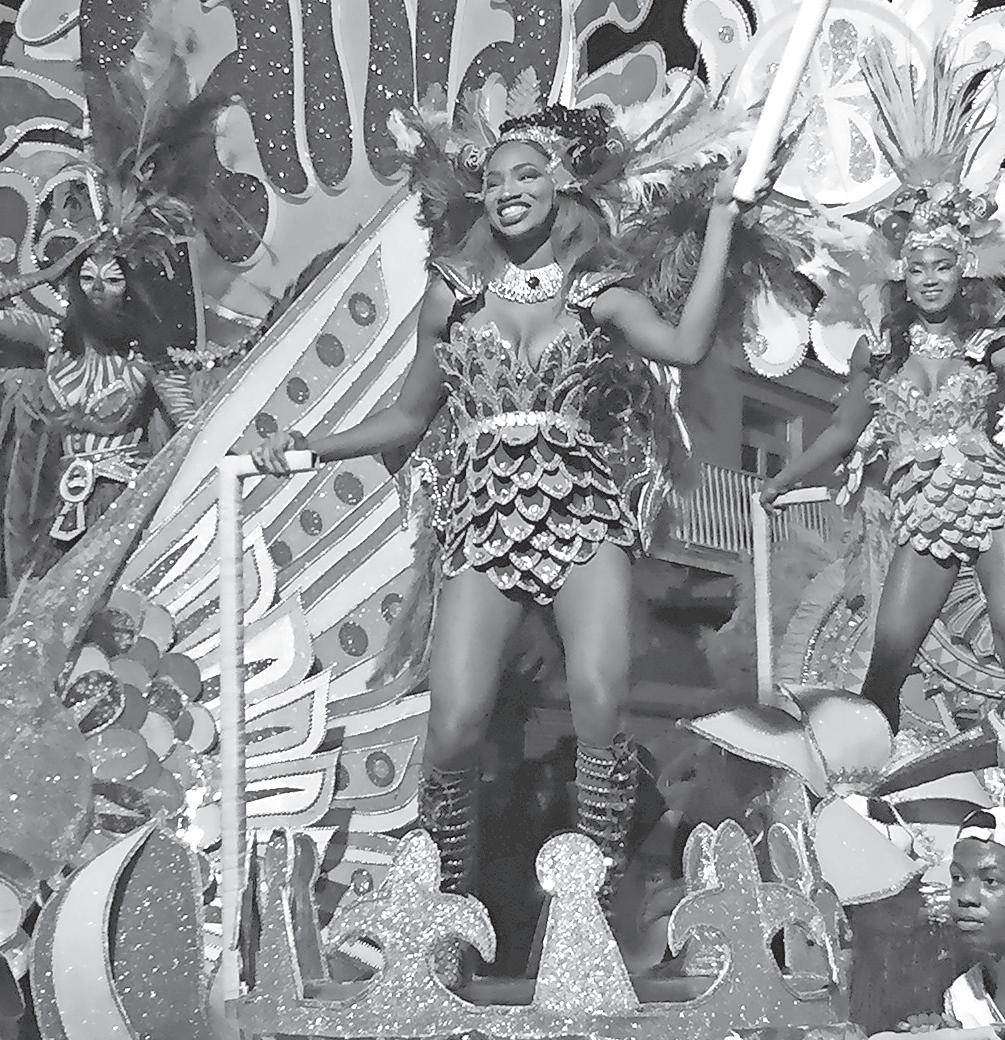
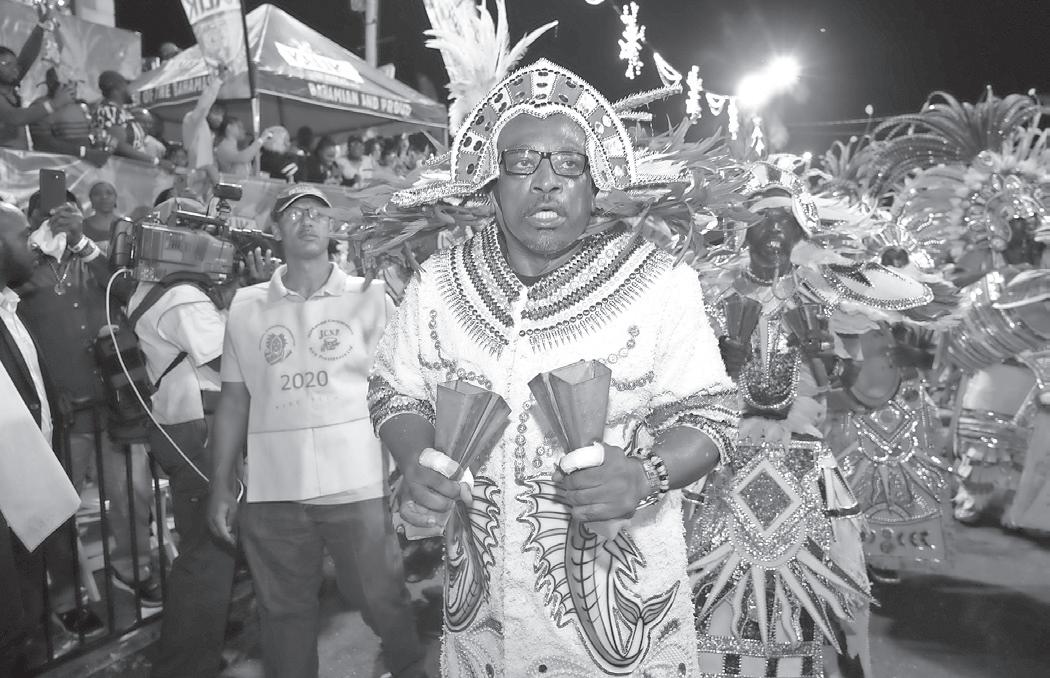
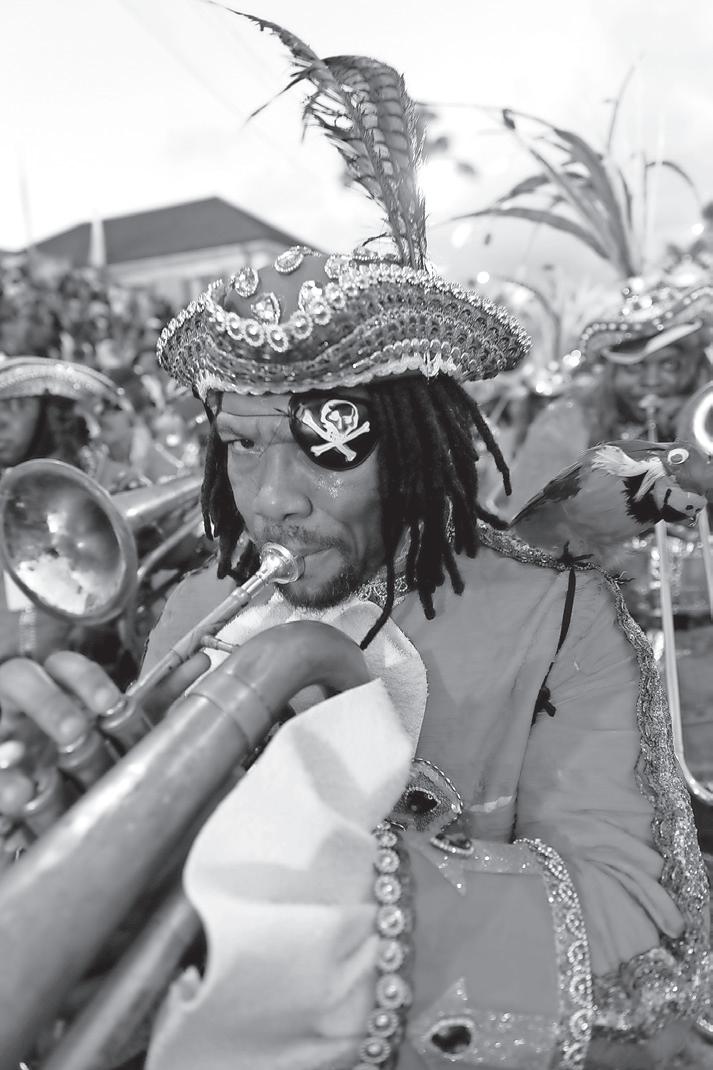
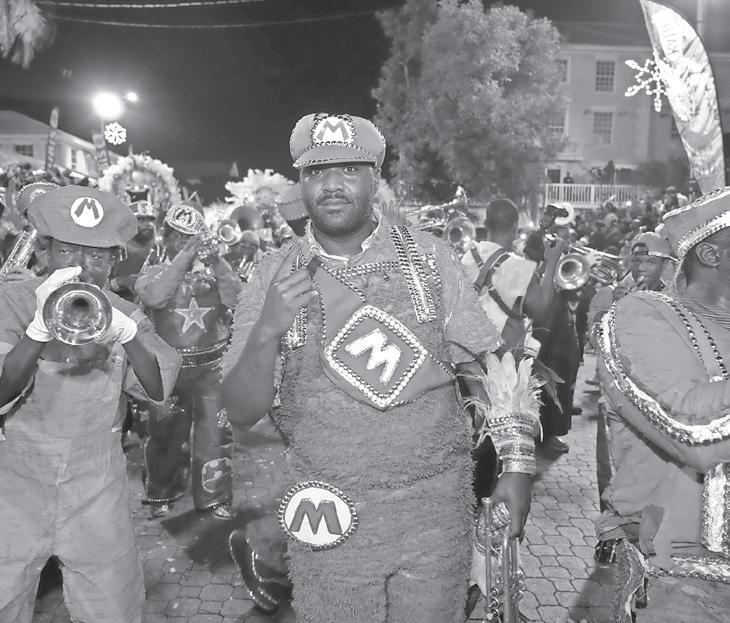
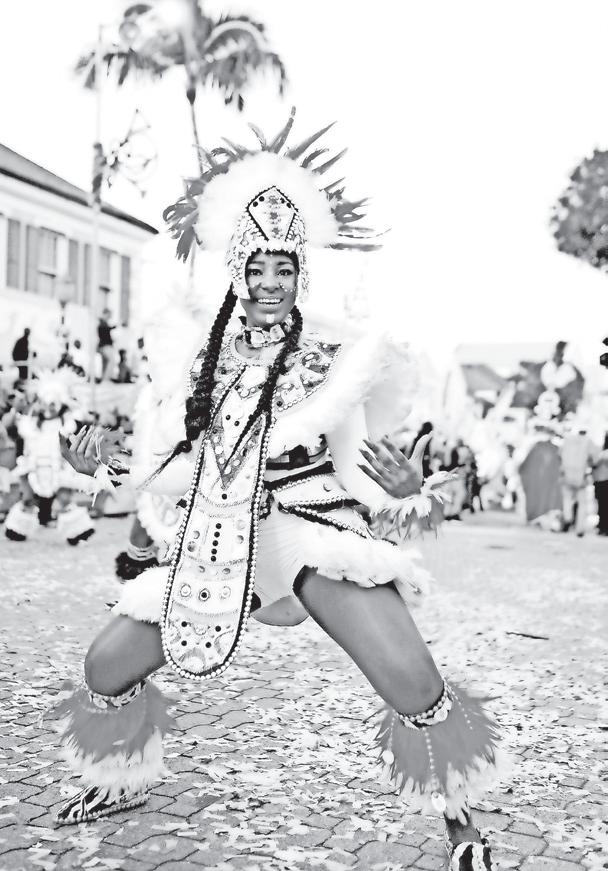
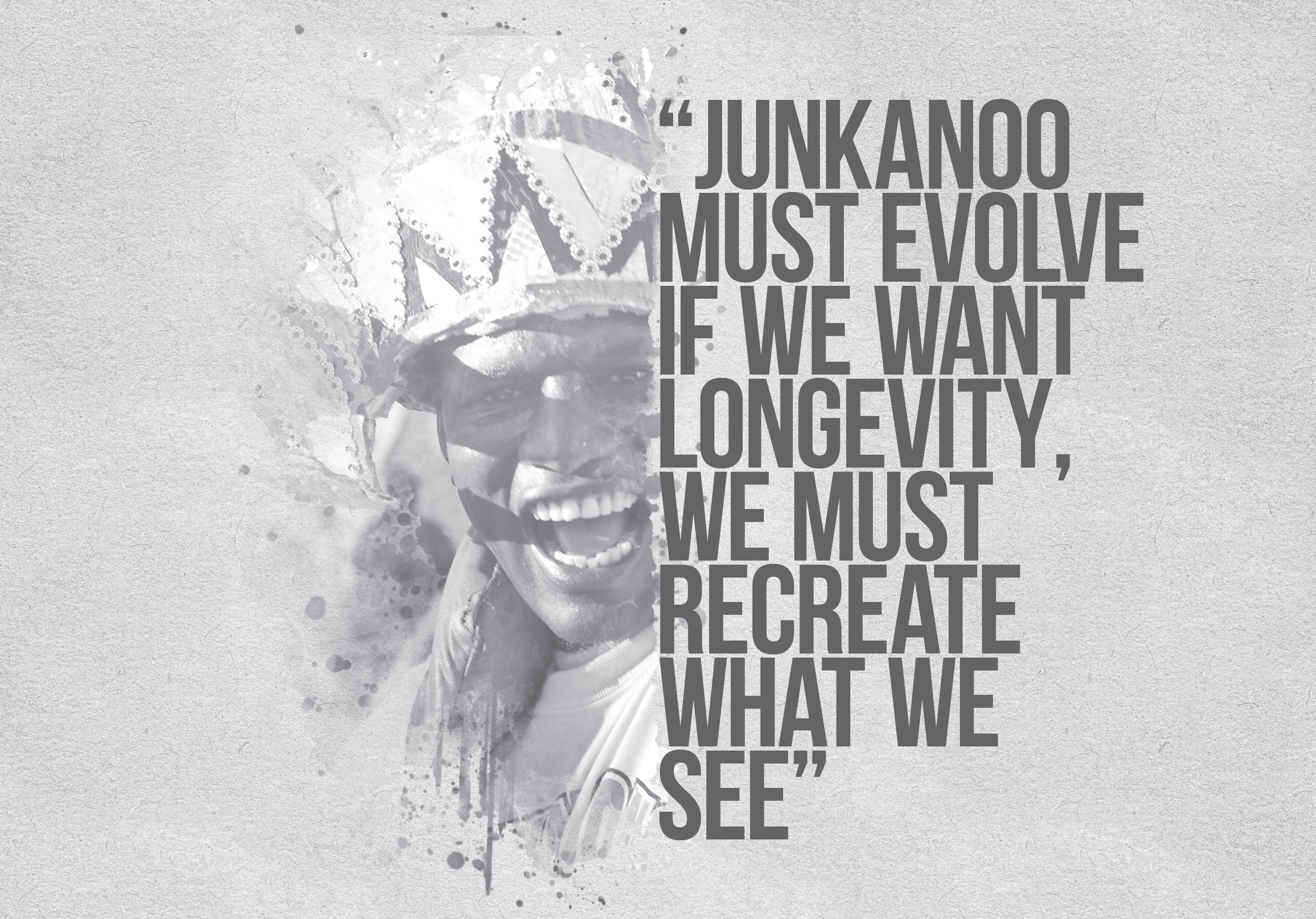


In terms of changes for Junkanoo in the future, the group’s representatives gave varying answers. However, the Roots, One Family, Valley Boys, Prodigal Sons, Saxons Superstars, Music Makers, and Genesis all encouraged Junkanoo to be preserved.
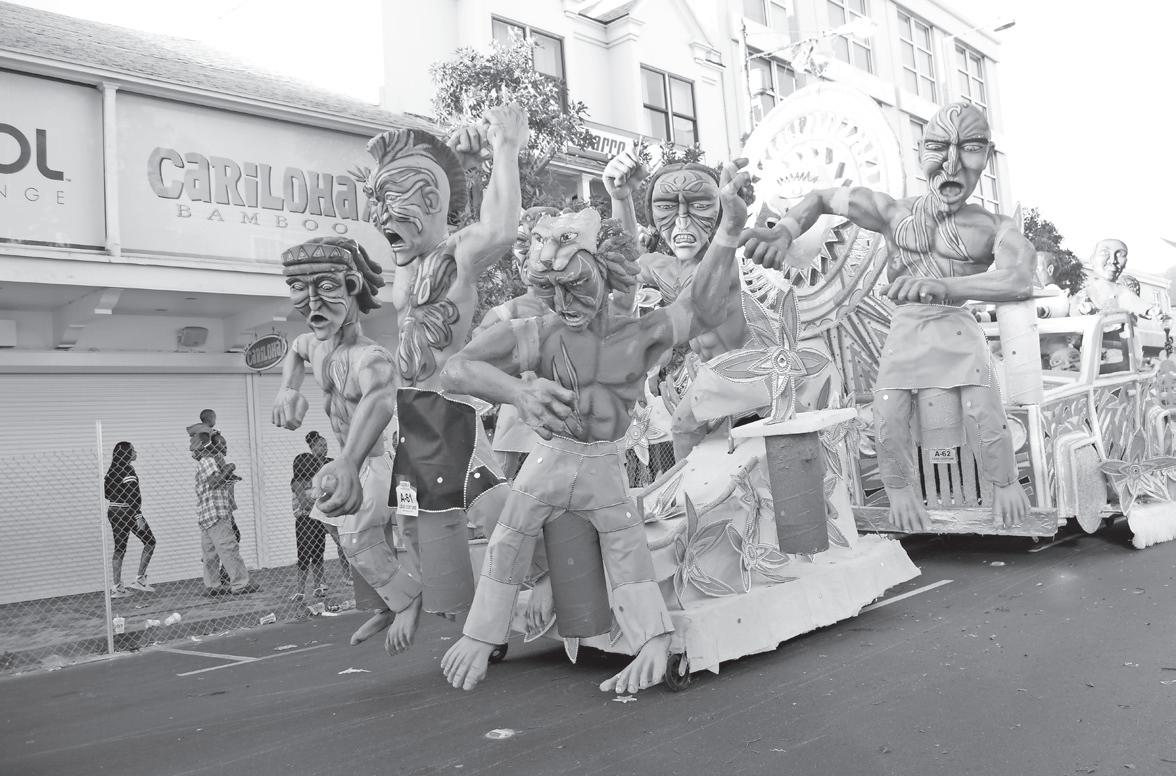
Some changes suggested by the groups were Junkanoo being taught as a curriculum in schools and giving more recognition to the leading contributors of Junkanoo over the years. Also, some noted the parade could be held more than twice a year and could be performed in another location besides Bay Street.
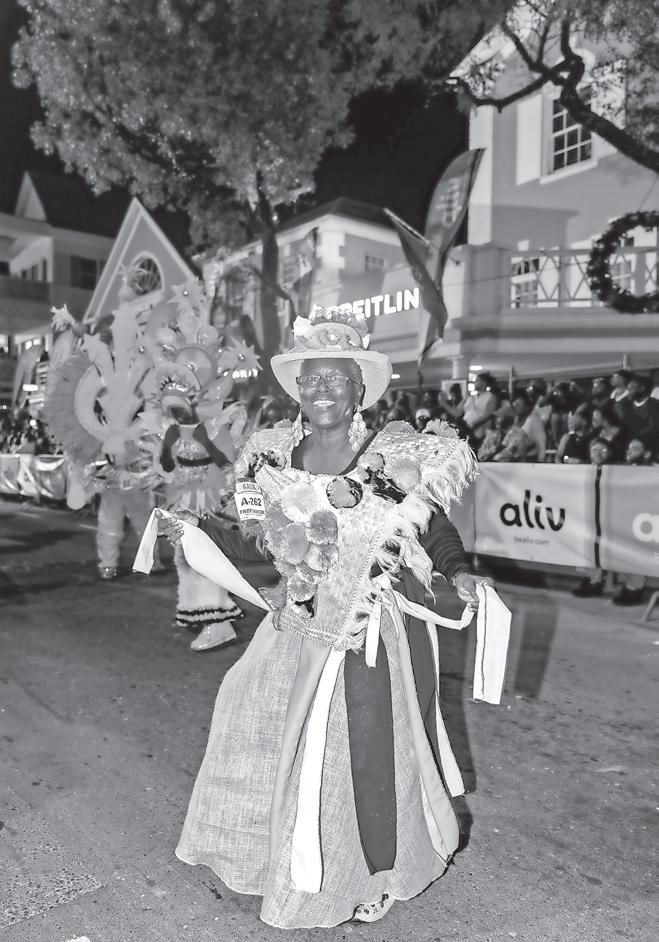

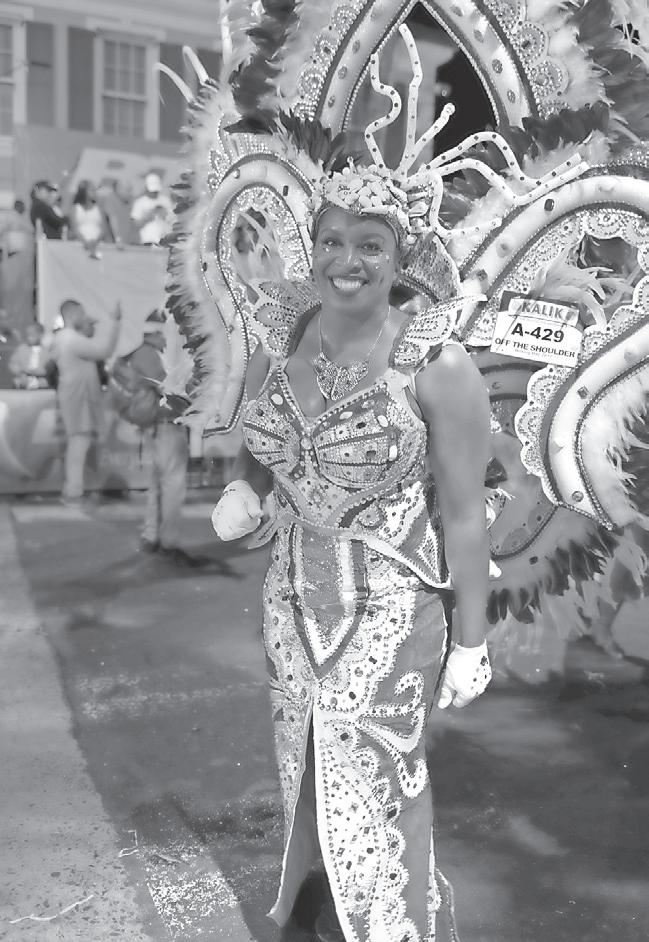
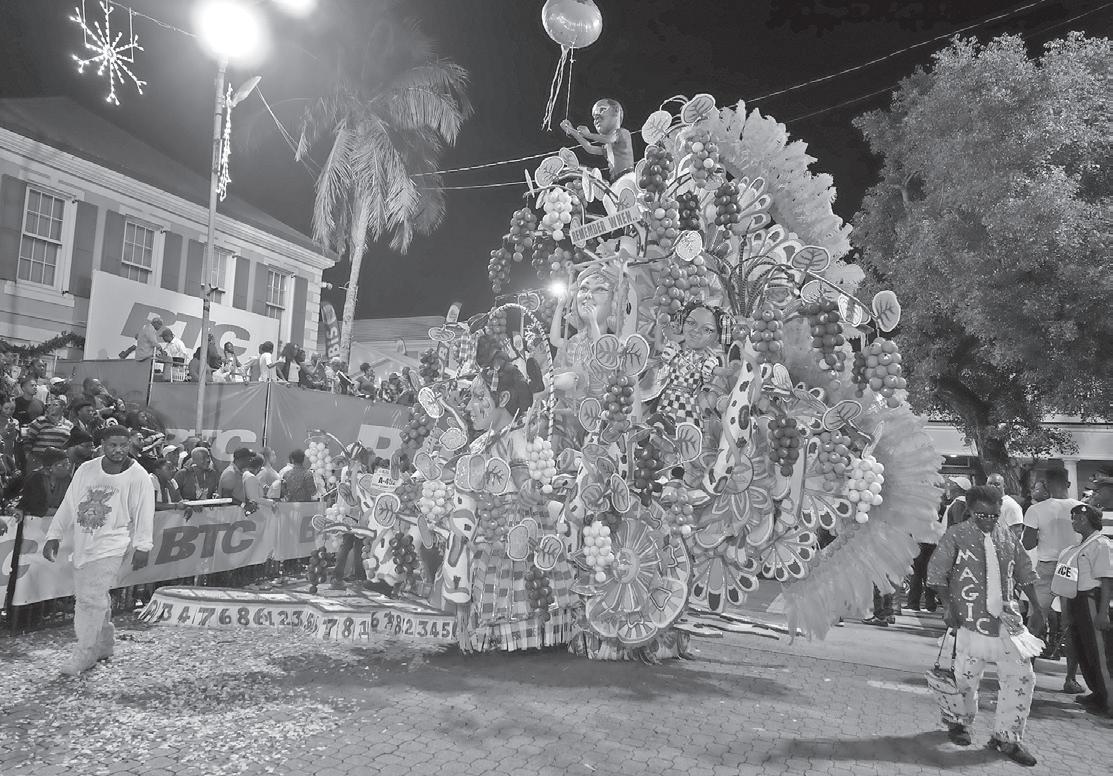
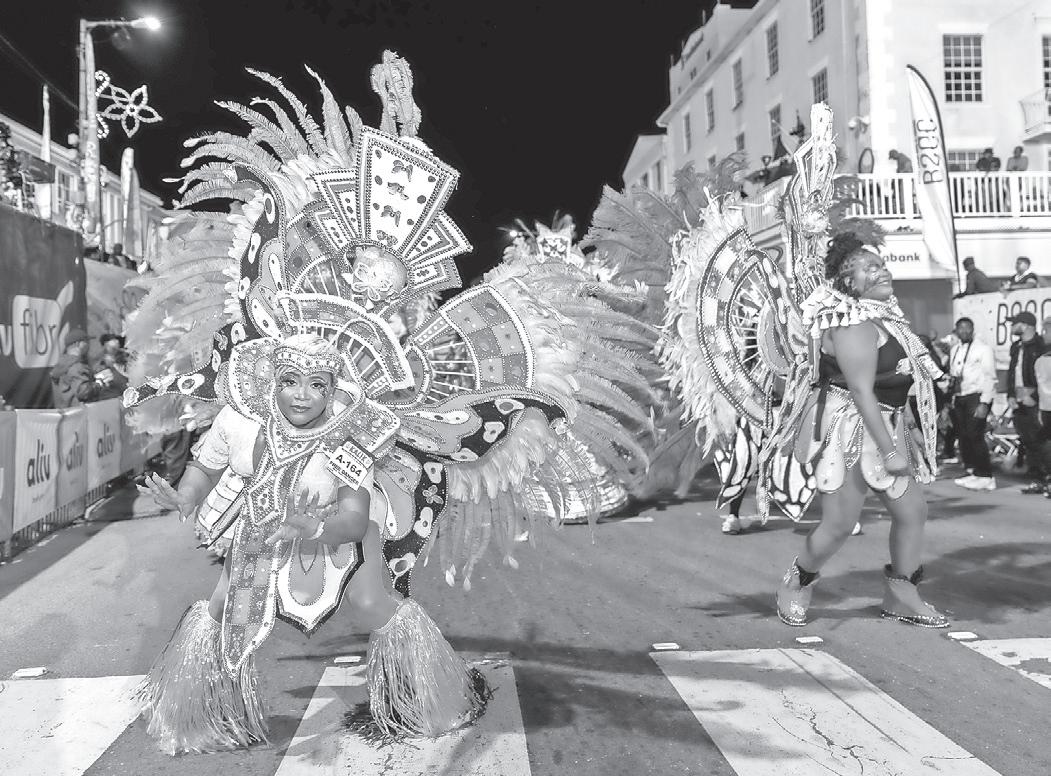
I CAN still remember the patriotic scene at Clifford Park. Immense excitement, pride and optimism filled the atmosphere as Bahamians everywhere prepared for the birth of their new nation. Taking in the view from my mother’s arms, I felt a strong sense of hope and belonging.
Five decades later, those emotions still swirl through me as I reflect on The Bahamas’ journey to its golden anniversary. The
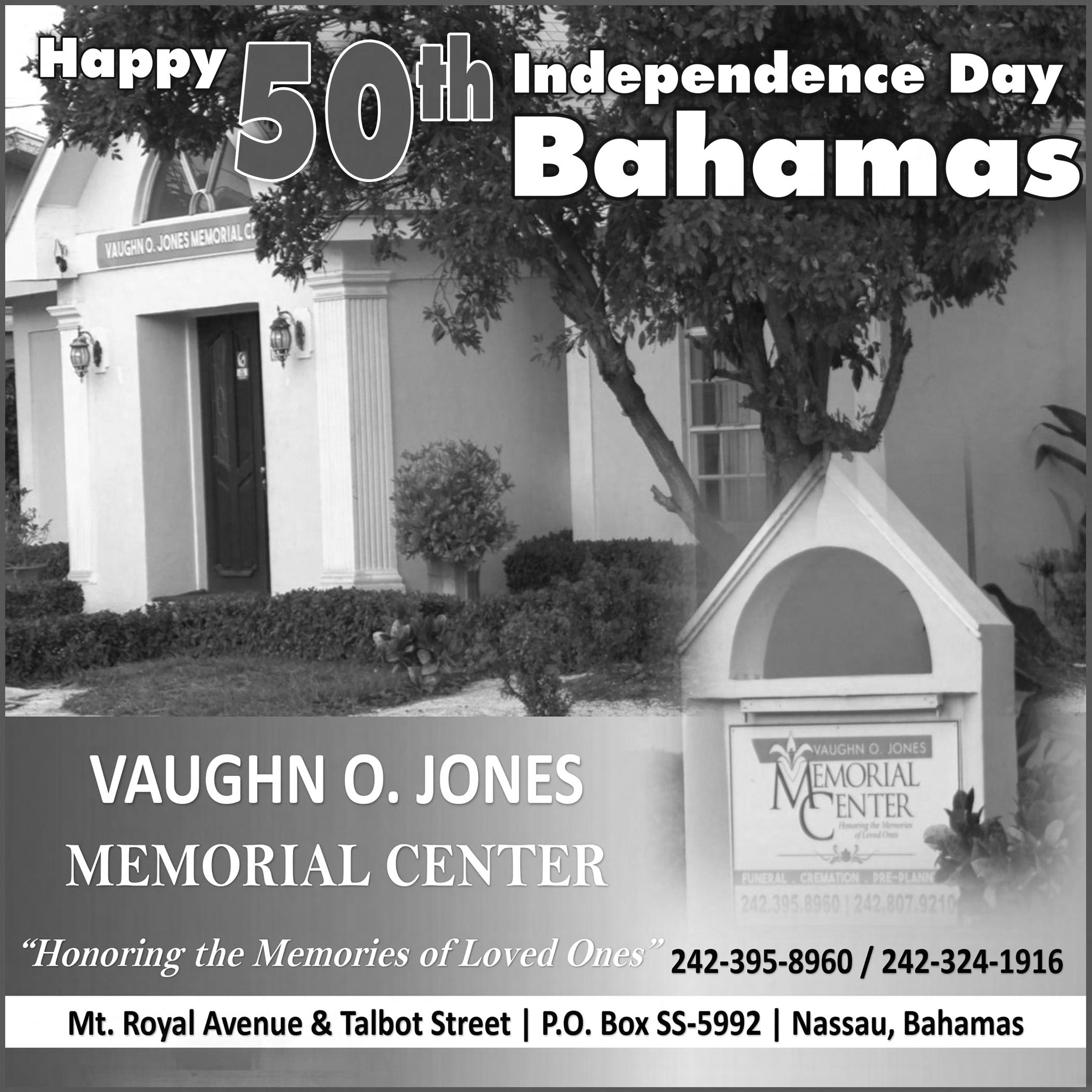
“road to 50” wasn’t easy. Some doubted the ideology of Majority Rule and wondered whether the feat of an independent Bahamaland could ever truly be accomplished. However, July 10th 1973 proved what was possible — and we have been raising the bar of what we can achieve ever since. I was a little girl at the time of Independence, and it has been the honor of my life to grow up alongside my country. I recall those early years of nation building and the creation of the institutions needed for public life: the Central Bank of The Bahamas, the National Insurance Board,
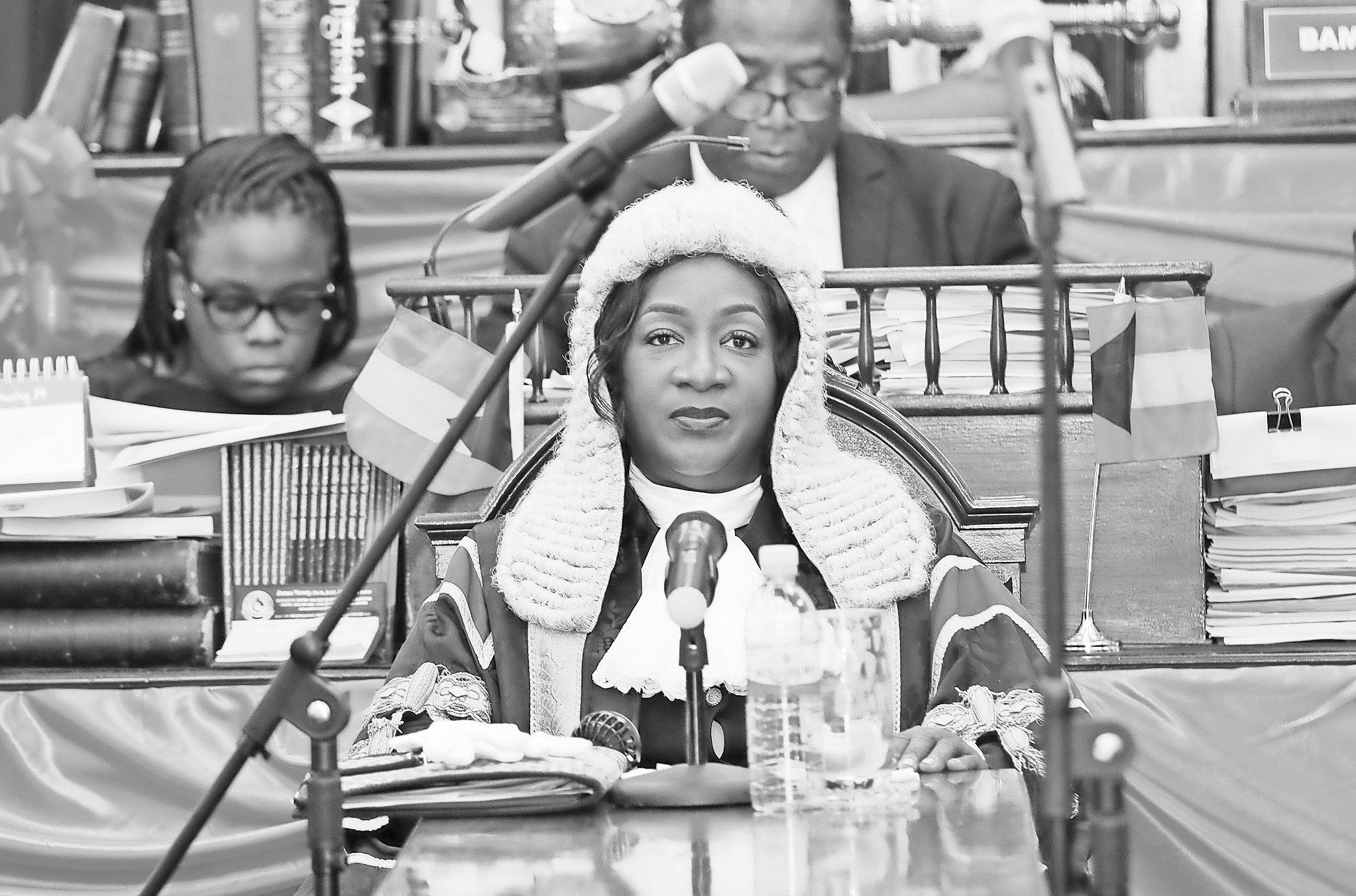
the College of The Bahamas, and so many others. I remember the public figures who seemed larger than life, such as Sir Lynden Pindling, Sir Milo Butler, Dame Doris Johnson, Janet Bostwick, and the many other politicians who participated in our burgeoning democracy.
I also remember the people who raised me: my extended family and other members of the communities in Chippingham, New Providence; Driggs Hill, South Andros and Burnt Ground, Long Island. Seeing their dedication to their trades in construction, dressmaking,
preaching, fishing, boatbuilding, farming, small business ownership, and so many more taught me everything I needed to know about the importance of hard work in building a life and building a nation.
The “road to 50” has naturally had its speed bumps, road blocks, and other impediments along the way. As a country we have experienced dark chapters, such as the sinking of the HBMS Flamingo, the scourge of drugs, the HIV/ AIDS epidemic, and devastating hurricanes including monster storm Dorian.
But our strong Christian principles combined with
sharp political and business acumen have turned us into a resilient people.
Our little country is known throughout the world for its beauty. Our athletes have shown the world that a population’s size isn’t what determines victory, but it is a strong will, determination, and hard work that elevates a country. Our people have made stunning accomplishments in virtually every major industry. Five decades after Independence, we have truly shown the world the manner of our bearing.
Under the visionary leadership of Prime Minister Philip “Brave” Davis,
The Bahamas continues to lead the way to a sustainable future by placing high emphasis on mitigating climate change and increasing food security. I look forward to all that our great nation will achieve in the years to come.
On behalf of the Senate of the Commonwealth of the Bahamas, I extend sincere congratulations to the Bahamians on every island and cay, and throughout the length and breadth of this planet, on achieving such a momentous and remarkable milestone.
Happy Independence! Steady sunward, march on Bahamaland!
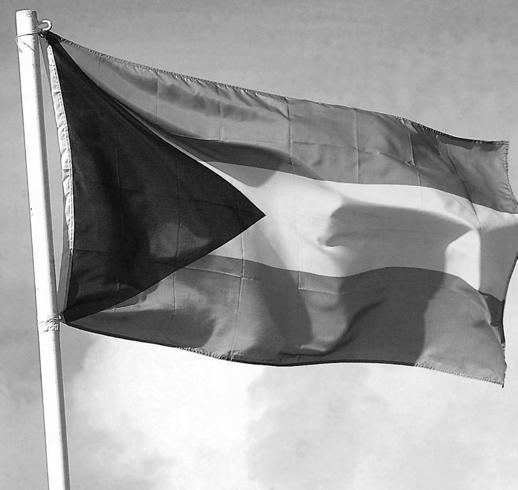
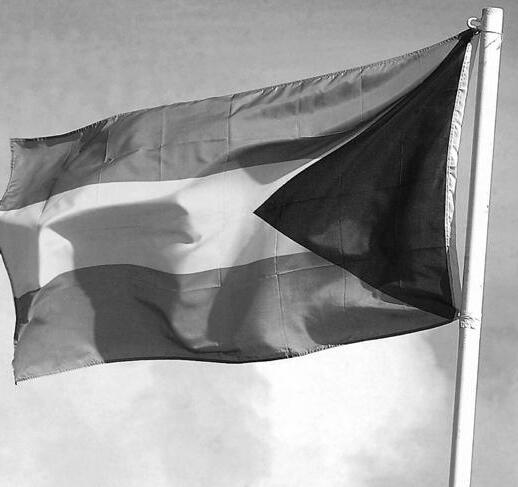
IN JULY 2073, the Bahamas will celebrate 100 years as a sovereign nation. Much of 2023 has been rightfully devoted to reflecting on the people and events that have contributed to the country’s development over the past 50 years. This commemoration is important, as we pay homage to our foremothers and forefathers and have occasion to celebrate in light of the national difficulties of the past few years, as the country emerges from the twin traumas of Hurricane Dorian and the COVID-19 pandemic.
But a chance to reflect is also a moment to consider where we would like to go. What will The Bahamas’ next 50 years look like? And what can be done to ensure that when future generations look at the “road to 100” years of independence, they can proudly say that we made steps to ensure that their road is smoother, their load lighter, and their future more secure? To make this vision a reality, key areas of focus should include Family Island development, diversifying the economy, and climate change security and resiliency.
The Bahamas is an archipelagic nation, blessed with over 700 islands and cays. As is the case with many countries around the world, urban development over the past 50 years has led to a massive population shift from the Family Islands to the cities of New Providence and Grand Bahama Island. New Providence in particular now supports 75 percent of the country’s population.
As is the case with many countries around the world, such migration to urban centers, in conjunction with other socioeconomic factors, provides both opportunities for economic advancement as well as an outsized capacity for social ills, ranging from high rates of violent crime to traffic congestion.
Conversely, many Family Islands are becoming sparsely populated and persistently underdeveloped. Many Bahamians are proud of their Family Island heritages, tracing their ancestry through last names and family lore. As tourist destinations, these islands are promoted as ecotourism havens, touted for their natural beauty and slower pace away from the “hustle and bustle” of the capital.
However, lack of economic opportunities, poor access to government services, a high cost of living, and other factors contribute to why many locals choose to migrate from Family Islands.
This is unfortunate, as much of The Bahamas’ uniqueness lies in its geography. The country features some of the largest islands in the Caribbean region, including North and South Andros islands, Great Inagua Island, Grand Bahama Island, Great Abaco Island, Eleuthera, Acklins, and Long Island. With a national population of approximately 400,000, these islands have the capacity to support more people. A key goal of the next 50 years should be to encourage the development of Family Islands, while keeping the realities of climate change in mind – building key infrastructure in areas less prone to flooding and providing added support for
areas that are more vulnerable to storms and sea level rise.
Local, traditional industries should be supported in conjunction with newer roles in the digital economy – bolstered by the opportunities of remote work. The goal should be improving opportunities and access for existing communities while also making it possible for more Bahamians to have options outside of the capital.
In this vein, The Bahamas’ economy should be diversified and thus less reliant on tourism which accounts for 50 percent of the country’s Gross Domestic Product (GDP) and 60 percent of employment. The COVID-19 pandemic was a pivotal example of the dangers of being overly reliant on one industry.
As public health measures and concerns ground international travel to a halt in 2020, the Bahamas’ major industry was brought to its knees. The repercussions were severe, with thousands of people out work and the closure of hotels such as the Hilton in New Providence and Club Med in San Salvador.
Three years after the onset of the pandemic, the tourism industry is rebounding, with the Central Bank of the Bahamas reporting that stopover tourist arrivals in May 2023 hit 94% of the pre-COVID high recorded in May 2019. The government is also avidly working on the reopening of closed hotels, with Club Med reporting that, as of May 2023, 75% of its workforce has returned. This rebound is incredible news, but the economic lessons of the pandemic should not be forgotten.
For the next 50 years, the Bahamas should seek to both diversify its economy and improve its existing tourism model to ensure that more value add is generated for the country.
As is the case with many Caribbean countries, The Bahamas relies heavily on Foreign Direct Investment (FDI) to finance its tourism infrastructure, such as major resort projects. Such investments are touted as paramount for creating employment opportunities.
However, the 2012 Economic Commission for Latin America and Caribbean (ECLAC) report found that only four local jobs are created “for every $1million in FDI capital injected” into the Bahamian economy.
In February 2023, The Tribune reported remarks made by Minister for Economic Affairs Michael Halkitis at an Organisation for Responsible Governance (ORG) panel. Mr Halkitis said it was key that the government make progressive reforms in the “attraction of foreign direct investment” so that The Bahamas can pivot from historical GDP growth rates that have averaged between 1-2 percent for decades.
The Bahamas should commit to only pursuing high quality FDI, that ensures both low and high skilled jobs for locals and protects the environment. Most importantly, FDI and tourism cannot be the sole drivers of the country’s economy. Other industries should be developed and supported. In its Blueprint for Change, released ahead of the 2021
Liberal Party outlined its goals for “rescuing the economy”, citing “economic diversification, digitisation and innovation will be key to returning The Bahamas to a path of exponential growth and progress”. These goals included providing support for the blue economy, orange economy, and digital economy. Making good on these promises is important, as is ensuring that people across the archipelago have access to these emerging opportunities through location, availability of positions, and possessing the academic and technical skills needed to be successful candidates.
The biggest threat facing The Bahamas in the decades to come is an existential crisis — the grim realities of climate change. Scientists warn that if global temperature rise
isn’t kept beneath 1.5 degrees Celsius, the planet will experience devastating effects, such as the decline of coral reefs, more deadly superstorms and intense droughts, and rising sea levels.
The Bahamas is comprised of low-lying islands that are particularly at risk to these phenomena. The devastation wrought by hurricanes in recent years like Joaquin (2015), Matthew (2016), Irma (2017), and Dorian (2019) are forever imprinted on the nation’s consciousness.
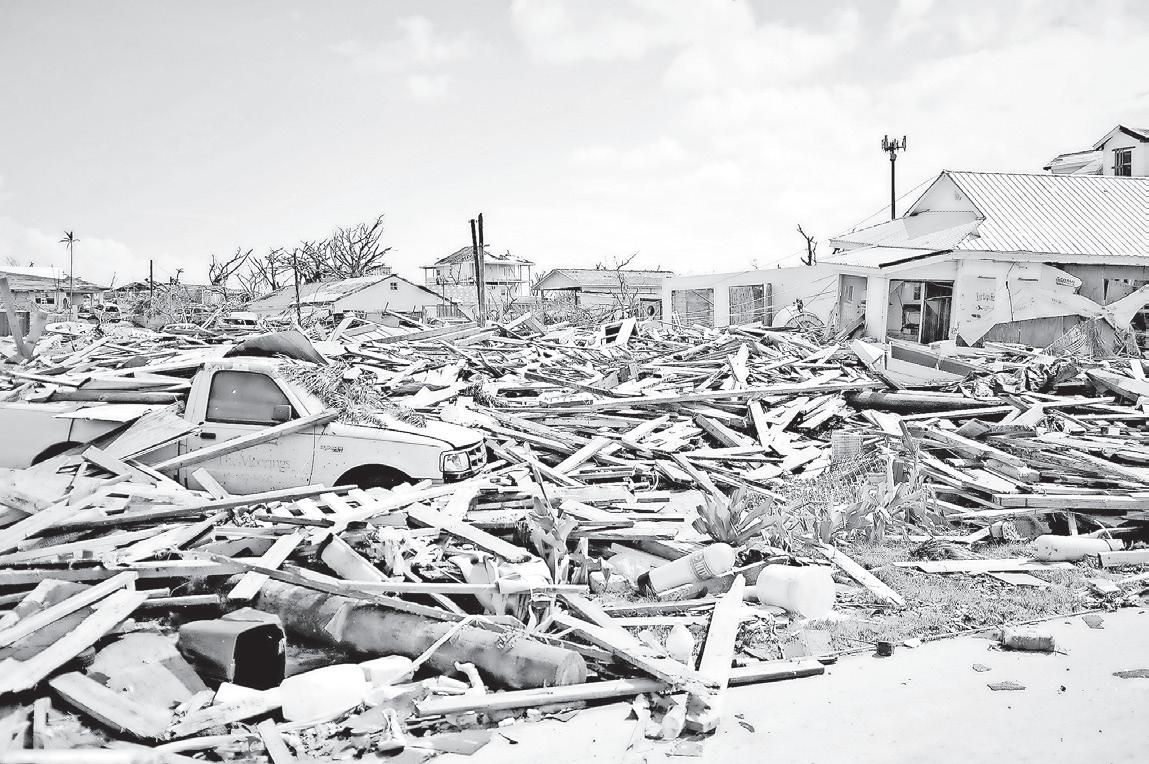
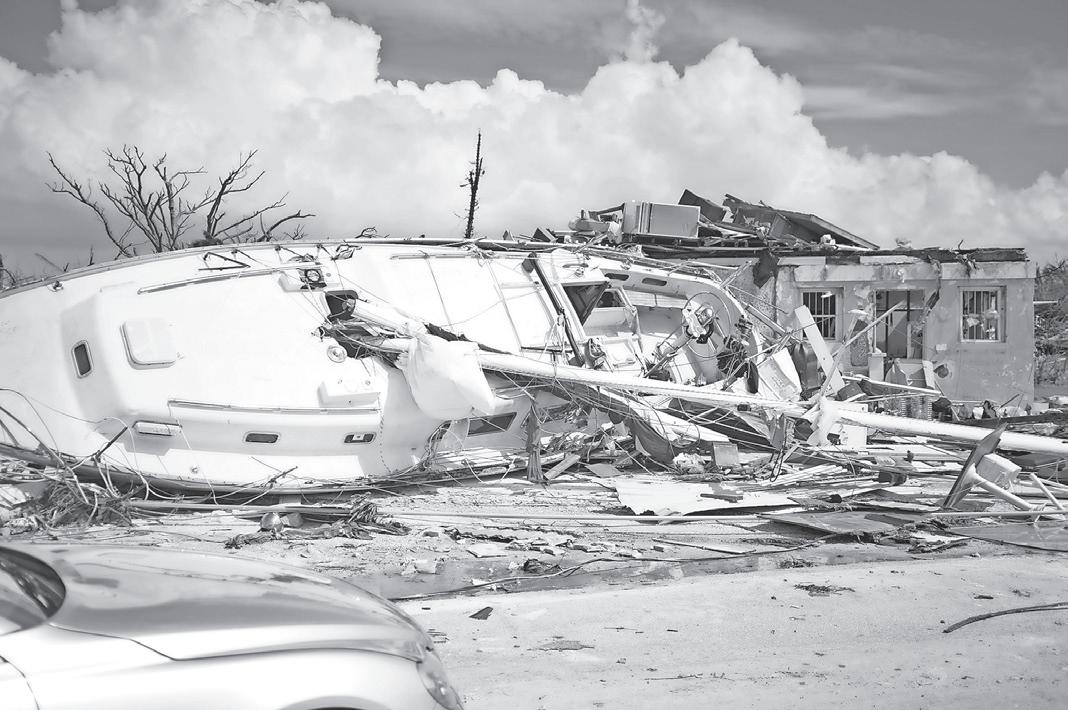
Since ascending to national office in September 2021, the Davis Administration has made combating climate change a key part of its agenda. Domestically, this mantle has taken the form of carbon credit legislation, which Prime Minister Philip “Brave” Davis has described as “a framework to com-

pensate The Bahamas for the significant role we play as a carbon sink”, and a commitment for the country to generate at least 30 percent of its energy from renewable sources by 2030.
Another method to foster climate resiliency locally is a revised building code, to ensure that the country’s infrastructure can withstand future super storms. Additionally, new housing developments should not be built in areas that are prone to excessive flooding, and relocation options for existing at-risk communities should be developed. Protecting and nurturing the environment is also critically important, especially mangroves and coral reefs, which are first lines of defense against major storms. The government should continue to partner with local and international climate scientists and experts to ensure that country planning is conducted with such long-term solutions in mind.
The Davis administration has also made climate change a key facet of its foreign policy agenda. Just weeks after being elected to office, Mr Davis urged global leaders to prioritise the fight against climate change at the 2021 United Nations Climate Change Conference (“COP26”) in Scotland.
“We in The Bahamas will do what we can,” he said, “but the limits of what our nation’s effort can accomplish are stark: we cannot out-run your carbon emissions, we cannot out-run the hurricanes which are growing more powerful and we cannot out-run rising sea levels, as our islands disappear beneath the seas.”
Mr Davis has carried this mantle at other global events, including the Caribbean Renewable Energy Forum in Miami, FL (2022), COP27 in Egypt (2022) and the Commonwealth Enterprise and Investment Council (CWEIC) Roundtable in the United Kingdom (2023). In June 2023, Mr Davis co-hosted the US-Caribbean Leaders Meeting with United States Vice President Kamala Harris. Ahead of Ms Harris’ arrival, $98m in new funding from the United States Agency for International Development was announced “to address climate, energy, food security and humanitarian assistance in the Caribbean”.
It is important that The Bahamas continues to work with regional partners and the global community to raise awareness of the perilous state Small Island Developing States (SIDS) are in due to climate change, request support for funding, and develop migration and mitigation strategies.
The next 50 years are an opportunity to continue – and surpass – the work that has been started.
While it is impossible to predict all the challenges that will arise over the next 50 years, by prioritizing the areas listed above, in addition to other opportunities for fiscal, social, healthcare, legislative, and educational improvement, The Bahamas, and the Bahamian people, will be well equipped to succeed, and welcome the “road to 100” years of independence with a Junkanoo rushout for the ages.
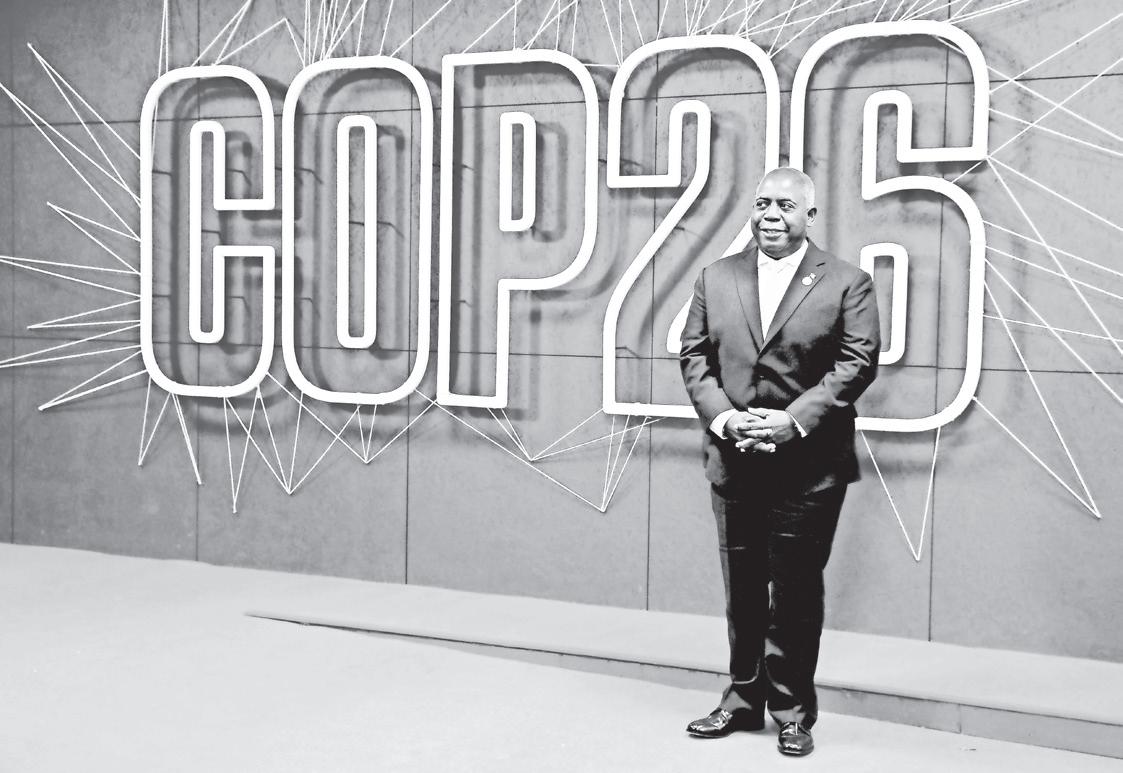
NOT only is The Bahamas a a global favourite for travellers – but it is also a favourite for astronauts.

The waters of our nation stand out as a landmark for spacefarers - and in 2015 astronaut Scott Kelly sent out a photograph of The Bahamas from space through his Twitter account.
He said in his tweet: “Had first video conference with my youngest daughter today. Showed her the most beautiful place from space. #Bahamas.”



He is not the only astronaut to cast admiring glances at The Bahamas from orbit – fellow astronaut Terry Virts also tweeted out pictures of The Bahamas the same year. In his message, he wrote: “South #Florida, #Cuba, #Bahamas. From my view, the most beautiful and colorful waters and reefs in the world.”
This wasn’t The Bahamas’ first encounter with astronauts, of course - and back in 1969, astronaust were greeted by Prime Minister Sir Lynden Pindling after their space module landed in the sea off Eleuthera - as reported in The Tribune.


